COVID-19 pandemic
The COVID‑19 pandemic, also known as the coronavirus pandemic, is an ongoing global pandemic of coronavirus disease 2019 (COVID‑19), caused by severe acute respiratory syndrome coronavirus 2 (SARS‑CoV‑2).[1] The outbreak was first identified in December 2019 in Wuhan, China.[4][6] The World Health Organization declared the outbreak a Public Health Emergency of International Concern on 30 January 2020 and a pandemic on 11 March.[7][8] As of 19 August 2020, more than 21.9 million cases of COVID‑19 have been reported in more than 188 countries and territories, resulting in more than 777,000 deaths; more than 13.9 million people have recovered.[5]
| COVID‑19 pandemic | |||||||
|---|---|---|---|---|---|---|---|
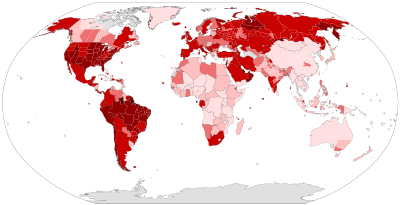 Confirmed cases per 100,000 population as of 18 August 2020
| |||||||
| |||||||
| |||||||
Clockwise, starting from top:
| |||||||
| Disease | Coronavirus disease 2019 (COVID‑19) | ||||||
| Virus strain | Severe acute respiratory syndrome coronavirus 2 (SARS‑CoV‑2)[lower-alpha 1] | ||||||
| Source | Probably bats, possibly via pangolins[2][3] | ||||||
| Location | Worldwide | ||||||
| First outbreak | China[4] | ||||||
| Index case | Wuhan, Hubei, China 30°37′11″N 114°15′28″E | ||||||
| Date | 1 December 2019[4]–present (8 months, 2 weeks and 4 days) | ||||||
| Confirmed cases | 21,991,954[5] | ||||||
| Active cases | 7,233,807[5] | ||||||
| Recovered | 13,981,129[5] | ||||||
Deaths | 777,018[5] | ||||||
Territories | 188[5] | ||||||
Common symptoms include fever, cough, fatigue, shortness of breath, and loss of sense of smell.[10][15][16] Complications may include pneumonia and acute respiratory distress syndrome.[17] The time from exposure to onset of symptoms is typically around five days but may range from two to fourteen days.[18][19] There are several vaccine candidates in development, although none have completed clinical trials to prove their safety and efficacy. There is no known specific antiviral medication,[10] so primary treatment is currently symptomatic.[20]
Recommended preventive measures include hand washing, covering one's mouth when coughing, maintaining distance from other people, wearing a face mask in public settings, disinfecting surfaces, increasing ventilation and air filtration indoors,[21] and monitoring and self-isolation for people who suspect they are infected.[10][22] Authorities worldwide have responded by implementing travel restrictions, lockdowns, workplace hazard controls, and facility closures in order to slow the spread of the disease. Many places have also worked to increase testing capacity and trace contacts of infected persons.
The pandemic has caused global social and economic disruption,[23] including the largest global recession since the Great Depression.[24] Up to 100 million people have fallen into extreme poverty[25][26][27] and global famines are affecting 265 million people.[28] It has led to the postponement or cancellation of sporting, religious, political, and cultural events,[29] widespread supply shortages exacerbated by panic buying,[30][31] and decreased emissions of pollutants and greenhouse gases.[32][33] Schools, universities, and colleges have been closed either on a nationwide or local basis in 161 countries, affecting approximately 98.6 percent of the world's student population.[34] Misinformation about the virus has circulated through social media and mass media.[35] There have been incidents of xenophobia and discrimination against Chinese people and against those perceived as being Chinese or as being from areas with high infection rates.[36]
Epidemiology
For country-level data, see: | |||
| COVID-19 pandemic by country and territory | |||
|---|---|---|---|
 | |||
|
|||
| As of 19 August 2020[5] | |||
Background
On 31 December 2019, the World Health Organization (WHO) received reports of a cluster of viral pneumonia cases of unknown cause in Wuhan, Hubei,[37][38] and an investigation was launched at the start of January 2020.[39] On 30 January, the WHO declared the outbreak a Public Health Emergency of International Concern (PHEIC)—7,818 cases confirmed globally, affecting 19 countries in five WHO regions.[40][7]
Several early infected people had visited Huanan Seafood Wholesale Market;[41] the virus is therefore thought to be of zoonotic origin.[42] The virus that caused the outbreak is known as SARS‑CoV‑2, a newly discovered virus closely related to bat coronaviruses,[43] pangolin coronaviruses,[44][45] and SARS-CoV.[46] The scientific consensus is that COVID-19 has a natural origin.[47][48] The probable bat-to-human infection may have been among people processing bat carcasses and guano in the production of traditional Chinese medicines.[49]
The earliest known person with symptoms was later discovered to have fallen ill on 1 December 2019, and that person did not have visible connections with the later wet market cluster.[50][51] Of the early cluster of cases reported that month, two-thirds were found to have a link with the market.[52][53][54] On 13 March 2020, an unverified report from the South China Morning Post suggested a case traced back to 17 November 2019 (a 55-year-old from Hubei) may have been the first person infected.[55][56]
The WHO recognised the spread of COVID-19 as a pandemic on 11 March 2020[8] as Italy, Iran, South Korea, and Japan reported surging numbers of cases. The number of cases outside China quickly surpassed the number of cases inside China.[57]

Cases
Official case counts refer to the number of people who have been tested for COVID-19 and whose test has been confirmed positive according to official protocols.[58][59] Many countries, early on, had official policies to not test those with only mild symptoms.[60][61] An analysis of the early phase of the outbreak up to 23 January estimated 86 percent of COVID-19 infections had not been detected, and that these undocumented infections were the source for 79 percent of documented cases.[62] Several other studies, using a variety of methods, have estimated that numbers of infections in many countries are likely to be considerably greater than the reported cases.[63][64]
On 9 April 2020, preliminary results found that 15 percent of people tested in Gangelt, the centre of a major infection cluster in Germany, tested positive for antibodies.[65] Screening for COVID-19 in pregnant women in New York City, and blood donors in the Netherlands, has also found rates of positive antibody tests that may indicate more infections than reported.[66][67] Seroprevalence based estimates are conservative as some studies shown that persons with mild symptoms do not have detectable antibodies.[68] Some results (such as the Gangelt study) have received substantial press coverage without first passing through peer review.[69]
Analysis by age in China indicates that a relatively low proportion of cases occur in individuals under 20.[70] It is not clear whether this is because young people are less likely to be infected, or less likely to develop serious symptoms and seek medical attention and be tested.[71] A retrospective cohort study in China found that children were as likely to be infected as adults.[72]
Initial estimates of the basic reproduction number (R0) for COVID-19 in January were between 1.4 and 2.5,[73] but a subsequent analysis concluded that it may be about 5.7 (with a 95 percent confidence interval of 3.8 to 8.9).[74] R0 can vary across populations and is not to be confused with the effective reproduction number (commonly just called R), which takes into account effects such as social distancing and herd immunity. By mid-May 2020, the effective R was close to or below 1.0 in many countries, meaning the spread of the disease in these areas at that time was stable or decreasing.[75]
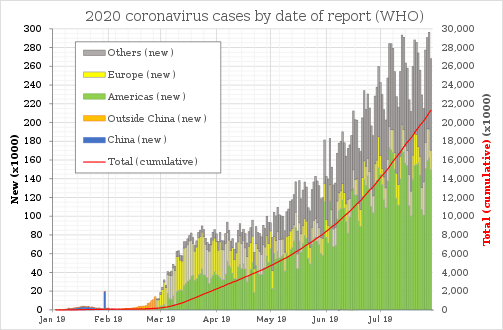 Epidemic curve of COVID-19 by date of report
Epidemic curve of COVID-19 by date of report Semi-log plot of daily new cases of COVID-19 (seven-day average) in the world and top five current countries (mean with deaths)
Semi-log plot of daily new cases of COVID-19 (seven-day average) in the world and top five current countries (mean with deaths)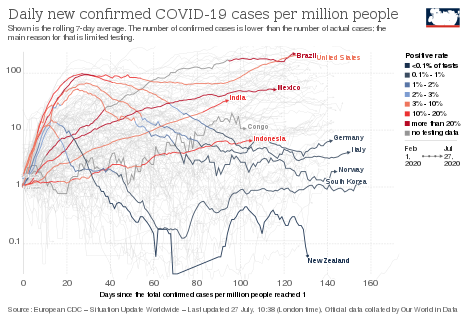 Daily confirmed cases by country per million people, plotted on a logarithmic scale
Daily confirmed cases by country per million people, plotted on a logarithmic scale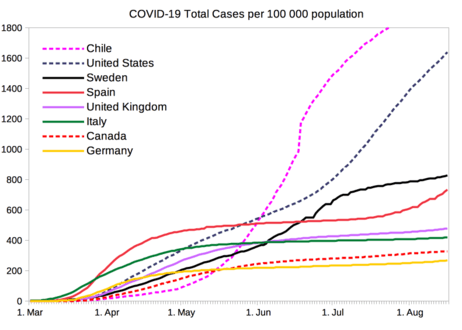 COVID-19 total cases per 100 000 population from selected countries[76]
COVID-19 total cases per 100 000 population from selected countries[76]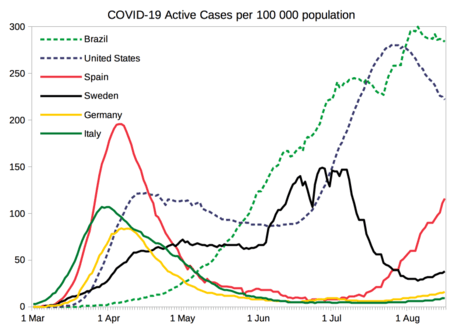 COVID-19 active cases per 100 000 population from selected countries[76]
COVID-19 active cases per 100 000 population from selected countries[76]
Deaths
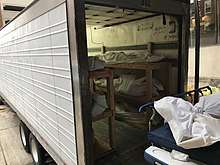
Most people who contract COVID-19 recover. For those who do not, the time between the onset of symptoms and death usually ranges from 6 to 41 days, typically about 14 days.[77] As of 19 August 2020, approximately 777,000[5] deaths had been attributed to COVID-19. In China, as of 14 June, about 80 percent of deaths were recorded in those aged over 60, and 75 percent had pre-existing health conditions including cardiovascular diseases and diabetes.[78] Individuals of any age with COPD, obesity, type 2 diabetes mellitus and other underlying health conditions are at increased risk of severe illness from COVID-19.[79][80]
The first confirmed death was in Wuhan on 9 January 2020.[81] The first death outside of China occurred on 1 February in the Philippines,[82] and the first death outside Asia was in France on 14 February.[83]
Official deaths from COVID-19 generally refer to people who died after testing positive according to protocols. This may ignore deaths of people who die without having been tested.[84] Conversely, deaths of people who had underlying conditions may lead to over-counting.[85] Comparison of statistics for deaths for all causes versus the seasonal average indicates excess mortality in many countries.[86][87] In the worst affected areas, mortality has been several times higher than average. In New York City, deaths have been four times higher than average, in Paris twice as high, and in many European countries, deaths have been on average 20 to 30 percent higher than normal.[86] This excess mortality may include deaths due to strained healthcare systems and bans on elective surgery.[88]
Multiple measures are used to quantify mortality.[89] These numbers vary by region and over time, influenced by testing volume, healthcare system quality, treatment options, government response,[90][91][92] time since the initial outbreak, and population characteristics, such as age, sex, and overall health.[93] Some countries (like Belgium) include deaths from suspected cases of COVID-19, regardless of whether the person was tested, resulting in higher numbers compared to countries that include only test-confirmed cases.[94]
The death-to-case ratio reflects the number of deaths attributed to COVID-19 divided by the number of diagnosed cases within a given time interval. Based on Johns Hopkins University statistics, the global death-to-case ratio is 3.5 percent (777,018 deaths for 21,991,954 cases) as of 19 August 2020.[5] The number varies by region.[95]
Other measures include the case fatality rate (CFR), which reflects the percentage of diagnosed people who die from a disease, and the infection fatality rate (IFR), which reflects the percentage of infected (diagnosed and undiagnosed) who die from a disease. These statistics are not timebound and follow a specific population from infection through case resolution. Our World in Data states that as of 25 March 2020 the IFR cannot be accurately calculated as neither the total number of cases nor the total deaths, is known.[93] In February the Institute for Disease Modeling estimated the IFR as 0.94 percent (95-percent confidence interval 0.37–2.9), based on data from China.[96][97] The University of Oxford's Centre for Evidence-Based Medicine (CEBM) estimated a global CFR of 0.8 to 9.6 percent (last revised 30 April) and IFR of 0.10 percent to 0.41 percent (last revised 2 May), acknowledging that this will vary between populations due to differences in demographics.[98] The CDC estimates for planning purposes that the fatality rate among those who are symptomatic is 1.1 percent and that 40 percent of infected individuals are asymptomatic, for an overall infection fatality rate of 0.65 percent (0.5 to 0.8 percent).[99][100]
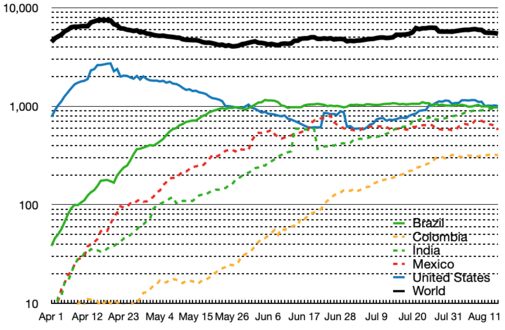 Semi-log plot of daily deaths due to COVID-19 (seven-day average) in the world and top five current countries (mean with cases)
Semi-log plot of daily deaths due to COVID-19 (seven-day average) in the world and top five current countries (mean with cases) Case fatality rate of COVID-19 by country and confirmed cases
Case fatality rate of COVID-19 by country and confirmed cases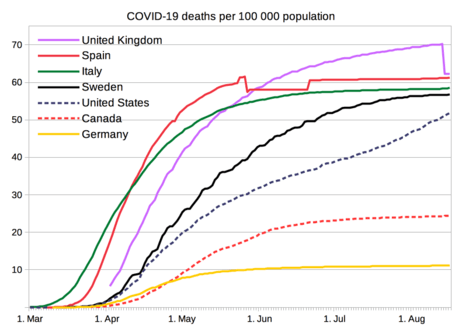 COVID-19 deaths per 100 000 population from selected countries[101]
COVID-19 deaths per 100 000 population from selected countries[101]
Duration
On 11 March 2020, the WHO said the pandemic could be controlled.[8] The peak and ultimate duration of the outbreak are uncertain and may differ by location. Maciej Boni of Penn State University said, "Left unchecked, infectious outbreaks typically plateau and then start to decline when the disease runs out of available hosts. But it's almost impossible to make any sensible projection right now about when that will be."[102] The Imperial College study led by Neil Ferguson stated that physical distancing and other measures will be required "until a vaccine becomes available (potentially 18 months or more)".[103] William Schaffner of Vanderbilt University said because the coronavirus is "so readily transmissible", it "might turn into a seasonal disease, making a comeback every year". The virulence of the comeback would depend on herd immunity and the extent of mutation.[104]
Signs and symptoms

The usual incubation period (the time between infection and symptom onset) ranges from one to 14 days, and is most commonly five days.[10][106] Some infected people have no symptoms, known as asymptomatic or presymptomatic carriers; transmission from such a carrier is considered possible.[107] As at 6 April, estimates of the asymptomatic ratio range widely from 5 to 80 percent.[108]
Symptoms of COVID-19 can be relatively non-specific; the two most common symptoms are fever (88 percent) and dry cough (68 percent). Less common symptoms include fatigue, respiratory sputum production (phlegm), loss of the sense of smell, loss of taste, shortness of breath, muscle and joint pain, sore throat, headache, chills, vomiting, coughing out blood, diarrhea, and rash.[109][17][16]
Among those who develop symptoms, approximately one in five may become more seriously ill and have difficulty breathing.[10] Emergency symptoms include difficulty breathing, persistent chest pain or pressure, sudden confusion, difficulty waking, and bluish face or lips; immediate medical attention is advised if these symptoms are present.[16] Further development of the disease can lead to complications including pneumonia, acute respiratory distress syndrome, sepsis, septic shock, and kidney failure.[17]
Cause
Transmission
COVID‑19 is a new disease, and many of the details of its spread are still under investigation.[10][11][12] It spreads easily between people—more easily than influenza but not as easily as measles.[11] People are most infectious when they show symptoms (even mild or non-specific symptoms), but may be infectious for up to two days before symptoms appear (pre-symptomatic transmission).[12] They remain infectious for an estimated seven to twelve days in moderate cases and an average of two weeks in severe cases.[12] People can also transmit the virus without showing any symptom (asymptomatic transmission), but it is unclear how often this happens.[10][11][12] A June 2020 review found that 40–45% of infected people are asymptomatic.[110]
COVID‑19 spreads primarily when people are in close contact and one person inhales small droplets produced by an infected person (symptomatic or not) coughing, sneezing, talking, or singing.[12][111] The WHO recommends 1 metre (3 ft) of social distance;[10] the US Centers for Disease Control and Prevention (CDC) recommends 2 metres (6 ft).[11]
Transmission may also occur through aerosols, smaller droplets that are able to stay suspended in the air for longer periods of time.[14] Experimental results show the virus can survive in aerosol for up to three hours.[112] Some outbreaks have also been reported in crowded and inadequately ventilated indoor locations where infected persons spend long periods of time (such as restaurants and nightclubs).[113] Aerosol transmission in such locations has not been ruled out.[14] Some medical procedures performed on COVID‑19 patients in health facilities can generate those smaller droplets,[114] and result in the virus being transmitted more easily than normal.[10][12]
Less commonly, when the contaminated droplets fall to floors or surfaces they can remain infectious if people touch contaminated surfaces and then their eyes, nose or mouth with unwashed hands.[10] On surfaces the amount of viable active virus decreases over time until it can no longer cause infection,[12] and surfaces are thought not to be the main way the virus spreads.[11] The level of contamination required to transmit infection via surfaces is unknown, but the virus can be detected for up to four hours on copper, up to one day on cardboard, and up to three days on plastic (polypropylene) and stainless steel (AISI 304).[12][115][116] Surfaces are easily decontaminated with household disinfectants which destroy the virus outside the human body or on the hands.[10] Disinfectants or bleach are not a treatment for COVID‑19, and cause health problems when not used properly, such as when used inside the human body.[117]
Sputum and saliva carry large amounts of virus.[10][11][12][118] Although COVID‑19 is not a sexually transmitted infection, direct contact such as kissing, intimate contact, and fecal–oral routes are suspected to transmit the virus.[119][120] The virus may occur in breast milk, but whether it is transmittable to the baby is unknown.[121][122]
Estimates of the number of people infected by one person with COVID‑19, the R0, have varied. The WHO's initial estimates of R0 were 1.4–2.5 (average 1.95); however, a review in early April 2020 found the basic R0 (without control measures) to be higher at 3.28 and the median R0 to be 2.79.[123]Virology
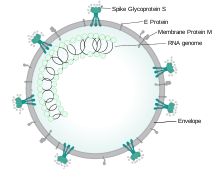
Severe acute respiratory syndrome coronavirus 2 (SARS‑CoV‑2) is a novel virus, first isolated from three people with pneumonia connected to the cluster of acute respiratory illness cases in Wuhan.[46] All features of the novel SARS‑CoV‑2 virus occur in related coronaviruses in nature.[124]
SARS‑CoV‑2 is closely related to SARS‑CoV, and is thought to have a zoonotic origin.[43] SARS‑CoV‑2 genetically clusters with the genus Betacoronavirus, and is 96 percent identical at the whole genome level to other bat coronavirus samples[125] and 92 percent identical to pangolin coronavirus.[126]
Diagnosis
.jpg)
COVID-19 can provisionally be diagnosed on the basis of symptoms and confirmed using reverse transcription polymerase chain reaction (RT-PCR) testing of infected secretions or CT imaging of the chest.[127][128]
Viral testing
The standard test for current infection with SARS-CoV-2 uses RNA testing of respiratory secretions collected using a nasopharyngeal swab, though it is possible to test other samples. This test uses real-time rRT-PCR which detects the presence of viral RNA fragments.[129]
A number of laboratories and companies have developed serological tests, which detect antibodies produced by the body in response to infection.[130] Several have been evaluated by Public Health England and approved for use in the UK.[131]
On 22 June 2020, UK health secretary Matt Hancock announced the country would conduct a new "spit test" for COVID-19 on 14,000 key workers and their families in Southampton, having them spit in a pot, which was collected by Southampton University, with results expected within 48 hours. Hancock said the test was easier than using swabs, and could enable people to conduct it at home.[132]
Imaging
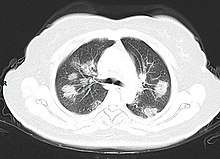
Characteristic imaging features on chest radiographs and computed tomography (CT) of people who are symptomatic include asymmetric peripheral ground-glass opacities without pleural effusions.[133] Many groups have created COVID-19 datasets that include imagery such as the Italian Radiological Society which has compiled an international online database of imaging findings for confirmed cases.[134] Due to overlap with other infections such as adenovirus, imaging without confirmation by rRT-PCR is of limited specificity in identifying COVID-19.[133] A large study in China compared chest CT results to PCR and demonstrated that though imaging is less specific for the infection, it is faster and more sensitive.[128]
Prevention
.pdf.jpg)
Strategies for preventing transmission of the disease include maintaining overall good personal hygiene, washing hands, avoiding touching the eyes, nose, or mouth with unwashed hands, and coughing or sneezing into a tissue, and putting the tissue directly into a waste container. Those who may already have the infection have been advised to wear a surgical mask in public.[135][136] Physical distancing measures are also recommended to prevent transmission.[137][138] Health care providers taking care of someone who may be infected are recommended to use standard precautions, contact precautions, and eye protection.[139][140]
Many governments have restricted or advised against all non-essential travel to and from areas affected by the outbreak.[141] The virus has already spread within communities in large parts of the world, with many not knowing where or how they were infected.[142]
Misconceptions are circulating about how to prevent infection; for example, rinsing the nose and gargling with mouthwash are not effective.[143] There is no COVID-19 vaccine, though many organisations are working to develop one.[144]
Hand washing
Hand washing is recommended to prevent the spread of the disease. The CDC recommends that people wash hands often with soap and water for at least twenty seconds, especially after going to the toilet or when hands are visibly dirty; before eating; and after blowing one's nose, coughing, or sneezing. This is because outside the human body, the virus is killed by household soap, which bursts its protective bubble.[22] In addition, soap and water disrupts the sticky bond between pathogens and human skin which causes the coronavirus pathogen to slide off the hands/body.[145] CDC has recommended using an alcohol-based hand sanitiser with at least 60 percent alcohol by volume when soap and water are not readily available.[135] The WHO advises people to avoid touching the eyes, nose, or mouth with unwashed hands.[136][146] It is not clear whether washing hands with ash, if soap is not available, is effective at reducing the spread of viral infections.[147]
Social distancing

Social distancing (also known as physical distancing) includes infection control actions intended to slow the spread of disease by minimising close contact between individuals. Methods include quarantines; travel restrictions; and the closing of schools, workplaces, stadiums, theatres, or shopping centres. Individuals may apply social distancing methods by staying at home, limiting travel, avoiding crowded areas, using no-contact greetings, and physically distancing themselves from others.[136][148][149] Many governments are now mandating or recommending social distancing in regions affected by the outbreak.[150][151] Non-cooperation with distancing measures in some areas has contributed to the further spread of the pandemic.[152]
The maximum gathering size recommended by U.S. government bodies and health organisations was swiftly reduced from 250 people (if there were no known COVID-19 spread in a region) to 50 people, and later to 10.[153] On 22 March 2020, Germany banned public gatherings of more than two people.[154] A Cochrane review found that early quarantine with other public health measures are effective in limiting the pandemic, but the best manner of adopting and relaxing policies are uncertain, as local conditions vary.[149]
Older adults and those with underlying medical conditions such as diabetes, heart disease, respiratory disease, hypertension, and compromised immune systems face increased risk of serious illness and complications and have been advised by the CDC to stay home as much as possible in areas of community outbreak.[155][156]
In late March 2020, the WHO and other health bodies began to replace the use of the term "social distancing" with "physical distancing", to clarify that the aim is to reduce physical contact while maintaining social connections, either virtually or at a distance. The use of the term "social distancing" had led to implications that people should engage in complete social isolation, rather than encouraging them to stay in contact through alternative means.[157][158] Some authorities have issued sexual health guidelines for the pandemic, which include recommendations to have sex only with someone you live with, and who does not have the virus or symptoms of the virus.[159][160]
Face masks and respiratory hygiene

The CDC and WHO recommend individuals wear non-medical face coverings in public settings where there is an increased risk of transmission and where social distancing measures are difficult to maintain.[161][162][163] This recommendation is meant to reduce the spread of the disease by asymptomatic and pre-symtomatic individuals and is complementary to established preventive measures such as social distancing.[162][164] Face coverings limit the volume and travel distance of expiratory droplets dispersed when talking, breathing, and coughing.[162][164] Many countries and local jurisdictions encourage or mandate the use of face masks or cloth face coverings by members of the public to limit the spread of the virus.[165][166]
Masks are also strongly recommended for those who may have been infected and those taking care of someone who may have the disease.[167] When not wearing a mask, the CDC recommends covering the mouth and nose with a tissue when coughing or sneezing and recommends using the inside of the elbow if no tissue is available.[135] Proper hand hygiene after any cough or sneeze is encouraged.[135] Healthcare professionals interacting directly with COVID-19 patients are advised to use respirators at least as protective as NIOSH-certified N95 or equivalent, in addition to other personal protective equipment.[168]
Self-isolation

Self-isolation at home has been recommended for those diagnosed with COVID-19 and those who suspect they have been infected. Health agencies have issued detailed instructions for proper self-isolation.[170][171]
Many governments have mandated or recommended self-quarantine for entire populations.[172][173] The strongest self-quarantine instructions have been issued to those in high risk groups.[174] Those who may have been exposed to someone with COVID-19 and those who have recently travelled to a country or region with the widespread transmission have been advised to self-quarantine for 14 days from the time of last possible exposure.[10][18][175]
Surface cleaning
Surfaces may be decontaminated with a number of solutions (within one minute of exposure to the disinfectant for a stainless steel surface), including 62–71 percent ethanol, 50–100 percent isopropanol, 0.1 percent sodium hypochlorite, 0.5 percent hydrogen peroxide, and 0.2–7.5 percent povidone-iodine. Other solutions, such as benzalkonium chloride and chlorhexidine gluconate, are less effective.[176] Ultraviolet germicidal irradiation may also be used.[21] The CDC recommends that if a COVID-19 case is suspected or confirmed at a facility such as an office or day care, all areas such as offices, bathrooms, common areas, shared electronic equipment like tablets, touch screens, keyboards, remote controls, and ATM machines used by the ill persons should be disinfected.[177]
Ventilation and air filtration
The CDC recommends ventilation in public spaces to help clear out infectious aerosols, as well several others, including those regarding air filtration,[21][178] however doctors have been cautious about recommending air filtration due to the potentially very small size of virus particles. Some filters are labelled to remove viruses to the 5-micron level, but there are fears that some virus particles may be even smaller.[179] Some experts have recommended UV light inside HVAC systems.[180]
Vaccine
Management
Screening, containment and mitigation
.gif)
Strategies in the control of an outbreak are screening, containment (or suppression) and mitigation. Screening is done with a device such as a thermometer to detect the elevated body temperature associated with fevers caused by the coronavirus.[188] Containment is undertaken in the early stages of the outbreak and aims to trace and isolate those infected as well as introduce other measures to stop the disease from spreading. When it is no longer possible to contain the disease, efforts then move to the mitigation stage: measures are taken to slow the spread and mitigate its effects on the healthcare system and on society. A combination of both containment and mitigation measures may be undertaken at the same time.[189] Suppression requires more extreme measures so as to reverse the pandemic by reducing the basic reproduction number to less than 1.[103]
Part of managing an infectious disease outbreak is trying to delay and decrease the epidemic peak, known as flattening the epidemic curve.[184] This decreases the risk of health services being overwhelmed and provides more time for vaccines and treatments to be developed.[184] Non-pharmaceutical interventions that may manage the outbreak include personal preventive measures such as hand hygiene, wearing face masks, and self-quarantine; community measures aimed at physical distancing such as closing schools and cancelling mass gathering events; community engagement to encourage acceptance and participation in such interventions; as well as environmental measures such surface cleaning.[190]
More drastic actions aimed at containing the outbreak were taken in China once the severity of the outbreak became apparent, such as quarantining entire cities and imposing strict travel bans.[191] Other countries also adopted a variety of measures aimed at limiting the spread of the virus. South Korea introduced the mass screening and localised quarantines and issued alerts on the movements of infected individuals. Singapore provided financial support for those infected who quarantined themselves and imposed large fines for those who failed to do so. Taiwan increased face mask production and penalised hoarding of medical supplies.[192]
Simulations for Great Britain and the United States show that mitigation (slowing but not stopping epidemic spread) and suppression (reversing epidemic growth) have major challenges. Optimal mitigation policies might reduce peak healthcare demand by two-thirds and deaths by half, but still result in hundreds of thousands of deaths and overwhelmed health systems. Suppression can be preferred but needs to be maintained for as long as the virus is circulating in the human population (or until a vaccine becomes available), as transmission otherwise quickly rebounds when measures are relaxed. Long-term intervention to suppress the pandemic has considerable social and economic costs.[103]
Contact tracing
Contact tracing is an important method for health authorities to determine the source of infection and to prevent further transmission.[193] The use of location data from mobile phones by governments for this purpose has prompted privacy concerns, with Amnesty International and more than a hundred other organisations issuing a statement calling for limits on this kind of surveillance.[194]
Several mobile apps have been implemented or proposed for voluntary use, and as of 7 April 2020 more than a dozen expert groups were working on privacy-friendly solutions such as using Bluetooth to log a user's proximity to other cellphones.[194] (Users are alerted if they have been near someone who subsequently tests positive.)[194]
On 10 April 2020, Google and Apple jointly announced an initiative for privacy-preserving contact tracing based on Bluetooth technology and cryptography.[195][196] The system is intended to allow governments to create official privacy-preserving coronavirus tracking apps, with the eventual goal of integration of this functionality directly into the iOS and Android mobile platforms.[197] In Europe and in the U.S., Palantir Technologies is also providing COVID-19 tracking services.[198]
Health care
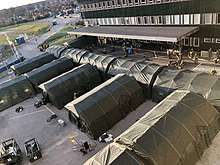
Increasing capacity and adapting healthcare for the needs of COVID-19 patients is described by the WHO as a fundamental outbreak response measure.[199] The ECDC and the European regional office of the WHO have issued guidelines for hospitals and primary healthcare services for shifting of resources at multiple levels, including focusing laboratory services towards COVID-19 testing, cancelling elective procedures whenever possible, separating and isolating COVID-19 positive patients, and increasing intensive care capabilities by training personnel and increasing the number of available ventilators and beds.[199][200] In addition, in an attempt to maintain physical distancing, and to protect both patients and clinicians, in some areas non-emergency healthcare services are being provided virtually.[201][202][203]
Due to capacity limitations in the standard supply chains, some manufacturers are 3D printing healthcare material such as nasal swabs and ventilator parts.[204][205] In one example, when an Italian hospital urgently required a ventilator valve, and the supplier was unable to deliver in the timescale required, a local startup received legal threats due to alleged patent infringement after reverse-engineering and printing the required hundred valves overnight.[206][207][208] On 23 April 2020, NASA reported building, in 37 days, a ventilator which is currently undergoing further testing. NASA is seeking fast-track approval.[209][210]
Treatment

Antiviral medications are under investigation for COVID-19, though none have yet been shown to be clearly effective on mortality in published randomised controlled trials.[211] However, remdesivir may affect the time it takes to recover from the virus.[212] Emergency use authorisation for remdesivir was granted in the U.S. on 1 May, for people hospitalised with severe COVID-19.[213] The interim authorisation was granted considering the lack of other specific treatments, and that its potential benefits appear to outweigh the potential risks.[213][214]
Taking over-the-counter cold medications,[215] drinking fluids, and resting may help alleviate symptoms.[135] Depending on the severity, oxygen therapy, intravenous fluids, and breathing support may be required.[216] The safety and effectiveness of convalescent plasma as a treatment option requires further research.[217]
Other trials are investigating whether existing medications can be used effectively against COVID-19 or the immune reaction to it.[211][218] On 16 June, the RECOVERY Trial group released a statement that their preliminary results show low dose dexamethasone reduces mortality in patients receiving respiratory support,[219] though previous reviews had suggested the use of steroids may worsen outcomes.[220] Demand for dexamethasone surged after publication of the preprint.[221]
A study of major hospitals in the U.S. determined that abnormal liver tests were occurring in most hospitalized patients with COVID‐19 and may be associated with poorer clinical outcomes.[222] Several medications used in the treatments during the study were found to be associated with peak hospitalization liver transaminase elevations >5x ULN. Tocilizumab was significantly associated in the relationship between the drugs used to treat the disease and abnormal liver tests, which has prompted studies being conducted to determine whether the abnormal tests were due to the disease or drug-induced liver injury, according to Michael Nathanson, director of the Yale Liver Center and co-author of the study.[223]
History
There are several theories about when and where the very first case (the so-called patient zero) originated.[224] According to an unpublicised report from the Chinese government, the first case can be traced back to 17 November 2019; the person was a 55-year-old citizen in the Hubei province.[55] There were four men and five women reported to be infected in November, but none of them were "patient zero."[55] Starting from December, the number of coronavirus cases in Hubei gradually increased, reaching 60 by 20 December[225] and at least 266 by 31 December.[226]
According to official Chinese sources, these early cases were mostly linked to the Huanan Seafood Wholesale Market, which also sold live animals.[42] However, in May 2020, George Gao, the director of the Chinese Center for Disease Control and Prevention, said animal samples collected from the seafood market had tested negative for the virus, indicating the market was not the source of the initial outbreak.[227]
On 24 December, Wuhan Central Hospital sent a bronchoalveolar lavage fluid (BAL) sample from an unresolved clinical case to sequencing company Vision Medicals. On 27 and 28 December, Vision Medicals informed the Wuhan Central Hospital and the Chinese CDC of the results of the test, showing a new coronavirus.[228] A pneumonia cluster of unknown cause was observed on 26 December and treated by the doctor Zhang Jixian in Hubei Provincial Hospital, who informed the Wuhan Jianghan CDC on 27 December.[229]
On 30 December 2019, a test report addressed to Wuhan Central Hospital, from company CapitalBio Medlab, stated that there was an erroneous positive result for SARS, causing a group of doctors at Wuhan Central Hospital to alert their colleagues and relevant hospital authorities of the result. Eight of those doctors, including Li Wenliang (who was also punished on 3 January),[230] were later admonished by the police for spreading false rumours; and another doctor, Ai Fen, was reprimanded by her superiors for raising the alarm.[231] That evening, the Wuhan Municipal Health Commission issued a notice to various medical institutions about "the treatment of pneumonia of unknown cause".[232] The next day, the Wuhan Municipal Health Commission made the first public announcement of a pneumonia outbreak of unknown cause, confirming 27 cases[37][233][234]—enough to trigger an investigation.[39]
2020
During the early stages of the outbreak, the number of cases doubled approximately every seven and a half days.[235] In early and mid-January 2020, the virus spread to other Chinese provinces, helped by the Chinese New Year migration and Wuhan being a transport hub and major rail interchange.[125] On 20 January, China reported nearly 140 new cases in one day, including two people in Beijing and one in Shenzhen.[236] A retrospective official study published in March found that 6,174 people had already developed symptoms by 20 January (most of them would be diagnosed later)[237] and more may have been infected.[238] A report in The Lancet on 24 January indicated human transmission, strongly recommended personal protective equipment for health workers, and said testing for the virus was essential due to its "pandemic potential".[52][239] On 30 January, the WHO declared the coronavirus a public health emergency of international concern.[238]
On 31 January 2020, Italy had its first confirmed cases, two tourists from China.[240] As of 13 March 2020, the WHO considered Europe the active centre of the pandemic.[241] On 19 March 2020, Italy overtook China as the country with the most reported deaths.[242] By 26 March, the United States had overtaken China and Italy with the highest number of confirmed cases in the world.[243] Research on coronavirus genomes indicates the majority of COVID-19 cases in New York came from European travellers, rather than directly from China or any other Asian country.[244] Retesting of prior samples found a person in France who had the virus on 27 December 2019[245][246] and a person in the United States who died from the disease on 6 February 2020.[247]
On 11 June 2020, after 55 days without a locally transmitted case being officially reported,[248] the city of Beijing reported a single COVID-19 case, followed by two more cases on 12 June.[249] As for 15 June 79 cases were officially confirmed.[250] Most of these patients went to Xinfadi Wholesale Market.[248][251]
On 29 June 2020, WHO warned that the spread of the virus is still accelerating as countries reopen their economies, although many countries have made progress in slowing down the spread.[252]
On 15 July 2020, one COVID-19 case was officially reported in Dalian in more than three months.[253] The patient did not travel outside the city in the 14 days before developing symptoms, nor did he have contact with people from "areas of attention."[253]
As of 19 August 2020, more than 21.9 million cases have been reported worldwide; more than 777,000 people have died and more than 13.9 million have recovered.[254][255]
National responses
A total of 188[5] countries and territories have had at least one case of COVID-19 so far. Due to the pandemic in Europe, many countries in the Schengen Area have restricted free movement and set up border controls.[256] National reactions have included containment measures such as quarantines and curfews (known as stay-at-home orders, shelter-in-place orders, or lockdowns).[257]
By 26 March, 1.7 billion people worldwide were under some form of lockdown,[258] which increased to 3.9 billion people by the first week of April—more than half the world's population.[259][260]
By late April, around 300 million people were under lockdown in nations of Europe, including but not limited to Italy, Spain, France, and the United Kingdom, while around 200 million people were under lockdown in Latin America.[261] Nearly 300 million people, or about 90 percent of the population, were under some form of lockdown in the United States,[262] around 100 million people in the Philippines,[261] about 59 million people in South Africa,[263] and 1.3 billion people have been under lockdown in India.[264][265] On 21 May 100,000 new infections occurred worldwide, the most since the start of the pandemic, while overall 5 million cases were surpassed.[266]
Asia
As of 19 May 2020, cases have been reported in all Asian countries except for Turkmenistan and North Korea, although these countries likely also have cases.[267][268] Despite being the first area of the world hit by the outbreak, the early wide-scale response of some Asian states, particularly Mongolia,[269] South Korea,[270] Taiwan,[271] and Vietnam,[272] has allowed them to fare comparatively well.
China
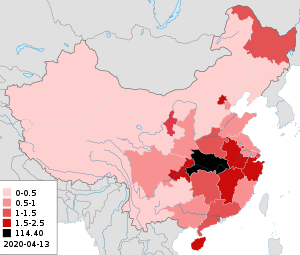
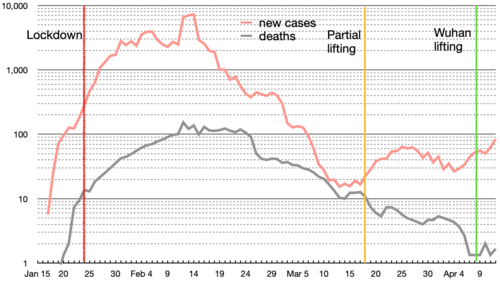
The first confirmed case of COVID-19 has been traced back to 1 December 2019 in Wuhan;[50] initial genetic testing of patient samples on 27 December 2019 indicated the presence of a SARS-like coronavirus.[273] A public notice was released by Wuhan Municipal Health Commission on 31 December, confirming 27 cases, and WHO investigated the outbreak on 1 January 2020.[234][37] As these notifications occurred, doctors in Wuhan were warned by police for "spreading rumours" about the outbreak.[274] The Chinese National Health Commission initially said there was no "clear evidence" of human-to-human transmission,[275] but privately Chinese officials said on 14 January that human-to-human transmission was a possibility, and pandemic preparations were needed.[276]
On 20 January, the Chinese National Health Commission confirmed human-to-human transmission of the virus.[277] That same day, Chinese Communist Party general secretary Xi Jinping and State Council premier Li Keqiang issued their first public comments about the virus, telling people in infected areas to practice social distancing and avoid travel.[278][279] During the Chinese New Year (25 January) travel period, authorities instigated a City of Wuhan lockdown.[280] On 10 February the Chinese government launched a radical campaign described by paramount leader and Chinese Communist Party general secretary Xi as a "people's war" to contain the viral spread.[281] In "the largest quarantine in human history",[282] a cordon sanitaire on 23 January stopped travel in and out of Wuhan,[283][284] then extended to fifteen Hubei cities affecting about 57 million people.[285] Private vehicle use was banned in the city.[286] Several Chinese New Year (25 January) celebrations were also cancelled.[287] Authorities announced the construction of temporary hospitals, Huoshenshan Hospital, which was completed in ten days,[288] and Leishenshan Hospital,[289] while other facilities in Wuhan were also converted into temporary hospitals.[290]
.jpg)
A further series of measures were instituted by the authorities in late February to contain the COVID-19 outbreak, including issuing health declarations for travellers and extending the Spring Festival holiday,[292] travel restrictions,[293] and closure of museums, universities and schools around the country.[294][295][296] The regions of Hong Kong and Macau instituted several measures, particularly in regard to schools and universities.[297] Control of public movement was applied in many cities, and an estimated 760 million people (more than half the population) faced some form of outdoor restriction.[298] In January and February 2020, during the height of the epidemic in Wuhan, about 5 million people lost their jobs.[299] Many of China's nearly 300 million rural migrant workers have been stranded at home in inland provinces or trapped in Hubei province.[300][301]
After the outbreak entered its global phase in March, Chinese authorities took strict measures to prevent the virus re-entering China from other countries. For example, Beijing imposed a 14-day mandatory quarantine for all international travellers entering the city.[302] On 24 March, Chinese Premier Li Keqiang reported that the spread of domestically transmitted cases has been basically blocked and the outbreak has been controlled in China.[303] The same day travel restrictions were eased in Hubei, apart from Wuhan, two months after the lockdown was imposed.[304] The Chinese Ministry of Foreign Affairs announced on 26 March that entry for visa or residence permit holders would be suspended from 28 March onwards, and those wishing to enter China must apply for visas in Chinese embassies or consulates.[305][306] The Chinese government encouraged businesses and factories to re-open on 30 March, and provided monetary stimulus packages for firms.[307]
The State Council declared a day of mourning to begin with a national three-minute moment of silence on 4 April, coinciding with the Qingming Festival.[308] On 25 April, the last patients were discharged in Wuhan.[309] Local lockdowns, however, were later implemented to control sporadic outbreaks of the disease, for example in the city of Jilin in May, and parts of Beijing in June.[310][311]
India

The first case of COVID-19 in India originated from China and was reported on 30 January 2020. India ordered a nationwide lockdown for the entire population starting 24 March,[312] with a phased unlock beginning 1 June. Six cities account for around half of all reported cases in the country—Mumbai, Delhi, Ahmedabad, Chennai, Pune and Kolkata.[313]
As of May 2020, India had the largest number of confirmed cases in Asia;[314] as of June 2020, behind the United States and Brazil, India has the third highest number of confirmed cases in the world,[315] with the number of total confirmed cases breaching the 100,000 mark on 19 May,[316] 200,000 on 3 June,[317] and 1,000,000 confirmed cases on 17 July 2020.
On 10 June, India's recoveries exceeded active cases for the first time.[318] As of 6 July, India's case fatality rate is relatively low at 2.8%, against the global 4.7%.[319]
Iran
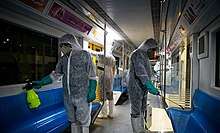
Iran reported its first confirmed cases of SARS‑CoV‑2 infections on 19 February in Qom, where, according to the Ministry of Health and Medical Education, two people had died that day.[321][322] Early measures announced by the government included the cancellation of concerts and other cultural events,[323] sporting events,[324] Friday prayers,[325] and closures of universities, higher education institutions, and schools.[326] Iran allocated 5 trillion rials (equivalent to US$120,000,000) to combat the virus.[327] President Hassan Rouhani said on 26 February there were no plans to quarantine areas affected by the outbreak, and only individuals would be quarantined.[328] Plans to limit travel between cities were announced in March,[329] although heavy traffic between cities ahead of the Persian New Year Nowruz continued.[330] Shia shrines in Qom remained open to pilgrims until 16 March.[331][332]
Iran became a centre of the spread of the virus after China during February.[333][334] More than ten countries had traced their cases back to Iran by 28 February, indicating the outbreak may have been more severe than the 388 cases reported by the Iranian government by that date.[334][335] The Iranian Parliament was shut down, with 23 of its 290 members reported to have had tested positive for the virus on 3 March.[336] On 15 March, the Iranian government reported a hundred deaths in a single day, the most recorded in the country since the outbreak began.[337] At least twelve sitting or former Iranian politicians and government officials had died from the disease by 17 March.[338] By 23 March, Iran was experiencing fifty new cases every hour and one new death every ten minutes due to coronavirus.[339] According to a WHO official, there may be five times more cases in Iran than what is being reported. It is also suggested that U.S. sanctions on Iran may be affecting the country's financial ability to respond to the viral outbreak.[340] On 20 April, Iran reopened shopping malls and other shopping areas across the country.[341] After reaching a low in new cases in early May, a new peak was reported on 4 June, raising fear of a second wave.[342] On 18 July, President Rouhani estimated that 25 million Iranians had already become infected, which is considerably higher than the official count.[343] Leaked data suggest that 42,000 people had died with COVID-19 symptoms by 20 July, nearly tripling the 14,405 officially reported by that date.[344]
South Korea

COVID-19 was confirmed to have spread to South Korea on 20 January 2020 from China. The nation's health agency reported a significant increase in confirmed cases on 20 February,[345] largely attributed to a gathering in Daegu of the Shincheonji Church of Jesus.[345][346] Shincheonji devotees visiting Daegu from Wuhan were suspected to be the origin of the outbreak.[347][348] By 22 February, among 9,336 followers of the church, 1,261 or about 13 percent reported symptoms.[349] South Korea declared the highest level of alert on 23 February 2020.[350] On 29 February, more than 3,150 confirmed cases were reported.[351] All South Korean military bases were quarantined after tests showed three soldiers had the virus.[347] Airline schedules were also changed.[352][353]
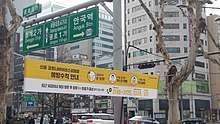
South Korea introduced what was considered the largest and best-organised programme in the world to screen the population for the virus, isolate any infected people, and trace and quarantine those who contacted them.[270][354] Screening methods included mandatory self-reporting of symptoms by new international arrivals through mobile application,[355] drive-through testing for the virus with the results available the next day,[356] and increasing testing capability to allow up to 20,000 people to be tested every day.[357] Despite some early criticisms of President Moon Jae-in's response to the crisis,[358] South Korea's programme is considered a success in controlling the outbreak without quarantining entire cities.[270][359][360]
On 23 March, it was reported that South Korea had the lowest one-day case total in four weeks.[357] On 29 March it was reported that beginning 1 April all new overseas arrivals will be quarantined for two weeks.[361] Per media reports on 1 April, South Korea has received requests for virus testing assistance from 121 different countries.[362] Persistent local groups of infections in the greater Seoul area continued to be found, which led to Korea's CDC director saying in June that the country had entered a second wave of infections,[363] although a WHO official disagreed with that assessment.[364]
Europe
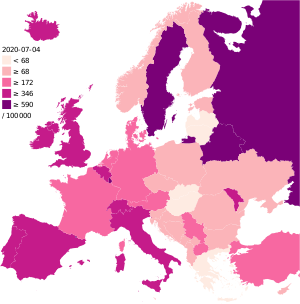
As of 13 March 2020, when the number of new cases became greater than those in China, the World Health Organization (WHO) began to consider Europe the active centre of the pandemic.[365][366] Cases by country across Europe had doubled over periods of typically 3 to 4 days, with some countries (mostly those at earlier stages of detection) showing doubling every 2 days.[367]
As of 17 March, all countries within Europe had a confirmed case of COVID-19, with Montenegro being the last European country to report at least one case.[368] At least one death has been reported in all European countries, apart from the Vatican City.
As of 18 March, more than 250 million people were in lockdown in Europe.[369]
As of 24 May, 68 days since its first recorded case, Montenegro became the first COVID-19-free country in Europe,[370][371] but this situation lasted only 44 days before a newly imported case was identified there.[372]France
Although it was originally thought the pandemic reached France on 24 January 2020, when the first COVID-19 case in Europe was confirmed in Bordeaux, it was later discovered that a person near Paris had tested positive for the virus on 27 December 2019 after retesting old samples.[245][246] A key event in the spread of the disease in the country was the annual assembly of the Christian Open Door Church between 17 and 24 February in Mulhouse, which was attended by about 2,500 people, at least half of whom are believed to have contracted the virus.[373][374]
On 13 March, Prime Minister Édouard Philippe ordered the closure of all non-essential public places,[375] and on 16 March, French President Emmanuel Macron announced mandatory home confinement, a policy which was extended at least until 11 May.[376][377][378] As of 23 April, France has reported more than 120,804 confirmed cases, 21,856 deaths, and 42,088 recoveries,[379] ranking fourth in number of confirmed cases.[380] In April, there were riots in some Paris suburbs.[381] On 18 May, it was reported that schools in France had to close again after reopening, due to COVID-19 case flare-ups.[382]
Italy
The outbreak was confirmed to have spread to Italy on 31 January, when two Chinese tourists tested positive for SARS‑CoV‑2 in Rome.[240] Cases began to rise sharply, which prompted the Italian government to suspend all flights to and from China and declare a state of emergency.[383] An unassociated cluster of COVID-19 cases was later detected, starting with 16 confirmed cases in Lombardy on 21 February.[384]
.jpg)
On 22 February, the Council of Ministers announced a new decree-law to contain the outbreak, including quarantining more than 50,000 people from eleven different municipalities in northern Italy.[385] Prime Minister Giuseppe Conte said, "In the outbreak areas, entry and exit will not be provided. Suspension of work activities and sports events has already been ordered in those areas."[386][387]
On 4 March, the Italian government ordered the full closure of all schools and universities nationwide as Italy reached a hundred deaths. All major sporting events were to be held behind closed doors until April,[388] but on 9 March all sport was suspended completely for at least one month.[389] On 11 March, Prime Minister Conte ordered stoppage of nearly all commercial activity except supermarkets and pharmacies.[390][391]
On 6 March, the Italian College of Anaesthesia, Analgesia, Resuscitation and Intensive Care (SIAARTI) published medical ethics recommendations regarding triage protocols.[392][393][394] On 19 March, Italy overtook China as the country with the most coronavirus-related deaths in the world after reporting 3,405 fatalities from the pandemic.[395][396] On 22 March, it was reported that Russia had sent nine military planes with medical equipment to Italy.[397] As of 12 June, there were 236,305 confirmed cases, 34,223 deaths, and 173,085 recoveries in Italy, with the majority of those cases occurring in the Lombardy region.[57] A CNN report indicated that the combination of Italy's large elderly population and inability to test all who have the virus to date may be contributing to the high fatality rate.[398] On 19 April, it was reported that the country had its lowest deaths at 433 in seven days and some businesses are asking for a loosening of restrictions after six weeks of lockdown.[399]
Spain
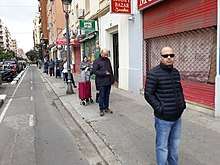
The virus was first confirmed to have spread to Spain on 31 January 2020, when a German tourist tested positive for SARS-CoV-2 in La Gomera, Canary Islands.[400] Post-hoc genetic analysis has shown that at least 15 strains of the virus had been imported, and community transmission began by mid-February.[401] By 13 March, cases had been confirmed in all 50 provinces of the country.
A lockdown was imposed on 14 March 2020.[402] On 29 March, it was announced that, beginning the following day, all non-essential workers were ordered to remain at home for the next 14 days.[403] By late March, the Community of Madrid has recorded the most cases and deaths in the country. Medical professionals and those who live in retirement homes have experienced especially high infection rates.[404] On 25 March, the death toll in Spain surpassed that of mainland China, and only that of Italy was higher.[405] On 2 April, 950 people died of the virus in a 24-hour period—at the time, the most by any country in a single day.[406] On 17 May, the daily death toll announced by the Spanish government fell below 100 for the first time,[407] and 1 June was the first day without deaths by coronavirus.[408] The state of alarm ended on 21 June.[409] However, the number of cases increased again in July in a number of cities including Barcelona, Zaragoza and Madrid, which led to reimposition of some restrictions.[410][411][412]
Studies have suggested that the number of infections and deaths may have under underestimated due to lack of testing and reporting, and many people with only mild or no symptoms were not tested.[413][414] Reports in May suggested that, based on a sample of more than 63,000 people, the number of infections may be ten times higher than the number of confirmed cases by that date, and Madrid and several provinces of Castilla–La Mancha and Castilla y León were the most affected areas with a percentage of infection greater than 10%.[415][416] There may also be as many as 15,815 more deaths according to the Spanish Ministry of Health monitoring system on daily excess mortality (Sistema de Monitorización de la Mortalidad Diaria - MoMo).[417] On 6 July 2020, the results of a Spanish Government nationwide seroprevalence study showed that about two million people, or 5.2% of the population, could have been infected during the pandemic.[418][419] As of 17 August 2020, there have been 359,082 confirmed cases and 28,646 deaths.[420][421]Sweden
Sweden differed from most other European countries in that it mostly remained open.[422] Per the Swedish Constitution, the Public Health Agency of Sweden has autonomy which prevents political interference and the agency's policy favoured forgoing a lockdown. The Swedish strategy focused on measures that could be put in place over a longer period of time, based on the assumption that the virus would start spreading again after a shorter lockdown.[423][424] The New York Times said that, as of May 2020, the outbreak had been far deadlier there but the economic impact had been reduced as Swedes have continued to go to work, restaurants, and shopping.[422][425] On 19 May, it was reported that the country had in the week of 12–19 May the highest per capita deaths in Europe, 6.25 deaths per million per day.[426] In the end of June, Sweden no longer had excess mortality.[427]
United Kingdom

The nature of devolution in the United Kingdom meant that each of the four countries of the UK had its own response to COVID-19 with different rules and restrictions at different times and the UK government, on behalf of England, moving more quickly to lift restrictions.[428] The UK government did not impose any form of social distancing or mass quarantine measures until 18 March 2020[429][430] and was criticised for a perceived lack of intensity in its response to concerns faced by the public.[431][432] On 16 March, Prime Minister Boris Johnson advised against non-essential travel and social contact, suggesting people work from home and avoid venues such as pubs, restaurants, and theatres.[433][434] On 20 March, the government announced that all leisure establishments such as pubs and gyms were to close as soon as possible,[435] and promised to pay up to 80 percent of workers' wages to a limit of £2,500 per month to prevent unemployment.[436]
On 23 March, the prime minister announced tougher social distancing measures, banning gatherings of more than two people and restricting travel and outdoor activity to that deemed strictly necessary. Unlike previous measures, these restrictions were enforceable by police through fines and dispersal of gatherings. Most businesses were ordered to close, with exceptions for those deemed "essential", including supermarkets, pharmacies, banks, hardware shops, petrol stations, and garages.[437]
_003.jpg)
On 24 April it was reported that one of the more promising vaccine trials had begun in England; the government pledged more than £50 million towards research.[438] To ensure UK health services had sufficient capacity to treat people with COVID-19, a number of temporary critical care hospitals were built.[439] The first to be operational was the 4000-bed capacity NHS Nightingale Hospital London, constructed within the ExCeL convention centre over nine days.[440] On 4 May, it was announced that the Nightingale Hospital in London would be placed on standby and remaining patients transferred to other facilities;[441] Nightingale had "treated 51 patients" in the first three weeks it was open.[442]
On 5 May, official figures revealed Britain had the worst COVID-19 death toll in Europe, prompting calls for an inquiry into the handling of the pandemic. The death toll in the United Kingdom was nearly 29,427 (of those who tested positive for the virus). Later, it was calculated at 32,313, after taking the official death count for Scotland and Northern Ireland into account.[443] On 16 April it was reported that the UK would have first access to the Oxford vaccine, due to a prior contract; should the trial be successful, some 30 million doses in the UK would be available.[444]
North America
United States
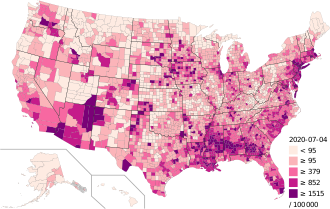
On 20 January 2020, the first known case of COVID-19 was confirmed in the Pacific Northwest state of Washington in a man who returned from Wuhan on 15 January.[445] On 31 January, the Trump administration declared a public health emergency.[446] On 28 January, the Centers for Disease Control and Prevention (CDC) announced they had developed their own testing kit.[447] The United States had a slow start in testing, which obscured the extent of the outbreak,[448][449] marred by defective tests produced by the government in February, lack of federal approval for non-government kits, and restrictive criteria for people to qualify for a test.[448][449]
By 2 March there were 80 confirmed cases, half of them in California. Florida and New York had declared their first two cases and the state of Washington reported many suspected cases and the first death. Vice President Mike Pence maintained that the threat of the virus spreading throughout the U.S. was small.[450][451][452] On 6 March, President Trump signed the Coronavirus Preparedness and Response Supplemental Appropriations Act, which provided $8.3 billion in emergency funding for federal agencies to respond to the outbreak.[453][454] Corporations encouraged employees to work from home.[455] Sports events and seasons were cancelled.[29]
.jpg)
On 13 March, Trump declared a national emergency, which made federal funds available to respond to the crisis.[456] Beginning on 15 March, many businesses closed or reduced hours[457] and schools across the country were shutting down.[458][459] By 17 March, the epidemic was confirmed in all fifty states and the District of Columbia.[460] On 26 March, the United States had more confirmed cases than any other country.[243] U.S. federal health inspectors surveyed 323 hospitals in late March; reporting "severe shortages" of test supplies, "widespread shortages" of personal protective equipment (PPE), and other strained resources due to extended patient stays while awaiting test results.[461]
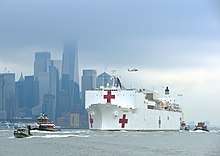
On 22 April, it was reported that two Californians had died from the virus (not, as previously thought, influenza) on 6 and 17 February, three weeks before the first official COVID-19 death in the U.S. had been acknowledged.[247] By 24 April, 889,309 cases had been confirmed and 50,256 people had died.[462] As of 17 May, according to a New York Times database, more than 1,474,600 people had been infected and at least 88,600 had died. The Times said that prior to 29 April only deaths confirmed through testing were reported, but new criteria included probable cases and deaths. As of 17 May, the U.S., with about 4.25 percent of the world's population, had about 29 percent of the confirmed coronavirus deaths.[463]
The White House was criticised for downplaying the threat and controlling messaging, directing health officials and scientists to coordinate public statements with the office of Vice-President Pence.[464] On 14 April, President Trump halted funding to the World Health Organization (WHO), saying they mismanaged the pandemic.[465] On 1 May the CDC presented a 17-page report to the administration, written to provide advice for faith leaders, places of business and other public places, educators, and state and local officials as they reopened. The White House refused to use the report, and Trump said he felt the guidelines were too restrictive, commenting "I see the new normal being what it was three months ago. I think we want to go back to where it was."[466][467]
By mid-May reports of new cases began to level off and most states began to open restaurants and other businesses, placing limits on the numbers of people allowed in at one time. The head of the NIAID, Anthony Fauci, warned that if caution was not used the rate of infections could rebound and he was particularly concerned about opening the schools in the fall. President Trump expressed disapproval of Fauci's statements, saying "To me it's not an acceptable answer, especially when it comes to schools."[468] By mid-June, new cases began to rise again, with increases in the percent of positive tests and number of hospitalizations in states such as Texas, California, Florida, and Arizona.[469] On 12 July, almost 6 months after the first case was recognised in the U.S., the highest single day case record of 15,300 infections was recorded in Florida.[470]
On 6 July 2020, President Trump's administration sent a notice to United Nations Secretary General António Guterres that they would withdraw from the World Health Organization, effective 6 July 2021, under the terms of a joint resolution passed by Congress in 1948 which requires the U.S. to give one-year notice and clear its debts to leave the WHO.[471] On 16 July, the U.S. set a record for the most cases in a single day with more than 75,000 confirmed infections of COVID-19.[472]
South America
On April 17, the highest number of cases and deaths was registered in Brazil,[476] followed by Peru and Chile in the number of confirmed cases.[477]
On May 13, it was reported that Latin America and the Caribbean had reported over 400,000 cases of infection with 23,091 deaths. On May 22, citing especially the rapid increase of infections in Brazil, the WHO declared that South America is presently the epicentre of the coronavirus pandemic.[478][479]
As of June 26, South America has more than 2 million confirmed cases and more than 81,000 deaths. However, due to a dearth of testing and medical facilities it is believed that the outbreak is far larger than the official numbers show.[480]Brazil

On 20 May it was reported that Brazil had a record 1,179 deaths in a single day, for a total of almost 18,000 fatalities. With a total number of almost 272,000 cases, Brazil became the country with the third-highest number of cases, following Russia and the United States.[481] On 25 May, Brazil exceeded the number of reported cases in Russia when they reported that 11,687 new cases had been confirmed over the previous 24 hours, bringing the total number to over 374,800, with more than 23,400 deaths. President Jair Bolsonaro has created a great deal of controversy referring to the virus as a "little flu" and frequently speaking out against preventive measures such as lockdowns and quarantines. His attitude towards the outbreak has so closely matched that of U.S. president Donald Trump he has been called the "Trump of the Tropics".[482] Bolsonaro later tested positive for the virus.[483]
In June 2020, the government of Brazil attempted to conceal the actual figures of the COVID-19 active cases and deaths, as it stopped publishing the total number of infections and deaths. On 5 June, Brazil's health ministry took down the official website reflecting the total numbers of infections and deaths. The website was live on 6 June, with only the number of infections of previous 24 hours. The last official numbers reported about 615,000 infections and over 34,000 deaths.[484] On 15 June, it was reported that the worldwide cases had jumped from seven to eight million in one week, citing Latin America, specifically Brazil as one of the countries where cases are surging, in this case, towards 1 million cases.[485]
Africa
.jpg)
According to Michael Yao, WHO's head of emergency operations in Africa, early detection is vital because the continent's health systems "are already overwhelmed by many ongoing disease outbreaks".[486][487] Advisers say that a strategy based on testing could allow African countries to minimise lockdowns that inflict enormous hardship on those who depend on income earned day by day to be able to feed themselves and their families. Even in the best scenario, the United Nations says 74 million test kits and 30,000 ventilators will be needed by the continent's 1.3 billion people in 2020.[488] The number of infections exceeded a million by 6 August, with five countries make up over 75% of the total confirmed cases: South Africa, Algeria, Egypt, Ghana and Nigeria.[489] It is, however, believed that there is widespread under-reporting in other African countries with poorer health care systems,[490] and some countries such as Tanzania failed to provide useful statistics. The mortality rates of COVID-19 cases in African countries are relatively low compared to Europe due to the younger age of their populations.[489]
Cases have been confirmed in all African countries, with Lesotho the last country to report its first coronavirus case on 13 May 2020.[491] There have been no reported cases in the British Overseas Territory of Saint Helena, Ascension and Tristan da Cunha.[492]
Oceania
On 19 May 2020, Australia filed a motion with the UN for an inquiry into the origins of the virus, and the response of the UN and governments. More than 100 countries supported this motion, and it was passed unanimously.[495][496]
International responses
Travel restrictions
As a result of the pandemic, many countries and regions imposed quarantines, entry bans, or other restrictions, either for citizens, recent travellers to affected areas,[497] or for all travellers.[498] Together with a decreased willingness to travel, this had a negative economic and social impact on the travel sector. Concerns have been raised over the effectiveness of travel restrictions to contain the spread of COVID-19.[499] A study in Science found that travel restrictions had only modestly affected the initial spread of COVID-19, unless combined with infection prevention and control measures to considerably reduce transmissions.[500] Researchers concluded that "travel restrictions are most useful in the early and late phase of an epidemic" and "restrictions of travel from Wuhan unfortunately came too late".[501]
The European Union rejected the idea of suspending the Schengen free travel zone and introducing border controls with Italy,[502][503] a decision which has been criticised by some European politicians.[504][505]
Evacuation of foreign citizens
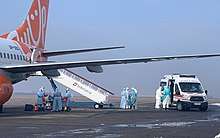
Owing to the effective quarantine of public transport in Wuhan and Hubei, several countries evacuated their citizens and diplomatic staff from the area, primarily through chartered flights of the home nation, with Chinese authorities providing clearance. Canada, the United States, Japan, India,[506] Sri Lanka, Australia, France, Argentina, Germany, and Thailand were among the first to plan the evacuation of their citizens.[507] Brazil and New Zealand also evacuated their own nationals and some other people.[508][509] On 14 March, South Africa repatriated 112 South Africans who tested negative for the virus from Wuhan, while four who showed symptoms were left behind to mitigate risk.[510] Pakistan said it would not evacuate citizens from China.[511]
On 15 February, the U.S. announced it would evacuate Americans aboard the cruise ship Diamond Princess,[512] and on 21 February, Canada evacuated 129 Canadian passengers from the ship.[513] In early March, the Indian government began evacuating its citizens from Iran.[514][515] On 20 March, the United States began to partially withdraw its troops from Iraq due to the pandemic.[516]
International aid
United Nations response measures
The United Nations has coordinated the global response to the coronavirus pandemic, led by its Secretary-General. The response can be divided into formal resolutions at the General Assembly and at the Security Council (UNSC), and operations via its specialized agencies, chiefly the World Health Organization in the initial stages, but involving more humanitarian-oriented agencies, like UNICEF,[517] the International Labour Organization,[518] and the Office of the United Nations High Commissioner for Human Rights[519] as the humanitarian impact became clearer, and then economic organizations, like the United Nations Conference on Trade and Development,[520] the International Monetary Fund,[521] and the World Bank,[522] as the socioeconomic implications worsened. In June 2020, the Secretary-General launched its 'UN Comprehensive Response to COVID-19'.[523] The UNSC has been criticized for a slow coordinated response, especially regarding the UN's global ceasefire, which aims to open up humanitarian access to the world's most vulnerable in conflict zones.[524]
WHO response measures
.jpg)
Taiwan posted an inquiry to the WHO on 31 December 2019.[525][526] The WHO has commended the Chinese authorities for providing "regular updates," contrasting it to the 2002–2004 SARS outbreak when they were accused of secrecy.[527] The WHO said on 5 January that cases of pneumonia of unknown cause had been reported,[528] and issued technical briefings on 10 and 11 January warning of risks of human-to-human transmission and urging precautions due to the similarity to earlier SARS and MERS outbreaks.[529] though in public announcements it said there was "no clear evidence of human-to-human transmission" as late as 14 January.[530] On 20 January, the WHO said it was "now very clear" human-to-human transmission of the coronavirus had occurred, given that healthcare workers had been infected.[531] On 27 January, the WHO assessed the risk of the outbreak to be "high at the global level."[532]
On 30 January, the WHO declared the outbreak a Public Health Emergency of International Concern (PHEIC), warning that "all countries should be prepared for containment, including active surveillance, early detection, isolation and case management, contact tracing and prevention of onward spread" of the virus,[7][533] following an increase in cases outside China. This was the sixth-ever PHEIC since the measure was first invoked during the 2009 swine flu pandemic. WHO Director-General Tedros Adhanom said the PHEIC was due to "the risk of global spread, especially to low- and middle-income countries without robust health systems," but that the WHO did not "recommend limiting trade and movement."[7][534][535]
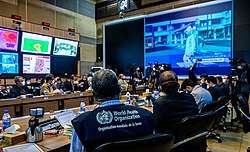
On 11 February, the WHO established COVID-19 as the name of the disease, and UN Secretary-General António Guterres agreed to provide the "power of the entire UN system in the response." A UN Crisis Management Team was activated, allowing coordination of the entire United Nations, which the WHO said will allow them to "focus on the health response while the other agencies can bring their expertise to bear on the wider social, economic and developmental implications of the outbreak".[536] On 25 February, the WHO declared "the world should do more to prepare for a possible coronavirus pandemic," stating that while it was too early to call it a pandemic, countries should be "in a phase of preparedness."[537] On 28 February, WHO officials said the coronavirus threat assessment at the global level would be raised from "high" to "very high", its highest level of alert and risk assessment.[538] On 11 March, the WHO declared the coronavirus outbreak a pandemic.[539] The Director-General said the WHO was "deeply concerned both by the alarming levels of spread and severity, and by the alarming levels of inaction".[8] Critics have said the WHO handled the pandemic inadequately and that the PHEIC and pandemic classification came too late.[540] The third meeting of the WHO Emergency Committee on 30 April renewed the declaration of PHEIC for the second time.[541]
Impact
Economics
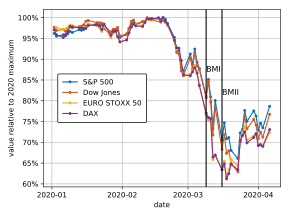
The outbreak is a major destabilising threat to the global economy. Agathe Demarais of the Economist Intelligence Unit has forecast that markets will remain volatile until a clearer image emerges on potential outcomes. One estimate from an expert at Washington University in St. Louis gave a $300+ billion impact on the world's supply chain that could last up to two years.[542] Global stock markets fell on 24 February due to a significant rise in the number of COVID-19 cases outside China.[543][544] On 27 February, due to mounting worries about the coronavirus outbreak, U.S. stock indexes posted their sharpest falls since 2008, with the Dow falling 1,191 points (the largest one-day drop since the financial crisis of 2007–08)[545] and all three major indexes ending the week down more than 10 percent.[546] On 28 February, Scope Ratings GmbH affirmed China's sovereign credit rating but maintained a Negative Outlook.[547] Stocks plunged again due to coronavirus fears, the largest fall being on 16 March.[548] Many consider an economic recession likely.[549][550]
Lloyd's of London has estimated that the global insurance industry will absorb losses of US$204 billion, exceeding the losses from the 2017 Atlantic Hurricane season and 9/11, suggesting the COVID-19 pandemic will likely go down in history as the costliest disaster ever in human history.[551]
.jpg)
Tourism is one of the worst affected sectors due to travel bans, closing of public places including travel attractions, and advice of governments against travel. Numerous airlines have cancelled flights due to lower demand, and British regional airline Flybe collapsed.[552] The cruise line industry was hard hit,[553] and several train stations and ferry ports have also been closed.[554] International mail between some countries stopped or was delayed due to reduced transportation between them or suspension of domestic service.[555]
The retail sector has been impacted globally, with reductions in store hours or temporary closures.[556] Visits to retailers in Europe and Latin America declined by 40 percent. North America and Middle East retailers saw a 50–60 percent drop.[557] This also resulted in a 33–43 percent drop in foot traffic to shopping centres in March compared to February. Shopping mall operators around the world imposed additional measures, such as increased sanitation, installation of thermal scanners to check the temperature of shoppers, and cancellation of events.[558]

Hundreds of millions of jobs could be lost globally.[559][560] More than 40 million Americans lost their jobs and filed unemployment insurance claims.[561] According to a United Nations Economic Commission for Latin America estimate, the pandemic-induced recession could leave 14–22 million more people in extreme poverty in Latin America than would have been in that situation without the pandemic.[562]
According to the World Bank, up to 100 million more people globally could fall into extreme poverty due to the shutdowns.[25][26][27]
Supply shortages
.jpg)
The outbreak has been blamed for several instances of supply shortages, stemming from globally increased usage of equipment to fight outbreaks, panic buying (which in several places led to shelves being cleared of grocery essentials such as food, toilet paper, and bottled water), and disruption to factory and logistic operations.[563] The spread of panic buying has been found to stem from perceived threat, perceived scarcity, fear of the unknown, coping behaviour and social psychological factors (e.g. social influence and trust).[564] The technology industry, in particular, has warned of delays to shipments of electronic goods.[565] According to the WHO director-general Tedros Adhanom, demand for personal protection equipment has risen a hundredfold, leading to prices up to twenty times the normal price and also delays in the supply of medical items of four to six months.[566][567] It has also caused a shortage of personal protective equipment worldwide, with the WHO warning that this will endanger health workers.[568]
The impact of the coronavirus outbreak was worldwide. The virus created a shortage of precursors (raw material) used in the manufacturing of fentanyl and methamphetamine. The Yuancheng Group, headquartered in Wuhan, is one of the leading suppliers.[569] Price increases and shortages in these illegal drugs have been noticed on the street of the UK.[570] U.S. law enforcement also told the New York Post Mexican drug cartels were having difficulty in obtaining precursors.[571]
The pandemic has disrupted global food supplies and threatens to trigger a new food crisis.[572][573] David Beasley, head of the World Food Programme (WFP), said "we could be facing multiple famines of biblical proportions within a short few months."[574] Senior officials at the United Nations estimated in April 2020 that an additional 130 million people could starve, for a total of 265 million by the end of 2020.[575][574][576]
Oil and other energy markets
In early February 2020, Organization of the Petroleum Exporting Countries (OPEC) "scrambled" after a steep decline in oil prices due to lower demand from China.[577] On Monday, 20 April, the price of West Texas Intermediate (WTI) went negative and fell to a record low (minus $37.63 a barrel) due to traders' offloading holdings so as not to take delivery and incur storage costs.[578] June prices were down but in the positive range, with a barrel of West Texas trading above $20.[578]
Culture

The performing arts and cultural heritage sectors have been profoundly affected by the pandemic, impacting organisations' operations as well as individuals—both employed and independent—globally. Arts and culture sector organisations attempted to uphold their (often publicly funded) mission to provide access to cultural heritage to the community, maintain the safety of their employees and the public, and support artists where possible. By March 2020, across the world and to varying degrees, museums, libraries, performance venues, and other cultural institutions had been indefinitely closed with their exhibitions, events and performances cancelled or postponed.[579] In response there were intensive efforts to provide alternative services through digital platforms.[580][581][582]

Holy Week observances in Rome, which occur during the last week of the Christian penitential season of Lent, were cancelled.[581] Many dioceses have recommended older Christians stay home rather than attend Mass on Sundays; services have been made available via radio, online live streaming and television, though some congregations have made provisions for drive-in worship.[583][584][581] With the Roman Catholic Diocese of Rome closing its churches and chapels and St. Peter's Square emptied of Christian pilgrims,[581] other religious bodies also cancelled in-person services and limited public gatherings in churches, mosques, synagogues, temples and gurdwaras.[581] Iran's Health Ministry announced the cancellation of Friday prayers in areas affected by the outbreak and shrines were later closed,[325][332] while Saudi Arabia banned the entry of foreign pilgrims as well as its residents to holy sites in Mecca and Medina.[585][586] The 2020 Hajj was limited to around 1,000 selected pilgrims, in contrast to the usual number of over 2 million.[587]
The pandemic has caused the most significant disruption to the worldwide sporting calendar since the Second World War. Most major sporting events have been cancelled or postponed, including the 2019–20 UEFA Champions League,[588] 2019–20 Premier League,[589] UEFA Euro 2020, 2019–20 NBA season,[590] and 2019–20 NHL season.[591] The outbreak disrupted plans for the 2020 Summer Olympics in Tokyo, Japan, which were originally scheduled to start at 24 July 2020, and were postponed by the International Olympic Committee to 23 July 2021.[592][593][594]
The entertainment industry has also been affected, with many music groups suspending or cancelling concert tours.[595][596] The Eurovision Song Contest, which was due to be held in Rotterdam, the Netherlands in May, was cancelled, however the Netherlands was retained as host for 2021.[597][598] Many large theatres such as those on Broadway also suspended all performances.[599] Some artists have explored ways to continue to produce and share work over the internet as an alternative to traditional live performance, such as live streaming concerts[600] or creating web-based "festivals" for artists to perform, distribute, and publicise their work.[601] Online, numerous COVID-19-themed Internet memes have spread as many turn to humour and distraction amid the uncertainty.[602]
Politics
The pandemic has affected the political systems of multiple countries, causing suspensions of legislative activities,[603] isolations or deaths of multiple politicians,[604] and rescheduling of elections due to fears of spreading the virus.[605] Starting in late May, large-scale protests against police brutality in at least 200 U.S. cities and later worldwide in response to the killing of George Floyd raised concerns of a resurgence of the virus.[606]
Although they have broad support among epidemiologists, social distancing measures have been politically controversial in many countries. Intellectual opposition to social distancing has come primarily from writers of other fields, although there are a few heterodox epidemiologists.[607]
The measures taken to combat the pandemic are part of an unusually large expansion of government power. Advocates of small government worry that the state will be reluctant to give up that power once the crisis is over, as has often been the case historically.[608]
On 23 March 2020, United Nations Secretary-General António Manuel de Oliveira Guterres issued an appeal for a global ceasefire in response to the pandemic;[609][610] 172 UN Member States and Observers signed a non-binding statement in support of the appeal in June,[611] and the UN Security Council passed a resolution supporting it in July.[612][613]
China

The Chinese government has been criticised by the United States government,[614] UK Minister for the Cabinet Office Michael Gove,[615] and others[616] for its handling of the pandemic. A number of provincial-level administrators of the Communist Party of China were dismissed over their handling of the quarantine measures in China, a sign of discontent with their response to the outbreak. Some commentators believed this move was intended to protect Chinese Communist Party general secretary Xi Jinping from the controversy.[617] The U.S. intelligence community says China intentionally under-reported its number of coronavirus cases.[618] The Chinese government maintains it has acted swiftly and transparently.[619][620]
Italy
In early March, the Italian government criticised the European Union's lack of solidarity with coronavirus-affected Italy[621][622]—Maurizio Massari, Italy's ambassador to the EU, said "only China responded bilaterally", not the EU.[623] On 22 March, after a phone call with Italian Prime Minister Giuseppe Conte, Russian president Vladimir Putin had the Russian army send military medics, disinfection vehicles, and other medical equipment to Italy.[624] President of Lombardy Attilio Fontana and Italian Foreign Minister Luigi Di Maio expressed their gratitude for the aid.[625] Russia also sent a cargo plane with medical aid to the United States.[626] Kremlin spokesman Dmitry Peskov said "when offering assistance to U.S. colleagues, [Putin] assumes that when U.S. manufacturers of medical equipment and materials gain momentum, they will also be able to reciprocate if necessary."[627] In early April, Norway and EU states like Romania and Austria started to offer help by sending medical personnel and disinfectant,[628] and Ursula von der Leyen offered an official apology to the country.[629]
United States
.jpg)
The outbreak prompted calls for the United States to adopt social policies common in other wealthy countries, including universal health care, universal child care, paid sick leave, and higher levels of funding for public health.[631][632][633] Political analysts anticipated it may negatively affect Donald Trump's chances of re-election.[634][635] Beginning in mid-April 2020, there were protests in several U.S. states against government-imposed business closures and restricted personal movement and association.[636] Simultaneously, protests ensued by essential workers in the form of a general strike.[637]
Other countries
The planned NATO "Defender 2020" military exercise in Germany, Poland, and the Baltic states, the largest NATO war exercise since the end of the Cold War, will be held on a reduced scale.[638][639] The Campaign for Nuclear Disarmament's general secretary Kate Hudson criticised the exercise, saying "it jeopardises the lives not only of the troops from the U.S. and the many European countries participating but the inhabitants of the countries in which they are operating."[640]
The Iranian government has been heavily affected by the virus, with about two dozen parliament members and fifteen current or former political figures infected.[335][641] Iran's President Hassan Rouhani wrote a public letter to world leaders asking for help on 14 March 2020, saying they were struggling to fight the outbreak due to a lack of access to international markets from the United States sanctions against Iran.[642] Saudi Arabia, which launched a military intervention in Yemen in March 2015, declared a ceasefire.[643]
Diplomatic relations between Japan and South Korea worsened due to the pandemic.[644] South Korea criticised Japan's "ambiguous and passive quarantine efforts" after Japan announced anyone coming from South Korea would be placed in quarantine for two weeks at government-designated sites.[645] South Korean society was initially polarised on President Moon Jae-in's response to the crisis; many Koreans signed petitions either calling for Moon's impeachment or praising his response.[358]
Some countries have passed emergency legislation in response to the pandemic. Some commentators have expressed concern that it could allow governments to strengthen their grip on power.[646][647] In the Philippines, lawmakers granted president Rodrigo Duterte temporary emergency powers during the pandemic.[648] In Hungary, the parliament voted to allow the prime minister, Viktor Orbán, to rule by decree indefinitely, suspend parliament as well as elections, and punish those deemed to have spread false information about the virus and the government's handling of the crisis.[649] In some countries, including Egypt,[650] Turkey,[651] and Thailand,[648] opposition activists and government critics have been arrested for allegedly spreading fake news about the COVID-19 pandemic.[652]
Famine
The pandemic, alongside lockdowns and travel restrictions, has prevented movement of aid and greatly impacted food production. As a result, several famines are forecast, which the United Nations called a crisis "of biblical proportions,"[653] or "hunger pandemic."[654] It is estimated that without intervention 30 million people may die of hunger, with Oxfam reporting that "12,000 people per day could die from COVID-19 linked hunger" by the end of 2020.[655][653][656] This pandemic, in conjunction with the 2019-20 locust infestations and several ongoing armed conflicts, is predicted to form the worst series of famines since the Great Chinese Famine, affecting between 10 and 20 percent of the global population in some way.[657] 55 countries are reported to be at risk, with three dozen succumbing to crisis-level famines or above in the worst-case scenario.[658] 265 million people are forecast to be in famine conditions, an increase of 125 million due to the coronavirus pandemic.[655]
Education
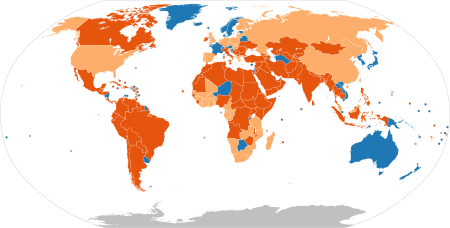
The pandemic has affected educational systems worldwide, leading to the near-total closures of schools, universities and colleges.[659]
Most governments around the world have temporarily closed educational institutions in an attempt to contain the spread of COVID-19.[660] As of 27 July 2020, approximately 1.725 billion learners are currently affected due to school closures in response to the pandemic. According to UNICEF monitoring, 106 countries are currently implementing nationwide closures and 55 are implementing local closures, impacting about 98.6 percent of the world's student population. 48 countries' schools are currently open.[661]
On 23 March 2020, Cambridge International Examinations (CIE) released a statement announcing the cancellation of Cambridge IGCSE, Cambridge O Level, Cambridge International AS & A Level, Cambridge AICE Diploma, and Cambridge Pre-U examinations for the May/June 2020 series across all countries.[662] International Baccalaureate exams have also been cancelled.[663] In addition, Advanced Placement Exams, SAT administrations, and ACT administrations have been moved online and cancelled.
School closures impact not only students, teachers, and families.[664] but have far-reaching economic and societal consequences.[665][666] School closures in response to the pandemic have shed light on various social and economic issues, including student debt,[667] digital learning,[668][669] food insecurity,[670] and homelessness,[671][672] as well as access to childcare,[673] health care,[674] housing,[675] internet,[676] and disability services.[677] The impact was more severe for disadvantaged children and their families, causing interrupted learning, compromised nutrition, childcare problems, and consequent economic cost to families who could not work.[678][679]
In response to school closures, UNESCO recommended the use of distance learning programmes and open educational applications and platforms that schools and teachers can use to reach learners remotely and limit the disruption of education.[680]Other health issues
The pandemic has had many impacts on global health beyond those caused by the COVID-19 disease itself. It has led to a reduction in hospital visits for other reasons. There have been 38 per cent fewer hospital visits for heart attack symptoms in the United States and 40 per cent fewer in Spain.[681] The head of cardiology at the University of Arizona said, "My worry is some of these people are dying at home because they're too scared to go to the hospital."[682] There is also concern that people with strokes and appendicitis are not seeking timely treatment.[682] Shortages of medical supplies have impacted people with various conditions.[683]
In several countries there has been a marked reduction of spread of sexually transmitted infections, including HIV/AIDS, attributable to COVID-19 quarantines, social distancing measures, and recommendations to not engage in casual sex.[684][685] Similarly, in some places, rates of transmission of influenza and other respiratory viruses significantly decreased during the pandemic.[686][687][688]
The pandemic has also negatively impacted mental health globally, including increased loneliness resulting from social distancing.[689]Environment and climate
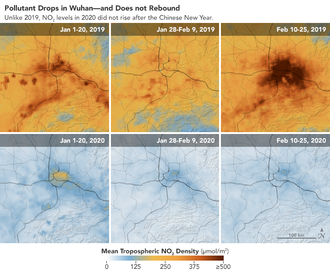
The worldwide disruption caused by the pandemic has resulted in numerous impacts on the environment and the climate. The considerable decline in planned travel[691] has caused many regions to experience a large drop in air pollution.[692] In China, lockdowns and other measures resulted in a 25 per cent reduction in carbon emissions[693] and 50 per cent reduction in nitrogen oxides emissions,[694] which one Earth systems scientist estimated may have saved at least 77,000 lives over two months.[695][696] Other positive impacts on the environment include governance-system-controlled investments towards a sustainable energy transition and other goals related to environmental protection such as the European Union's seven-year €1 trillion budget proposal and €750 billion recovery plan "Next Generation EU" which seeks to reserve 25% of EU spending for climate-friendly expenditure.[697][698][699]
However, the outbreak has also provided cover for illegal activities such as deforestation of the Amazon rainforest[700][701] and poaching in Africa,[702][703] hindered environmental diplomacy efforts,[704] and created economic fallout that some predict will slow investment in green energy technologies.[705]
Xenophobia and racism
Since the start of the outbreak, heightened prejudice, xenophobia, and racism have been documented around the world toward people of Chinese and East Asian descent.[706][707][708] Reports from February (when most cases were confined to China) documented racist sentiments expressed in groups worldwide about Chinese people deserving the virus.[709][710][711] Chinese people and other Asians in the United Kingdom and United States have reported increasing levels of racist abuse and assaults.[712][713][714] U.S. president Donald Trump has been criticised for referring to the coronavirus as the "Chinese Virus" and "Kung Flu", which critics say is racist and anti-Chinese.[715][716][717]
Following the progression of the outbreak to new hotspot countries, people from Italy (the first country in Europe to experience a serious outbreak of COVID-19) were also subjected to suspicion and xenophobia,[718][719] as were people from hotspots in other countries. Discrimination against Muslims in India escalated after public health authorities identified an Islamic missionary (Tablighi Jamaat) group's gathering in New Delhi in early March 2020 as a source of spread.[720] Paris has seen riots break out over police treatment of ethnic minorities during the coronavirus lockdown.[721] Racism and xenophobia towards South Asians and Southeast Asians increased in the Arab states of the Persian Gulf.[722][723][724] South Korea's LGBTQ community was blamed by some for the spread of COVID-19 in Seoul.[725][726]
In China, xenophobia and racism against non-Chinese residents has been inflamed by the pandemic; a comic posted on Weibo described foreigners as "foreign garbage" targeted for "disposal".[727] Some black people were evicted from their homes by police and told to leave China within 24 hours, due to disinformation that they and other foreigners were spreading the virus.[728] Other harassment, discrimination and evictions of Africans in China were alleged.[729] This racism and xenophobia was criticised by foreign governments and diplomatic corps and the Chinese ambassador to Zimbabwe.[730] A McDonald's branch in Guangzhou barring blacks sparked anger in China and overseas, and McDonald's closed the location.[731]
Information dissemination
Ongoing COVID-19 research is indexed and searchable in the NIH COVID-19 Portfolio.[732] Some newspaper agencies removed their online paywalls for some or all of their coronavirus-related articles and posts,[733] while scientific publishers made scientific papers related to the outbreak available with open access.[734] Some scientists chose to share their results quickly on preprint servers such as bioRxiv.[735]
Misinformation
The pandemic has resulted in misinformation and conspiracy theories about the scale of the pandemic and the origin, prevention, diagnosis, and treatment of the disease. False information, including intentional disinformation, has been spread through social media, text messaging, and mass media, including the tabloid media,[743] conservative media,[744][745] and state media of countries such as China,[747] Russia, Iran, and Turkmenistan. It has also been reportedly spread by covert operations backed by states such as Saudi Arabia, Russia and China to generate panic and sow distrust in other countries.[753] In some countries, such as India,[756] Bangladesh,[757] and Ethiopia,[758] journalists have been arrested for allegedly spreading fake news about the pandemic.
Misinformation has been propagated by celebrities, politicians[761] (including heads of state in countries such as the United States,[762][763] Iran, and Brazil[766]), and other prominent public figures. Commercial scams have claimed to offer at-home tests, supposed preventives, and "miracle" cures. Several religious groups have claimed their faith will protect them from the virus.[770] Some people have claimed the virus is a bioweapon accidentally or purposefully leaked from a laboratory,[773][774] a population control scheme, the result of a spy operation, or the side effect of 5G upgrades to cellular networks.
The World Health Organization has declared an "infodemic" of incorrect information about the virus, which poses risks to global health.See also
- Coronavirus disease 2019
- Emerging infectious disease
- Globalisation and disease
- List of epidemics and pandemics
- Timeline of the COVID-19 pandemic
Notes
- In summary, this article is about the coronavirus pandemic, which is caused by the disease COVID‑19, which is caused by the virus SARS‑CoV‑2.[1]
- An uncovered cough can travel up to 8.2 metres (27 feet).[9]
- The term of art used by epidemiologists is "close contact" which is defined as less than one metre (~3.3 feet) by the WHO[10] and within ~1.8 metres (six feet) by the US Centers for Disease Control and Prevention (CDC).[11]
References
- "Naming the coronavirus disease (COVID-19) and the virus that causes it". World Health Organization (WHO).
- "Coronavirus very likely of animal origin, no sign of lab manipulation: WHO". Reuters. 21 April 2020. Retrieved 23 April 2020.
- Lau SK, Luk HK, Wong AC, Li KS, Zhu L, He Z, et al. (April 2020). "Possible Bat Origin of Severe Acute Respiratory Syndrome Coronavirus 2". Emerging Infectious Diseases. U.S. Centers for Disease Control and Prevention (CDC). 26 (7): 1542–1547. doi:10.3201/eid2607.200092. ISSN 1080-6059. OCLC 1058036512. PMC 7323513. PMID 32315281. S2CID 216073459.
- "Novel Coronavirus—China". World Health Organization (WHO). Retrieved 9 April 2020.
- "COVID-19 Dashboard by the Center for Systems Science and Engineering (CSSE) at Johns Hopkins University (JHU)". ArcGIS. Johns Hopkins University. Retrieved 19 August 2020.
- Huang C, Wang Y, Li X, Ren L, Zhao J, Hu Y, et al. (February 2020). "Clinical features of patients infected with 2019 novel coronavirus in Wuhan, China". Lancet. 395 (10223): 497–506. doi:10.1016/s0140-6736(20)30183-5. PMC 7159299. PMID 31986264.
- "Statement on the second meeting of the International Health Regulations (2005) Emergency Committee regarding the outbreak of novel coronavirus (2019-nCoV)". World Health Organization (WHO). 30 January 2020. Archived from the original on 31 January 2020. Retrieved 30 January 2020.
- "WHO Director-General's opening remarks at the media briefing on COVID-19—11 March 2020". World Health Organization. 11 March 2020. Retrieved 11 March 2020.
- Bourouiba L (March 2020). "Turbulent Gas Clouds and Respiratory Pathogen Emissions: Potential Implications for Reducing Transmission of COVID-19". JAMA. doi:10.1001/jama.2020.4756. PMID 32215590.
- "Q&A on coronaviruses (COVID-19)". World Health Organization. 17 April 2020. Archived from the original on 14 May 2020. Retrieved 14 May 2020.
- "How COVID-19 Spreads". U.S. Centers for Disease Control and Prevention (CDC). 2 April 2020. Archived from the original on 3 April 2020. Retrieved 3 April 2020.
- "Q & A on COVID-19". European Centre for Disease Prevention and Control. Retrieved 30 April 2020.
- Stadnytskyi V, Bax CE, Bax A, Anfinrud P (June 2020). "The airborne lifetime of small speech droplets and their potential importance in SARS-CoV-2 transmission". Proceedings of the National Academy of Sciences of the United States of America. 117 (22): 11875–11877. doi:10.1073/pnas.2006874117. PMC 7275719. PMID 32404416.
- "Q&A: How is COVID-19 transmitted?". World Health Organization (WHO). Retrieved 12 July 2020.
- Hopkins C. "Loss of sense of smell as marker of COVID-19 infection". Ear, Nose and Throat surgery body of United Kingdom. Retrieved 28 March 2020.
- "Symptoms of Coronavirus". U.S. Centers for Disease Control and Prevention (CDC). 20 March 2020. Archived from the original on 30 January 2020.
- "Interim Clinical Guidance for Management of Patients with Confirmed Coronavirus Disease (COVID-19)". U.S. Centers for Disease Control and Prevention (CDC). 4 April 2020. Retrieved 11 April 2020.
- "Symptoms of Novel Coronavirus (2019-nCoV)". U.S. Centers for Disease Control and Prevention (CDC). 10 February 2020. Retrieved 11 February 2020.
- Velavan TP, Meyer CG (March 2020). "The COVID-19 epidemic". Tropical Medicine & International Health. 25 (3): 278–280. doi:10.1111/tmi.13383. PMC 7169770. PMID 32052514.
- "Caring for Yourself at Home". U.S. Centers for Disease Control and Prevention (CDC). 11 February 2020. Retrieved 23 March 2020.
- National Center for Immunization and Respiratory Diseases (NCIRD) (9 July 2020). "COVID-19 Employer Information for Office Buildings". .S. Centers for Disease Control and Prevention (CDC). Retrieved 9 July 2020.
- "Unite against COVID-19". Unite against COVID-19. Government of New Zealand. Retrieved 11 April 2020.
- "Here Comes the Coronavirus Pandemic: Now, after many fire drills, the world may be facing a real fire". Editorial. The New York Times. 29 February 2020. Retrieved 1 March 2020.
- "The Great Lockdown: Worst Economic Downturn Since the Great Depression". IMF Blog. Retrieved 23 April 2020.
- "Updated estimates of the impact of COVID-19 on global poverty". World Bank. 8 June 2020.
- "Extreme poverty rises and a generation sees future slip away". Yahoo! News. 10 August 2020.
- "Extreme poverty rises and a generation sees future slip away". AP News. 10 August 2020.
- "As famines of 'biblical proportion' loom, Security Council urged to 'act fast'". UN News. 21 April 2020. Retrieved 10 July 2020.
- "A List of What's Been Canceled Because of the Coronavirus". The New York Times. 1 April 2020. Retrieved 11 April 2020.
- Scipioni, Jade (18 March 2020). "Why there will soon be tons of toilet paper, and what food may be scarce, according to supply chain experts". CNBC. Retrieved 19 March 2020.
- "The Coronavirus Outbreak Could Disrupt the U.S. Drug Supply". Council on Foreign Relations. Retrieved 19 March 2020.
- Watts J, Kommenda N (23 March 2020). "Coronavirus pandemic leading to huge drop in air pollution". The Guardian. ISSN 0261-3077. Retrieved 8 April 2020.
- "Analysis: Coronavirus temporarily reduced China's CO2 emissions by a quarter". Carbon Brief. 19 February 2020. Retrieved 8 April 2020.
- "Education: From disruption to recovery". UNESCO. 4 March 2020. Retrieved 28 March 2020.
- Clamp R (5 March 2020). "Coronavirus and the Black Death: spread of misinformation and xenophobia shows we haven't learned from our past". The Conversation. Retrieved 14 March 2020.
- Lee J, Yadav M. "The Rise of Anti-Asian Hate in the Wake of Covid-19". Social Science Research Council. Social Science Research Council. Retrieved 3 July 2020.
- "Novel Coronavirus". World Health Organization (WHO). Archived from the original on 22 January 2020. Retrieved 6 February 2020.
"COVID-19 timeline in the Western Pacific". WHO. 18 May 2020. Archived from the original on 23 May 2020. Retrieved 6 July 2020. - "27 cases of viral pneumonia reported in central China's Wuhan City". news.cgtn.com. Retrieved 29 May 2020.
- "Mystery pneumonia virus probed in China". BBC News. 3 January 2020. Archived from the original on 5 January 2020. Retrieved 29 January 2020.
- WHO Report (30 January 2020). "Novel Coronavirus(2019-nCoV): Situation Report-10" (PDF). World Health Organization (WHO). 30 January 2020. Retrieved 30 January 2020.
- Sun J, He W, Wang L, Lai A, Ji X, Zhai X, et al. (2020). "COVID-19: Epidemiology, Evolution, and Cross-Disciplinary Perspectives". Trends in Molecular Medicine. 26 (5): 483–495. doi:10.1016/j.molmed.2020.02.008. PMC 7118693. PMID 32359479.
- Novel Coronavirus Pneumonia Emergency Response Epidemiology Team (February 2020). "[The epidemiological characteristics of an outbreak of 2019 novel coronavirus diseases (COVID-19) in China]". Zhonghua Liu Xing Bing Xue Za Zhi = Zhonghua Liuxingbingxue Zazhi (in Chinese). 41 (2): 145–151. doi:10.3760/cma.j.issn.0254-6450.2020.02.003. PMID 32064853. S2CID 211133882.
- Perlman S (February 2020). "Another Decade, Another Coronavirus". The New England Journal of Medicine. 382 (8): 760–762. doi:10.1056/NEJMe2001126. PMC 7121143. PMID 31978944.
- Cyranoski D (March 2020). "Mystery deepens over animal source of coronavirus". Nature. 579 (7797): 18–19. Bibcode:2020Natur.579...18C. doi:10.1038/d41586-020-00548-w. PMID 32127703. S2CID 211836524.
- Zhang T, Wu Q, Zhang Z (April 2020). "Probable Pangolin Origin of SARS‑CoV‑2 Associated with the COVID-19 Outbreak". Current Biology. 30 (7): 1346–1351.e2. doi:10.1016/j.cub.2020.03.022. PMC 7156161. PMID 32197085.
- "Outbreak of severe acute respiratory syndrome coronavirus 2 (SARS‑CoV‑2): increased transmission beyond China—fourth update" (PDF). European Centre for Disease Prevention and Control. 14 February 2020. Retrieved 8 March 2020.
- "The COVID-19 coronavirus epidemic has a natural origin, scientists say—Scripps Research's analysis of public genome sequence data from SARS‑CoV‑2 and related viruses found no evidence that the virus was made in a laboratory or otherwise engineered". EurekAlert!. Scripps Research Institute. 17 March 2020. Retrieved 15 April 2020.
- Andersen KG, Rambaut A, Lipkin WI, Holmes EC, Garry RF (April 2020). "The proximal origin of SARS-CoV-2". Nature Medicine. 26 (4): 450–452. doi:10.1038/s41591-020-0820-9. PMC 7095063. PMID 32284615.
- Wassenaar T, Zhou Y (May 2020), "2019_nCoV/SARS‐CoV‐2: rapid classification of betacoronaviruses and identification of Traditional Chinese Medicine as potential origin of zoonotic coronaviruses", Letters in Applied Microbiology, 70 (5): 342–348, doi:10.1111/lam.13285, PMC 7165814, PMID 32060933
- Cohen J (January 2020). "Wuhan seafood market may not be source of novel virus spreading globally". Science. doi:10.1126/science.abb0611.
- Wang C, Horby PW, Hayden FG, Gao GF (February 2020). "A novel coronavirus outbreak of global health concern". Lancet. 395 (10223): 470–473. doi:10.1016/S0140-6736(20)30185-9. PMC 7135038. PMID 31986257.
- Huang C, Wang Y, Li X, Ren L, Zhao J, Hu Y, et al. (24 January 2020). "Clinical features of patients infected with 2019 novel coronavirus in Wuhan, China". Lancet. 395 (10223): 497–506. doi:10.1016/S0140-6736(20)30183-5. PMC 7159299. PMID 31986264.
- Joseph A (24 January 2020). "New coronavirus can cause infections with no symptoms and sicken otherwise healthy people, studies show". Stat. Archived from the original on 24 January 2020. Retrieved 27 January 2020.
- Chan JF, Yuan S, Kok KH, To KK, Chu H, Yang J, et al. (February 2020). "A familial cluster of pneumonia associated with the 2019 novel coronavirus indicating person-to-person transmission: a study of a family cluster". Lancet. 395 (10223): 514–523. doi:10.1016/S0140-6736(20)30154-9. PMC 7159286. PMID 31986261.
- Ma J (13 March 2020). "China's first confirmed Covid-19 case traced back to November 17". South China Morning Post. Archived from the original on 13 March 2020.
- Davidson, Helen (13 March 2020). "First Covid-19 case happened in November, China government records show—report". The Guardian. ISSN 0261-3077. Retrieved 15 March 2020.
- "Coronavirus COVID-19". Center for Systems Science and Engineering. Retrieved 16 March 2020.
- "Laboratory testing for 2019 novel coronavirus (2019-nCoV) in suspected human cases". World Health Organization (WHO). Retrieved 30 March 2020.
- "Total tests for COVID-19 per 1,000 people". Our World in Data. Retrieved 16 April 2020.
- Sevillano EG, Linde P, Vizoso S (23 March 2020). "640,000 rapid coronavirus tests arrive in Spain". EL PAÍS. Retrieved 2 April 2020.
- "Special Report: Italy and South Korea virus outbreaks reveal disparity in deaths and tactics". Reuters. 13 March 2020. Retrieved 30 March 2020.
- Li R, Pei S, Chen B, Song Y, Zhang T, Yang W, Shaman J (March 2020). "Substantial undocumented infection facilitates the rapid dissemination of novel coronavirus (SARS-CoV2)". Science. 368 (6490): 489–493. Bibcode:2020Sci...368..489L. doi:10.1126/science.abb3221. PMC 7164387. PMID 32179701.
- "Report 13—Estimating the number of infections and the impact of non-pharmaceutical interventions on COVID-19 in 11 European countries". Imperial College London. Retrieved 7 April 2020.
- Lau H, Khosrawipour V, Kocbach P, Mikolajczyk A, Ichii H, Schubert J, et al. (March 2020). "Internationally lost COVID-19 cases". Journal of Microbiology, Immunology, and Infection = Wei Mian Yu Gan Ran Za Zhi. 53 (3): 454–458. doi:10.1016/j.jmii.2020.03.013. PMC 7102572. PMID 32205091.
- Streeck H (9 April 2020). "Vorläufiges Ergebnis und Schlussfolgerungen der COVID-19 Case-Cluster-Study (Gemeinde Gangelt)" (PDF). Land NRW—State of North Rhine-Westphalia. Retrieved 13 April 2020.
- Sutton D, Fuchs K, D'Alton M, Goffman D (April 2020). "Universal Screening for SARS-CoV-2 in Women Admitted for Delivery". The New England Journal of Medicine. 0 (22): 2163–2164. doi:10.1056/NEJMc2009316. PMC 7175422. PMID 32283004.
- "Dutch study suggests 3% of population may have coronavirus antibodies". Reuters. 16 April 2020. Retrieved 20 April 2020.
- "Interactive Serology Dashboard for Commercial Laboratory Surveys". cdc.gov. 21 July 2020. Retrieved 24 July 2020.
- Vogel G (21 April 2020). "Antibody surveys suggesting vast undercount of coronavirus infections may be unreliable". Science. doi:10.1126/science.abc3831. S2CID 218794298.
- "China: age distribution of novel coronavirus patients 2020". Statista. Retrieved 11 April 2020.
- Scott D (23 March 2020). "The Covid-19 risks for different age groups, explained". Vox. Retrieved 12 April 2020.
- Bi Q, Wu Y, Mei S, Ye C, Zou X, Zhang Z, et al. (27 April 2020). "Epidemiology and transmission of COVID-19 in 391 cases and 1286 of their close contacts in Shenzhen, China: a retrospective cohort study". The Lancet Infectious Diseases. 0 (8): 911–919. doi:10.1016/S1473-3099(20)30287-5. ISSN 1473-3099. PMC 7185944. PMID 32353347.
- "Statement on the meeting of the International Health Regulations (2005) Emergency Committee regarding the outbreak of novel coronavirus 2019 (n-CoV) on 23 January 2020". World Health Organization (WHO). Retrieved 9 April 2020.
- Sanche S, Lin YT, Xu C, Romero-Severson E, Hengartner N, Ke R (April 2020). "High Contagiousness and Rapid Spread of Severe Acute Respiratory Syndrome Coronavirus 2". Emerging Infectious Diseases. 26 (7): 1470–1477. doi:10.3201/eid2607.200282. PMC 7323562. PMID 32255761. S2CID 215410037.
- Roberts L (8 May 2020). "The importance of the coronavirus R rate in other countries across the globe". The Telegraph. Retrieved 14 May 2020.
- "European Centre for Disease Prevention and Control". Retrieved 21 May 2020.
- Rothan HA, Byrareddy SN (May 2020). "The epidemiology and pathogenesis of coronavirus disease (COVID-19) outbreak". Journal of Autoimmunity. 109: 102433. doi:10.1016/j.jaut.2020.102433. PMC 7127067. PMID 32113704.
- "Coronavirus: Window of opportunity to act, World Health Organization says". BBC News. 5 February 2020. Archived from the original on 5 February 2020. Retrieved 10 February 2020.
- "Certain Medical Conditions and Risk of Severe COVID-19 Illness | CDC". Centers for Disease Control and Prevention. 30 July 2020. Retrieved 1 August 2020.
- "Scientific Evidence for Conditions that Increase Risk of Severe Illness | COVID-19 | CDC". Centers for Disease Control and Prevention. 28 July 2020. Retrieved 1 August 2020.
- "Coronavirus Death Toll Climbs in China, and a Lockdown Widens". The New York Times. 23 January 2020. Archived from the original on 6 February 2020. Retrieved 10 February 2020.
- Ramzy A, May T (2 February 2020). "Philippines Reports First Coronavirus Death Outside China". The New York Times. Archived from the original on 3 February 2020. Retrieved 4 February 2020.
- "Coronavirus Live Updates: First Death Outside Asia Reported in France". The New York Times. 15 February 2020. Retrieved 15 February 2020.
- "Italy's coronavirus deaths could be underestimated in data: Official". Reuters. 31 March 2020.
- "Coronavirus: Is Covid-19 really the cause of all the fatalities in Italy?". Stuff. Retrieved 16 April 2020.
- Wu J, McCann A, Katz J, Peltier E. "28,000 Missing Deaths: Tracking the True Toll of the Coronavirus Crisis". The New York Times. ISSN 0362-4331. Retrieved 22 April 2020.
- "Tracking covid-19 excess deaths across countries". The Economist. ISSN 0013-0613. Retrieved 22 April 2020.
- "What 'Excess Deaths' Do and Don't Tell Us About COVID-19". Reason. 29 April 2020. Retrieved 4 May 2020.
- "Principles of Epidemiology | Lesson 3—Section 3". U.S. Centers for Disease Control and Prevention (CDC). 18 February 2019. Retrieved 28 March 2020.
- "The Best Global Responses to the COVID-19 Pandemic". Time. Retrieved 18 August 2020.
- Barrio PL (11 May 2020). "Portugal and Spain: same peninsula, very different coronavirus impact". EL PAÍS. Retrieved 25 May 2020.
- Johnson M (5 April 2020). "Fewer deaths in Veneto offer clues for fight against virus". Financial Times. Retrieved 25 May 2020.
- Ritchie H, Roser M (25 March 2020). Chivers T (ed.). "What do we know about the risk of dying from COVID-19?". Our World in Data. Retrieved 28 March 2020.
- "Why Belgium's Death Rate Is So High: It Counts Lots Of Suspected COVID-19 Cases". NPR. Retrieved 25 April 2020.
- Lazzerini M, Putoto G (March 2020). "COVID-19 in Italy: momentous decisions and many uncertainties". The Lancet. Global Health. 0 (5): e641–e642. doi:10.1016/S2214-109X(20)30110-8. PMC 7104294. PMID 32199072.
- "2019-nCoV: preliminary estimates of the confirmed-case-fatality-ratio and infection-fatality-ratio, and initial pandemic risk assessment". institutefordiseasemodeling.github.io. Retrieved 6 May 2020.
- "Coronavirus disease 2019 (COVID-19) Situation Report—31" (PDF). 20 February 2020. Retrieved 23 April 2020.
- "Global Covid-19 Case Fatality Rates". Centre for Evidence-Based Medicine. 18 May 2020. Retrieved 18 May 2020.
- "Coronavirus Disease 2019 (COVID-19)". Centers for Disease Control and Prevention. 11 February 2020. Retrieved 22 May 2020.
- Azad A. "CDC estimates that 35% of coronavirus patients don't have symptoms". CNN. Retrieved 22 May 2020.
- "Johns Hopkins University COVID-19 Dataset". Johns Hopkins University COVID-19 Dataset. Retrieved 25 April 2020.
- "Modelers Struggle to Predict the Future of the COVID-19 Pandemic". The Scientist Magazine. Retrieved 12 March 2020.
- "Impact of non-pharmaceutical interventions (NPIs) to reduce COVID19 mortality and healthcare demand" (PDF). Imperial College COVID-19 Response Team. 16 March 2020.
- Saplakoglu, Yasemin (February 2020). "How will the coronavirus outbreak end?". livescience.com. Retrieved 21 March 2020.
- The diagram reflects symptoms given at Coronavirus disease 2019 § Signs and symptoms. References are listed there.
- "WHO COVID-19 situation report 29" (PDF). World Health Organization (WHO). 19 February 2020.
- Arons MM, Hatfield KM, Reddy SC, Kimball A, James A, Jacobs JR, et al. (April 2020). "Presymptomatic SARS-CoV-2 Infections and Transmission in a Skilled Nursing Facility". The New England Journal of Medicine. 382 (22): 2081–2090. doi:10.1056/NEJMoa2008457. PMC 7200056. PMID 32329971.
- Heneghan C, Brassey J, Jefferson T (6 April 2020). "COVID-19: What proportion are asymptomatic?". Centre for Evidence-Based Medicine. Retrieved 17 May 2020.
- "Coronavirus". World Health Organization (WHO). Retrieved 4 May 2020.
- Oran DP, Topol EJ (June 2020). "Prevalence of Asymptomatic SARS-CoV-2 Infection: A Narrative Review". Annals of Internal Medicine. doi:10.7326/M20-3012. PMC 7281624. PMID 32491919.
- Hamner L, Dubbel P, Capron I, Ross A, Jordan A, Lee J, et al. (May 2020). "High SARS-CoV-2 Attack Rate Following Exposure at a Choir Practice—Skagit County, Washington, March 2020" (PDF). MMWR Morb. Mortal. Wkly. Rep. 69 (19): 606–610. doi:10.15585/mmwr.mm6919e6. PMID 32407303. S2CID 218647339.
- Gehanno JF, Bonneterre V, Andujar P, Pairon JC, Paris C, Petit A, et al. (June 2020). "How should data on airborne transmission of SARS-CoV-2 change occupational health guidelines?". Occupational and Environmental Medicine (Letter): oemed–2020–106707. doi:10.1136/oemed-2020-106707. PMID 32606018.
- Lewis D (July 2020). "Mounting evidence suggests coronavirus is airborne - but health advice has not caught up". Nature. 583 (7817): 510–513. doi:10.1038/d41586-020-02058-1. PMID 32647382. S2CID 220470431.
- Tran K, Cimon K, Severn M, Pessoa-Silva CL, Conly J (2012). "Aerosol generating procedures and risk of transmission of acute respiratory infections to healthcare workers: a systematic review". PloS One. 7 (4): e35797. Bibcode:2012PLoSO...735797T. doi:10.1371/journal.pone.0035797. PMC 3338532. PMID 22563403.
- "New coronavirus stable for hours on surfaces". National Institutes of Health. 17 March 2020. Archived from the original on 23 March 2020. Retrieved 30 April 2020.
- van Doremalen N, Bushmaker T, Morris DH, Holbrook MG, Gamble A, Williamson BN, et al. (April 2020). "Aerosol and Surface Stability of SARS-CoV-2 as Compared with SARS-CoV-1". New England Journal of Medicine. 382 (16): 1564–1567. doi:10.1056/NEJMc2004973. PMC 7121658. PMID 32182409.
- "Household cleaners and disinfectants can cause health problems when not used properly". U.S. Centers for Disease Control and Prevention (CDC). 24 April 2020. Retrieved 6 May 2020.
- To KK, Tsang OT, Chik-Yan Yip C, Chan KH, Wu TC, Chan JM, et al. (February 2020). "Consistent detection of 2019 novel coronavirus in saliva". Clinical Infectious Diseases. Oxford University Press. 71 (15): 841–843. doi:10.1093/cid/ciaa149. PMC 7108139. PMID 32047895.
- "COVID-19 and Our Communities–ACON–We are a New South Wales based health promotion organisation specialising in HIV prevention, HIV support and lesbian, gay, bisexual, transgender and intersex (LGBTI) health". Acon.org.au. Retrieved 29 April 2020.
- "Sex and Coronavirus Disease 2019 (COVID-19)" (PDF). nyc.gov. 27 March 2020. Retrieved 29 April 2020.
- Bingmann A (22 May 2020). "Latest findings by Ulm virologists—New coronavirus detected in breast milk". Archived from the original on 7 June 2020. Retrieved 5 June 2020.
- Groß R, Conzelmann C, Müller JA, Stenger S, Steinhart K, Kirchhoff F, Münch J (May 2020). "Detection of SARS-CoV-2 in human breastmilk". Lancet. 0 (10239): 1757–1758. doi:10.1016/S0140-6736(20)31181-8. PMC 7241971. PMID 32446324.
- "Novel Coronavirus—Information for Clinicians" (PDF). Australian Government Dept of Health.
- Andersen KG, Rambaut A, Lipkin WI, Holmes EC, Garry RF (April 2020). "The proximal origin of SARS‑CoV‑2". Nature Medicine. 26 (4): 450–452. doi:10.1038/s41591-020-0820-9. PMC 7095063. PMID 32284615.
- WHO–China Joint Mission (24 February 2020). "Report of the WHO-China Joint Mission on Coronavirus Disease 2019 (COVID-19)" (PDF). World Health Organization. Retrieved 8 March 2020.
- "Probable Pangolin Origin of SARS‑CoV‑2 Associated with the COVID-19 Outbreak". Retrieved 18 August 2020.
- "CT provides best diagnosis for COVID-19". ScienceDaily. Retrieved 14 March 2020.
- Ai T, Yang Z, Hou H, Zhan C, Chen C, Lv W, et al. (February 2020). "Correlation of Chest CT and RT-PCR Testing in Coronavirus Disease 2019 (COVID-19) in China: A Report of 1014 Cases". Radiology. 296 (2): E32–E40. doi:10.1148/radiol.2020200642. PMC 7233399. PMID 32101510.
- "Coronavirus disease (COVID-19) technical guidance: Laboratory testing for 2019-nCoV in humans". World Health Organization (WHO). Archived from the original on 15 March 2020. Retrieved 14 March 2020.
- Vogel G (19 March 2020). "New blood tests for antibodies could show true scale of coronavirus pandemic". Science. doi:10.1126/science.abb8028. S2CID 216202171.
- "NHS staff will be first to get new coronavirus antibody test, medical chief promises". The Independent. 14 May 2020. Retrieved 14 May 2020.
- "Coronavirus 'spit test' to be trialled in Southampton". The Guardian. Retrieved 22 June 2020.
- Li Y, Xia L (March 2020). "Coronavirus Disease 2019 (COVID-19): Role of Chest CT in Diagnosis and Management". AJR. American Journal of Roentgenology. 214 (6): 1280–1286. doi:10.2214/AJR.20.22954. PMID 32130038. S2CID 212416282.
- "COVID-19 Database". Società Italiana di Radiologia Medica e Interventistica (in Italian). Retrieved 11 March 2020.
- "Prevention & Treatment". U.S. Centers for Disease Control and Prevention (CDC). 15 February 2020. Archived from the original on 15 December 2019. Retrieved 21 January 2020.

- "Advice for public". World Health Organization (WHO). Retrieved 8 February 2020.
- "Coronavirus Disease 2019 (COVID-19)". U.S. Centers for Disease Control and Prevention (CDC). 11 February 2020. Retrieved 4 March 2020.
- "Coronavirus (COVID-19)—5 things you can do to protect yourself and your community". Blog: Public Health Matters. Public Health England, Government of the United Kingdom. Retrieved 4 March 2020.
- "Coronavirus Disease 2019 (COVID-19)". U.S. Centers for Disease Control and Prevention (CDC). 11 February 2020. Retrieved 25 February 2020.
- Verbeek JH, Rajamaki B, Ijaz S, Sauni R, Toomey E, Blackwood B, et al. (15 May 2020). "Personal protective equipment for preventing highly infectious diseases due to exposure to contaminated body fluids in healthcare staff". The Cochrane Database of Systematic Reviews. 5: CD011621. doi:10.1002/14651858.CD011621.pub5. ISSN 1469-493X. PMID 32412096.
- "COVID-19 Information for Travel". U.S. Centers for Disease Control and Prevention (CDC). 11 February 2020. Retrieved 25 February 2020.
- "Coronavirus Disease 2019 (COVID-19)—Transmission". U.S. Centers for Disease Control and Prevention (CDC). 17 March 2020. Retrieved 29 March 2020.
- "Coronavirus disease (COVID-19) advice for the public: Myth busters". World Health Organization (WHO). Retrieved 26 February 2020.
- Spinney L (29 March 2020). "Coronavirus vaccine: when will it be ready?". The Guardian. ISSN 0261-3077. Retrieved 29 March 2020.
- Why soap and water work better than hand sanitizer to remove the coronavirus by Katie Kerwin McCrimmon, UCHealth 30 March 2020
- "Coronavirus public information campaign launched across the UK". Government of the United Kingdom. Retrieved 8 February 2020.
- Paludan-Müller AS, Boesen K, Klerings I, Jørgensen KJ, Munkholm K (April 2020). "Hand cleaning with ash for reducing the spread of viral and bacterial infections: a rapid review". The Cochrane Database of Systematic Reviews. 4: CD013597. doi:10.1002/14651858.cd013597. PMC 7192094. PMID 32343408.
- "Singapore: The Model for COVID-19 Response?". MedPageToday.com. 5 March 2020. Retrieved 8 March 2020.
- Nussbaumer-Streit B, Mayr V, Dobrescu AI, Chapman A, Persad E, Klerings I, et al. (April 2020). "Quarantine alone or in combination with other public health measures to control COVID-19: a rapid review". The Cochrane Database of Systematic Reviews. 4: CD013574. doi:10.1002/14651858.CD013574. PMC 7141753. PMID 32267544.
- Kottasová I, Isaac L. "Italy shuts all schools over coronavirus outbreak". CNN. Retrieved 8 March 2020.
- "Coronavirus (COVID-19): What is social distancing?—Public health matters". Government of the United Kingdom. Retrieved 9 March 2020.
- Ward A (28 April 2020). "Has Sweden found the best response to the coronavirus? Its death rate suggests it hasn't". Vox. Retrieved 30 April 2020.
- "What's the safest gathering size to slow the coronavirus? There isn't one". Science. 19 March 2020. Retrieved 23 March 2020.
- "Germany bans groups of more than two to curb virus". BBC News. 22 March 2020. Retrieved 23 March 2020.
- "Media Statement: Knowing the risks for COVID-19". World Health Organization (WHO).
- "People at Risk for Serious Illness from COVID-19". U.S. Centers for Disease Control and Prevention (CDC). 11 February 2020. Retrieved 8 March 2020.
- "Why health officials say 'physical distancing' is a better term than 'social distancing'". CTV News. 22 March 2020. Retrieved 23 March 2020.
- Adlhoch, Cornelia; et al. (23 March 2020). Considerations relating to social distancing measures in response to COVID-19—second update (PDF) (Report). European Centre for Disease Prevention and Control. Retrieved 24 March 2020.
- "Sex and coronavirus (COVID-19)". sexualwellbeing.ie. Retrieved 31 March 2020.
- "Sex and Coronavirus Disease 2019 (COVID-19)" (PDF). The Official Website of the City of New York. NYC Health Department. Retrieved 6 April 2020.
- "Wear masks in public says WHO, in update of COVID-19 advice". Reuters. 5 June 2020. Retrieved 3 July 2020.
- "Recommendation Regarding the Use of Cloth Face Coverings, Especially in Areas of Significant Community-Based Transmission". U.S. Centers for Disease Control and Prevention (CDC). 11 February 2020. Retrieved 17 April 2020.
- "Coronavirus disease (COVID-19) advice for the public: When and how to use masks". World Health Organization (WHO). Archived from the original on 7 March 2020. Retrieved 9 March 2020.
- "Using face masks in the community—Technical Report" (PDF). ECDC. 8 April 2020.
- "Which countries have made wearing face masks compulsory?". Al Jazeera. 20 May 2020.
- Greenhalgh T, Schmid MB, Czypionka T, Bassler D, Gruer L (April 2020). "Face masks for the public during the covid-19 crisis". BMJ. 369: m1435. doi:10.1136/bmj.m1435. PMID 32273267. S2CID 215516381.
- "Caring for Someone Sick at Home". Centers for Disease Control and Prevention. 11 February 2020. Retrieved 3 July 2020.
- "Using Personal Protective Equipment (PPE)". Centers for Disease Control and Prevention. 11 June 2020. Retrieved 4 July 2020.
- Maier BF, Brockmann D (15 May 2020). "Effective containment explains subexponential growth in recent confirmed COVID-19 cases in China". Science. 368 (6492): 742–746. Bibcode:2020Sci...368..742M. doi:10.1126/science.abb4557. PMC 7164388. PMID 32269067. ("... initial exponential growth expected for an unconstrained outbreak.")
- "What To Do if You Are Sick with COVID-19". U.S. Centers for Disease Control and Prevention (CDC). 11 February 2020. Retrieved 17 March 2020.
- "Stay at home: guidance for households with possible coronavirus (COVID-19) infection". Government of the United Kingdom. Retrieved 20 March 2020.
- Horowitz J (9 March 2020). "Italy Announces Restrictions Over Entire Country in Attempt to Halt Coronavirus". The New York Times. ISSN 0362-4331. Retrieved 20 March 2020.
- Stracqualursi V. "Cuomo orders all nonessential New York workers to stay home". CNN. Retrieved 20 March 2020.
- "COVID-19 Informational Resources for High-Risk Groups | Keeping Education ACTIVE | Partnership to Fight Chronic Disease". www.fightchronicdisease.org. Retrieved 31 May 2020.
- "COVID-19 Travel Precautions". U.S. Centers for Disease Control and Prevention (CDC). 11 February 2020. Retrieved 6 March 2020.
- Kampf G, Todt D, Pfaender S, Steinmann E (March 2020). "Persistence of coronaviruses on inanimate surfaces and their inactivation with biocidal agents". The Journal of Hospital Infection. 104 (3): 246–251. doi:10.1016/j.jhin.2020.01.022. PMC 7132493. PMID 32035997.
- "Interim Recommendations for US Community Facilities with Suspected/Confirmed Coronavirus Disease 2019". U.S. Centers for Disease Control and Prevention (CDC). 11 February 2020. Retrieved 4 April 2020.
- Somsen GA, Rijn C, Kooij S, Bem R, Bonn D (27 May 2020). "Small droplet aerosols in poorly ventilated spaces and SARS-CoV-2 transmission". The Lancet. Respiratory Medicine. Elsesier. 8 (7): 658–659. doi:10.1016/S2213-2600(20)30245-9. PMC 7255254. PMID 32473123. Retrieved 4 July 2020.
- "Doctors Caution Against Relying On Air Filters, Purifiers To Help Stop COVID-19". CBS Sacramento & The CNN Wire. 8 July 2020. Retrieved 22 July 2020.
- O'Brien K. "Is better air filtration the key to reopen COVID-closed businesses?". www.wcax.com.
- "COVID-19 vaccine development pipeline (Refresh URL to update)". Vaccine Centre, London School of Hygiene and Tropical Medicine. 15 July 2020. Archived from the original on 18 May 2020. Retrieved 21 July 2020.
- "COVID-19 vaccine tracker (Choose vaccines tab, apply filters to view select data)". Milken Institute. 23 June 2020. Archived from the original on 23 June 2020. Retrieved 20 July 2020. Lay summary.
- "Draft landscape of COVID 19 candidate vaccines". World Health Organization. 21 July 2020. Archived from the original on 14 May 2020. Retrieved 21 July 2020.
- Anderson RM, Heesterbeek H, Klinkenberg D, Hollingsworth TD (March 2020). "How will country-based mitigation measures influence the course of the COVID-19 epidemic?". Lancet. 395 (10228): 931–934. doi:10.1016/S0140-6736(20)30567-5. PMC 7158572. PMID 32164834.
A key issue for epidemiologists is helping policy makers decide the main objectives of mitigation—e.g. minimising morbidity and associated mortality, avoiding an epidemic peak that overwhelms health-care services, keeping the effects on the economy within manageable levels, and flattening the epidemic curve to wait for vaccine development and manufacture on scale and antiviral drug therapies.
- Qualls N, Levitt A, Kanade N, Wright-Jegede N, Dopson S, Biggerstaff M, et al. (April 2017). "Community Mitigation Guidelines to Prevent Pandemic Influenza—United States, 2017". MMWR. Recommendations and Reports. 66 (1): 1–34. doi:10.15585/mmwr.rr6601a1. PMC 5837128. PMID 28426646.
- Barclay E, Scott D, Animashaun A (7 April 2020). "The US doesn't just need to flatten the curve. It needs to "raise the line."". Vox. Archived from the original on 7 April 2020.
- Wiles S (14 March 2020). "After 'Flatten the Curve', we must now 'Stop the Spread'. Here's what that means". The Spinoff. Archived from the original on 26 March 2020. Retrieved 13 March 2020.
- "Fever Screening | IntelliSEC | Durban, Johannesburg, Cape Town". IntelliSEC.
- Baird RP (11 March 2020). "What It Means to Contain and Mitigate the Coronavirus". The New Yorker.
- "Community Mitigation Guidelines to Prevent Pandemic Influenza—United States, 2017". Recommendations and Reports. 66 (1). 12 April 2017.
- Qin, Amy (7 March 2020). "China May Be Beating the Coronavirus, at a Painful Cost". The New York Times.
- McCurry J, Ratcliffe R, Davidson H (11 March 2020). "Mass testing, alerts and big fines: the strategies used in Asia to slow coronavirus". The Guardian.
- "Expert interview: What is contact tracing?". Blog: Public Health Matters. Public Health England, Government of the United Kingdom. Retrieved 28 February 2020.
- Ingram D, Ward J (7 April 2020). "Behind the global efforts to make a privacy-first coronavirus tracking app". NBC News. Retrieved 10 April 2020.
- "Apple and Google are launching a joint COVID-19 tracing tool for iOS and Android". TechCrunch. Retrieved 10 April 2020.
- "Privacy-Preserving Contact Tracing". Apple. 10 April 2020.
- "Apple and Google partner on COVID-19 contact tracing technology". 10 April 2020. Retrieved 10 April 2020.
- "Palantir provides COVID-19 tracking software to CDC and NHS, pitches European health agencies". TechCrunch. Retrieved 22 April 2020.
- "Hospital readiness checklist for COVID-19". euro.who.int. 25 March 2020. Retrieved 27 March 2020.
- Checklist for hospitals preparing for the reception and care of coronavirus 2019 (COVID-19) patients (Report). European Centre for Disease Prevention and Control. 26 February 2020. Retrieved 27 March 2020.
- Smith, Anthony C; Thomas, Emma; Snoswell, Centaine L; Haydon, Helen; Mehrotra, Ateev; Clemensen, Jane; Caffery, Liam J (20 March 2020). "Telehealth for global emergencies: Implications for coronavirus disease 2019 (COVID-19)". Journal of Telemedicine and Telecare. 26 (5): 309–313. doi:10.1177/1357633x20916567. PMC 7140977. PMID 32196391.
- Ohannessian, R; Duong, TA; Odone, A (2 April 2020). "Global Telemedicine Implementation and Integration Within Health Systems to Fight the COVID-19 Pandemic: A Call to Action". JMIR Public Health and Surveillance. 6 (2): e18810. doi:10.2196/18810. PMC 7124951. PMID 32238336.
- Keshvardoost, Sareh; Bahaadinbeigy, Kambiz; Fatehi, Farhad (23 April 2020). "Role of Telehealth in the Management of COVID-19: Lessons Learned from Previous SARS, MERS, and Ebola Outbreaks". Telemedicine and E-Health. 26 (7): 850–852. doi:10.1089/tmj.2020.0105. PMID 32329659. S2CID 216111135.
- Temple J. "How 3D printing could save lives in the coronavirus outbreak". MIT Technology Review. Retrieved 5 April 2020.
- Tibken S. "3D printing may help supply more essential coronavirus medical gear". CNET. Retrieved 5 April 2020.
- "[Updating] Italian hospital saves Covid-19 patients lives by 3D printing valves for reanimation devices". 3D Printing Media Network. 14 March 2020. Retrieved 20 March 2020.
- Peters J (17 March 2020). "Volunteers produce 3D-printed valves for life-saving coronavirus treatments". The Verge. Retrieved 20 March 2020.
- "Engineers 3D-print patented valves for free to save coronavirus patients in Italy". Global News.
- Good A, Greicius T (23 April 2020). "NASA Develops COVID-19 Prototype Ventilator in 37 Days". NASA. Retrieved 24 April 2020.
- Wall M (24 April 2020). "NASA engineers build new COVID-19 ventilator in 37 days". Space.com. Retrieved 24 April 2020.
- Sanders JM, Monogue ML, Jodlowski TZ, Cutrell JB (April 2020). "Pharmacologic Treatments for Coronavirus Disease 2019 (COVID-19): A Review". JAMA. 323 (18): 1824–1836. doi:10.1001/jama.2020.6019. PMID 32282022. S2CID 215752785.
- "NIH Clinical Trial Shows Remdesivir Accelerates Recovery from Advanced COVID-19". National Institute of Allergy and Infectious Diseases. Retrieved 2 May 2020.
- "Remdesivir EUA Letter of Authorization" (PDF). U.S. Food and Drug Administration (FDA). 1 May 2020. Retrieved 1 May 2020.
To only treat adults and children with suspected or laboratory confirmed COVID-19 and severe disease defined as SpO2 94% on room air, requiring supplemental oxygen, mechanical ventilation, or extracorporeal membrane oxygenation (ECMO)
- "Frequently Asked Questions on the Emergency Use Authorization for Remdesivir for Certain Hospitalized COVID‐19 Patients" (PDF). U.S. Food and Drug Administration (FDA). 1 May 2020. Retrieved 1 May 2020.

- "Coronavirus". WebMD. Archived from the original on 1 February 2020. Retrieved 1 February 2020.
- "Overview of novel coronavirus (2019-nCoV)—Summary of relevant conditions". The BMJ. Archived from the original on 31 January 2020. Retrieved 1 February 2020.
- Piechotta, Vanessa; Chai, Khai Li; Valk, Sarah J.; Doree, Carolyn; Monsef, Ina; Wood, Erica M.; Lamikanra, Abigail; Kimber, Catherine; McQuilten, Zoe; So-Osman, Cynthia; Estcourt, Lise J. (10 July 2020). "Convalescent plasma or hyperimmune immunoglobulin for people with COVID-19: a living systematic review". The Cochrane Database of Systematic Reviews. 7: CD013600. doi:10.1002/14651858.CD013600.pub2. ISSN 1469-493X. PMC 7389743. PMID 32648959. S2CID 220471694.
- McCreary EK, Pogue JM (April 2020). "Coronavirus Disease 2019 Treatment: A Review of Early and Emerging Options". Open Forum Infectious Diseases. 7 (4): ofaa105. doi:10.1093/ofid/ofaa105. PMC 7144823. PMID 32284951.
- "Low-cost dexamethasone reduces death by up to one third in hospitalised patients with severe respiratory complications of COVID-19" (PDF). 16 June 2020. Retrieved 16 June 2020.
- "Novel Coronavirus—COVID-19: What Emergency Clinicians Need to Know". EBMedicine.net. Retrieved 9 March 2020.
- Mahase E (June 2020). "Covid-19: Demand for dexamethasone surges as RECOVERY trial publishes preprint". BMJ. 369: m2512. doi:10.1136/bmj.m2512. PMID 32576548. S2CID 219981880.
- Hundt, Melanie A.; Deng, Yanhong; Ciarleglio, Maria M.; Nathanson, Michael H.; Lim, Joseph K. (2020). "Abnormal Liver Tests in COVID‐19: A Retrospective Observational Cohort Study of 1827 Patients in a Major U.S. Hospital Network". Hepatology. doi:10.1002/hep.31487. PMID 32725890. S2CID 220855183.
- Belli, Brita, Strong link found between abnormal liver tests and poor COVID-19 outcomes, Yale News, 6 August 2020
- Duarte F (24 February 2020). "As the cases of coronavirus increase in China and around the world, the hunt is on to identify "patient zero"". BBC News. Retrieved 22 March 2020.
- March 2020, Jeanna Bryner-Live Science Editor-in-Chief 14. "1st known case of coronavirus traced back to November in China". livescience.com. Retrieved 31 May 2020.
- Thomson, Stuart (8 April 2020). "The birth of a pandemic: How COVID-19 went from Wuhan to Toronto". National Post. Retrieved 31 May 2020.
- Areddy, James T. (26 May 2020). "China Rules Out Animal Market and Lab as Coronavirus Origin". The Wall Street Journal. Retrieved 29 May 2020.
- Gao, Yu (高昱) (26 February 2020). 独家 | 新冠病毒基因测序溯源:警报是何时拉响的 [Exclusive | Tracing the New Coronavirus gene sequencing: when did the alarm sound]. Caixin (in Chinese). Archived from the original on 27 February 2020. Retrieved 1 March 2020.
- Lu, Zikang (路子康). 最早上报疫情的她,怎样发现这种不一样的肺炎. 中国网新闻 (in Chinese). Beijing. Archived from the original on 2 March 2020. Retrieved 11 February 2020.
- "'Hero who told the truth': Chinese rage over coronavirus death of whistleblower doctor". The Guardian. 7 February 2020.
- Kuo L (11 March 2020). "Coronavirus: Wuhan doctor speaks out against authorities". The Guardian. London.
- "Undiagnosed pneumonia—China (HU): RFI". ProMED Mail. ProMED. Retrieved 7 May 2020.
- 武汉现不明原因肺炎 官方确认属实:已经做好隔离. Xinhua News. 31 December 2019. Retrieved 31 March 2020 – via 163.com.
- "Archived copy" 武汉市卫健委关于当前我市肺炎疫情的情况通报. WJW.Wuhan.gov.cn (in Chinese). Wuhan Municipal Health Commission. 31 December 2019. Archived from the original on 9 January 2020. Retrieved 8 February 2020.CS1 maint: archived copy as title (link)
- Li Q, Guan X, Wu P, Wang X, Zhou L, Tong Y, et al. (March 2020). "Early Transmission Dynamics in Wuhan, China, of Novel Coronavirus-Infected Pneumonia". The New England Journal of Medicine. 382 (13): 1199–1207. doi:10.1056/NEJMoa2001316. PMC 7121484. PMID 31995857.
- "China confirms sharp rise in cases of SARS-like virus across the country". 20 January 2020. Archived from the original on 20 January 2020. Retrieved 20 January 2020.
- The Novel Coronavirus Pneumonia Emergency Response Epidemiology Team (17 February 2020). "The Epidemiological Characteristics of an Outbreak of 2019 Novel Coronavirus Diseases (COVID-19)—China, 2020". China CDC Weekly. 2 (8): 113–122. Retrieved 18 March 2020.
- "Flattery and foot dragging: China's influence over the WHO under scrutiny". The Globe and Mail Inc. 25 April 2020.
- Horton, Richard (18 March 2020). "Scientists have been sounding the alarm on coronavirus for months. Why did Britain fail to act?". The Guardian. Retrieved 23 April 2020.
- "Coronavirus: Primi due casi in Italia" [Coronavirus: First two cases in Italy]. Corriere della sera (in Italian). 31 January 2020. Retrieved 31 January 2020.
- Fredericks B (13 March 2020). "WHO says Europe is new epicenter of coronavirus pandemic". New York Post. Retrieved 9 May 2020.
- "Coronavirus: Number of COVID-19 deaths in Italy surpasses China as total reaches 3,405". Sky News. Retrieved 7 May 2020.
- McNeil Jr DG (26 March 2020). "The U.S. Now Leads the World in Confirmed Coronavirus Cases". The New York Times. Retrieved 27 March 2020.
- "Studies Show N.Y. Outbreak Originated in Europe". The New York Times. 8 April 2020.
- Irish J (4 May 2020). Lough R, Graff P (eds.). "After retesting samples, French hospital discovers COVID-19 case from December". Reuters. Retrieved 4 May 2020.
- Deslandes A, Berti V, Tandjaoui-Lambotte Y, Alloui C, Carbonnelle E, Zahar JR, Brichler S, Cohen Y (3 May 2020). "SARS-COV-2 was already spreading in France in late December 2019". International Journal of Antimicrobial Agents. 55 (6): 106006. doi:10.1016/j.ijantimicag.2020.106006. PMC 7196402. PMID 32371096.
- "2 died with coronavirus weeks before 1st U.S. virus death". PBS NewsHour. 22 April 2020. Retrieved 23 April 2020.
- "Beijing Covid-19 outbreak puts food markets back in infection focus". South China Morning Post. 16 June 2020. Archived from the original on 16 June 2020. Retrieved 17 June 2020.
- "北京连续确诊3例新冠患者 新发地批发市场暂停营业". Caixin. Archived from the original on 13 June 2020. Retrieved 17 June 2020.
- Gan, Nectar. "China's new coronavirus outbreak sees Beijing adopt 'wartime' measures". CNN. Archived from the original on 16 June 2020. Retrieved 17 June 2020.
- "Beijing logs record 36 COVID-19 cases, linked to market cluster". CNA. Retrieved 17 June 2020.
- Kim, Will Feuer,Jasmine (29 June 2020). "WHO warns coronavirus pandemic is speeding up as countries ease lockdown rules: 'The worst is yet to come'". CNBC. Retrieved 5 July 2020.
- "More cases of COVID-19 linked to employee at Dalian seafood processor". Undercurrent News. Retrieved 4 August 2020.
- "COVID-19 Dashboard by the Center for Systems Science and Engineering (CSSE) at Johns Hopkins University (JHU)". Johns Hopkins University. Retrieved 10 July 2020.
- "Coronavirus Update (Live)—Worldometer". ncov2019.live.
- "Schengen Area Crisis: EU States Close Borders as Coronavirus Outbreak Grips Bloc". Schengen Visa Information. 13 March 2020. Retrieved 16 March 2020.
- "Coronavirus: 7 dead, 229 infected in Italy as Europe braces for COVID-19". NBC News. Retrieved 29 February 2020.
- Jones S, Kassam A (26 March 2020). "Spain defends response to coronavirus as global cases exceed 500,000". The Guardian. Retrieved 29 March 2020.
- "Coronavirus: Half of humanity now on lockdown as 90 countries call for confinement". Euronews. 3 April 2020.
- "A third of the global population is on coronavirus lockdown—here's our constantly updated list of countries and restrictions". Business Insider. 28 March 2020.
- "What Share of the World Population Is Already on COVID-19 Lockdown?". Statista. 23 April 2020. Retrieved 26 April 2020.
- "About 90% of Americans have been ordered to stay at home. This map shows which cities and states are under lockdown". Business Insider. 2 April 2020.
- Chutel L, Dahir AL (27 March 2020). "With Most Coronavirus Cases in Africa, South Africa Locks Down". The New York Times. Retrieved 2 April 2020.
- Nair S (29 March 2020). "For a billion Indians, lockdown has not prevented tragedy". The Guardian.
- "Chaos and hunger amid India coronavirus lockdown". Al Jazeera. 27 March 2020.
- "Live updates: Global cases top 5 million as WHO reports worst day yet for new infections". The Washington Post. Retrieved 21 May 2020.
- Abdurasulov A (7 April 2020). "Coronavirus: Why has Turkmenistan reported no cases?". BBC News.
- Tan Y (3 April 2020). "Scepticism over N Korea's claim to be virus free". BBC News.
- Erkhembayar, Ryenchindorj; Dickinson, Emma; Badarch, Darmaa; Narula, Indermohan; Thomas, Graham Neil; Ochir, Chimedsuren; Manaseki-Holland, Semira (23 July 2020). "Early policy actions and emergency response to the COVID-19 pandemic in Mongolia: experiences and challenges". The Lancet Global Health. 0. doi:10.1016/S2214-109X(20)30295-3. PMC 7377809. PMID 32711684. Retrieved 18 August 2020 – via www.thelancet.com.
- Normile D (17 March 2020). "Coronavirus cases have dropped sharply in South Korea. What's the secret to its success?". Science. doi:10.1126/science.abb7566. S2CID 216427938.
- Chan, Wilfred (3 April 2020). "The WHO Ignores Taiwan. The World Pays the Price". The Nation. Retrieved 24 May 2020.
- Humphrey, Chris; Pham, Bac (14 April 2020). "Vietnam's response to coronavirus crisis earns praise from WHO". 7News. Retrieved 17 April 2020.
- Yu G, Yanfeng P, Rui Y, Yuding F, Danmeng M, Murphy F, Wei H, Shen T (28 February 2020). "How early signs of the coronavirus were spotted, spread and throttled in China". The Straits Times. Retrieved 8 April 2020.
- "Coronavirus kills Chinese whistleblower doctor". BBC News. 7 February 2020. Retrieved 10 February 2020.
- "Paper on human transmission of coronavirus sets off social media storm in China". South China Morning Post. 31 January 2020. Retrieved 5 March 2020.
- Bostock B (15 April 2020). "China knew the coronavirus could become a pandemic in mid-January but for 6 days claimed publicly that there was no evidence it could spread among humans". Business Insider. Retrieved 21 April 2020.
- Kuo, Lily (21 January 2020). "China confirms human-to-human transmission of coronavirus". The Guardian. Retrieved 18 April 2020.
- "How China Delayed Warnings to Public During 6 Key Days in January". Real Clear Politics. 15 April 2020. Retrieved 21 April 2020.
- Belluz J (27 January 2020). "Did China downplay the coronavirus outbreak early on?". Vox. Retrieved 21 April 2020.
- "Why China's Deadly Viral Outbreak Couldn't Have Come at a Worse Time". Bloomberg News. 22 January 2020. Retrieved 12 April 2020.
- Xie H (20 February 2020). "Xi stresses winning people's war against novel coronavirus". Xinhua News Agency.
Xi Jinping, general secretary of the Communist Party of China Central Committee, on Monday stressed resolutely winning the people's war of epidemic prevention and control with firmer confidence, stronger resolve and more decisive measures.
- Kang D (31 January 2020). "The shunned: People from virus-hit city tracked, quarantined". Associated Press.
- "China halts flights and trains out of Wuhan as WHO extends talks". Channel NewsAsia. 23 January 2020. Archived from the original on 23 January 2020. Retrieved 23 January 2020.
- Levenson M (22 January 2020). "Scale of China's Wuhan Shutdown Is Believed to Be Without Precedent". The New York Times. Retrieved 7 April 2020.
- 武汉肺炎病毒持续扩散 湖北下令封15个城市 (in Chinese). Germany: Deutsche Welle. 24 January 2020. Archived from the original on 24 January 2020. Retrieved 25 January 2020.
- Xiao B (26 January 2020). "'No-one in the family knows what to do': Over 100 Australian children trapped in Wuhan coronavirus area". ABC News. Sydney. Retrieved 26 January 2020.
- Griffiths J, Gan N (22 January 2020). "China confirms Wuhan virus can be spread by humans". CNN.
- "Coronavirus: China says disease 'curbed' in Wuhan and Hubei". BBC News. 10 March 2020.
- Steinbuch Y (6 February 2020). "China opens second new hospital for coronavirus patients". New York Post. Retrieved 14 April 2020.
- "All 16 temporary hospitals in Wuhan closed". Xinhua Net. 10 March 2020. Retrieved 9 April 2020.
- Chen S, Zhang Z, Yang J, Wang J, Zhai X, Bärnighausen T, Wang C (April 2020). "Fangcang shelter hospitals: a novel concept for responding to public health emergencies". Lancet. 395 (10232): 1305–1314. doi:10.1016/s0140-6736(20)30744-3. PMC 7270591. PMID 32247320.
- 李雪晴. "China's State Council extends Spring Festival holiday—Chinadaily.com.cn". China Daily. Publicity Department of the Communist Party of China. Archived from the original on 31 January 2020. Retrieved 7 February 2020.
- "China Orders Travel Agencies to Suspend Tours to Contain Virus Outbreak". Bloomberg News. 24 January 2020. Archived from the original on 26 January 2020. Retrieved 26 January 2020.
- Luo X (24 January 2020). 湖北这些学校推迟开学 北大等暂停参观 [These Hubei schools delayed new semester; Peking University halted public visits]. The Beijing News (in Chinese). Retrieved 25 January 2020.
- Yao Z. 深圳:高三初三也不得提前开学提前补课 [Shenzhen: Junior students in middle schools and high schools shouldn't start school early or start tutoring early]. People's Daily (in Chinese) (25 January 2020) (Shenzhen ed.). Central Committee of the Communist Party of China. Retrieved 25 January 2020.
- "China opens more online exhibitions amid virus outbreak". ECNS.cn. Archived from the original on 31 January 2020. Retrieved 5 February 2020.
- Zhao S (24 January 2020). 澳门高校延后开学,要求开学后主动报告假期去向 [Universities and colleges in Macau delayed openings, to ask students to report where they've been to during the break]. Pengpai News (in Chinese). Retrieved 25 January 2020.
- "To Tame Coronavirus, Mao-Style Social Control Blankets China". The New York Times. 18 February 2020.
- "Roughly 5 million people in China lost their jobs in the first 2 months of 2020". CNBC. 16 March 2020.
- "Coronavirus Lockdowns Torment an Army of Poor Migrant Workers in China". The New York Times. 23 February 2020.
- "Coronavirus: Hubei's migrant workers 'living in fear' as debts mount under lockdown". South China Morning Post. 18 March 2020.
- 肺炎疫情:中国加强入境管控,大批留学生"组团"回国. BBC News (in Chinese). 17 March 2020. Retrieved 17 March 2020.
- "China deploys measures to curb imported COVID-19 cases, rebound in indigenous cases". State Council Information Office of China. 24 March 2020.
- Wang V, Wee S (24 March 2020). "China to Ease Coronavirus Lockdown on Hubei 2 Months After Imposing It". The New York Times.
- Griffiths J. "As coronavirus cases spike worldwide, China is closing itself off". CNN. Retrieved 27 March 2020.
- "Ministry of Foreign Affairs of the People's Republic of China National Immigration Administration Announcement on the Temporary Suspension of Entry by Foreign Nationals Holding Valid Chinese Visas or Residence Permits". fmprc.gov.cn. Retrieved 27 March 2020.
- "China sees drop in new coronavirus cases as Beijing tries to stop second wave of infections". France 24. 30 March 2020. Retrieved 30 March 2020.
- "Coronavirus: China to stage day of mourning on Saturday for thousands killed by Covid-19". South China Morning Post. 3 April 2020. Retrieved 6 April 2020.
- "China says all coronavirus patients in Wuhan have been discharged". Yahoo! News. Retrieved 26 April 2020.
- "China's Jilin in lockdown after coronavirus cluster: Live updates". Al Jazeera. Retrieved 13 May 2020.
- Kuo, Lily (15 June 2020). "Beijing lockdown tightens as new coronavirus outbreak spreads". The Guardian.
- Gettleman, Jeffrey; Schultz, Kai (24 March 2020). "Modi Orders 3-Week Total Lockdown for All 1.3 Billion Indians". The New York Times. ISSN 0362-4331. Retrieved 2 August 2020.
- "Infections over 1 lakh, five cities with half the cases: India's coronavirus story so far". The Week. Retrieved 20 May 2020.
- "India most infected by Covid-19 among Asian countries, leaves Turkey behind". Hindustan Times. 29 May 2020. Retrieved 30 May 2020.
- Kulkarni, Sagar (5 July 2020). "India becomes third worst affected country by coronavirus, overtakes Russia". Deccan Herald. New Delhi. Retrieved 5 July 2020.
- "India's case count crosses 100,000, Delhi eases restrictions: Covid-19 news today". Hindustan Times. 19 May 2020. Retrieved 20 May 2020.
- Daily COVID-19 bulletin. "PIB India (@PIB_India) on Twitter". Retrieved 3 June 2020 – via Twitter.
- "Covid-19: Number of recoveries exceed active cases for first time". Hindustan Times. 10 June 2020. Retrieved 2 August 2020.
- "Another grim milestone: India No.3 in total coronavirus cases". Hindustan Times. 6 July 2020. Retrieved 6 July 2020.
- "Realizan jornada de limpieza en vagones del Metro de Panamá". Tvn-2.com. Retrieved 23 April 2020.
- "Coronavirus Arrives in Iran: Two People Test Positive in Qom". IranGov.ir. Government of Iran. 19 February 2020. Retrieved 6 March 2020.
- "Iran Confirms 3 New Coronavirus Cases". IranGov.ir. Government of Iran. 20 February 2020. Retrieved 6 March 2020.
- "Iranian Doctors Call For 'Long Holiday' To Contain Coronavirus, As Sixth Victim Dies". Radio Farda. Radio Free Europe/Radio Liberty. 22 February 2020. Retrieved 8 March 2020.
- لغو همه مسابقات ورزشی به مدت ۱۰ روز. Varzesh3.com (in Persian). Retrieved 23 February 2020.
- Gambrell J. "Iran news agencies report Friday prayers canceled in Tehran". The Washington Post. Associated Press.
- "Iran Announces Closure Of Universities, Schools As Coronavirus Death Toll Rises". Radio Farda. Radio Free Europe/Radio Liberty. 23 February 2020. Retrieved 8 March 2020.
- اختصاص 530 میلیارد تومان به وزارت بهداشت برای مقابله با کرونا. پایگاه خبری جماران—امام خمینی—انقلاب اسلامی (in Persian). Retrieved 23 February 2020.
- "Coronavirus: Iran has no plans to quarantine cities, Rouhani says". BBC News. 26 February 2020.
- Jones S, Wintour P (6 March 2020). "Iran threatens use of force to restrict spread of coronavirus". The Guardian.
- "Coronavirus: Iran is facing a major challenge controlling the outbreak". BBC News. 24 March 2020.
- Mostaghim R, Salem M, Qiblawi T (26 February 2020). "Iran was already struggling with one crisis. Now it has the worst coronavirus outbreak in the Middle East". CNN.
- Gambrell A J (17 March 2020). "Shiite Hardliners in Iran Storm 2 Shrines That Were Closed to Stop Coronavirus Spread". Time. Associated Press.
- Kirkpatrick, David D.; Fassihi, Farnaz; Mashal, Mujib (24 February 2020). "'Recipe for a Massive Viral Outbreak': Iran Emerges as a Worldwide Threat". The New York Times.
- Wright R (24 February 2020). "How Iran Became A New Epicenter of the Coronavirus Outbreak". The New Yorker.
- Cunningham E, Bennett D (4 March 2020). "Coronavirus pummels Iran leadership as data show spread is far worse than reported". The Washington Post.
- Haltiwanger J (3 March 2020). "8% of Iran's parliament has the coronavirus, and it released 54,000 prisoners as the country descends into chaos". Business Insider. Retrieved 4 March 2020.
- Sorace S (15 March 2020). "Iran reports biggest single-day jump of coronavirus deaths as president rules out quarantine". Fox News Channel. Retrieved 16 March 2020.
- "Coronavirus pandemic 'could kill millions' in Iran". Al Jazeera. 17 March 2020.
- Lauras, Didier (23 March 2020). "How serious is the coronavirus crisis in Iran?". Yahoo! News. Agence France-Presse. Retrieved 23 March 2020.
- "As coronavirus cases explode in Iran, U.S. sanctions hinder its access to drugs and medical equipment". The Washington Post. Retrieved 29 March 2020.
- "Iran opens up as economic woes trump virus infection fears". Yahoo! News. Retrieved 21 April 2020.
- "Coronavirus: Iran fears second wave after surge in cases". BBC. 4 June 2020.
- "Rouhani warns 25 million infected as Iran reimposes restrictions". Reuters. 18 July 2020.
- "Coronavirus: Iran cover-up of deaths revealed by data leak". BBC. 3 August 2020.
- Shin H, Cha S (20 February 2020). "'Like a zombie apocalypse': Residents on edge as coronavirus cases surge in South Korea". Thomson Reuters. Archived from the original on 20 February 2020. Retrieved 20 February 2020.
- 신천지 관련 확진자 76명으로 늘어 ... 대구 교인 의심자만 544명 [The number of Shincheonji related doctors will increase to 74 ... Daegu members only 544]. Chosun.com (in Korean). 21 February 2020.
- "42 Shincheonji followers came to S. Korea from virus-hit Wuhan over 8 months: gov't". Yonhap News Agency. 29 February 2020.
- Lee H (21 February 2020). "COVID-19 patients soar to 204 in Korea". Korea Biomedical Review. Retrieved 21 February 2020.
- 코로나바이러스감염증-19 국내 발생 현황 (2월 22일 09시). 22 February 2020.
- "Coronavirus: South Korea declares highest alert as infections surge". BBC News. 23 February 2020.
- Hoffmann E (29 February 2020). "South Korea reports a record jump in coronavirus cases". SeekingAlpha.com. Retrieved 1 March 2020.
- "Airlines to suspend more flights over coronavirus". The Korea Herald. Yonhap. 21 February 2020. Retrieved 21 February 2020.
- Song S (21 February 2020). "Foreign artists delay concerts in Korea due to spread of COVID-19". The Korea Herald. Retrieved 21 February 2020.
- Bicker L (12 March 2020). "Coronavirus in South Korea: How 'trace, test and treat' may be saving lives". BBC News.
- Moon G. "This is how South Korea flattened its coronavirus curve". NBC News. Retrieved 31 March 2020.
- "South Korea's Drive-Through Testing For Coronavirus Is Fast—And Free". NPR. Retrieved 16 March 2020.
- "South Korea reports lowest number of new cases". BBC News Online. 23 March 2020. Retrieved 23 March 2020.
- Kim S (4 March 2020). "How South Korea Lost Control of Its Coronavirus Outbreak". The New Yorker.
- Kasulis K (19 March 2020). "South Korea's coronavirus lessons: Quick, easy tests; monitoring". Al Jazeera.
- 'K방역 극찬' 빌 게이츠, KT 손잡고 제2 코로나 막을 연구에 60억 투자. 중앙일보 (in Korean). 17 May 2020. Retrieved 17 May 2020.
- "South Korea to impose mandatory coronavirus quarantine on all arrivals". Yahoo! News. Retrieved 29 March 2020.
- "Over 100 Countries Ask South Korea for Coronavirus Testing Help". US News and World Report. Retrieved 1 April 2020.
- "Coronavirus: South Korea confirms second wave of infections". BBC. 22 June 2020.
- "South Korea says it is in the middle of a coronavirus second wave — and it arrived earlier than predicted". ABC News. 22 June 2020.
- Fredericks B (13 March 2020). "WHO says Europe is new epicenter of coronavirus pandemic". New York Post. Retrieved 9 May 2020.
- "WHO declares South America as new Covid-19 epicenter". The Brazilian Report. 22 May 2020. Retrieved 1 June 2020.
- Max Roser, Hannah Ritchie and Esteban Ortiz-Ospina (2020) – "Coronavirus Disease (COVID-19) – Research and Statistics" Archived 19 March 2020 at the Wayback Machine 13 March 2020, ourworldindata.org/coronavirus, accessed 14 March 2020
- Two COVID-19 cases confirmed in Montenegro Archived 17 March 2020 at the Wayback Machine twitter.com/MeGovernment accessed 17 March 2020
- Henley, Jon (18 March 2020). "More than 250m in lockdown in EU as Belgium and Germany adopt measures". The Guardian. ISSN 0261-3077. Archived from the original on 1 April 2020. Retrieved 4 April 2020.
- Institute for Public Health of Montenegro. "IT'S OFFICIAL: CURRENTLY THERE ARE NO ACTIVE CASES OF #COVID19 IN MONTENEGRO". Twitter. Retrieved 24 May 2020.
- Government of Montenegro. "Montenegro is Corona-Free". Twitter. Retrieved 24 May 2020.
- "New imported case discovered". Twitter. Institute of Public Health of Montenegro IJZCG. Retrieved 21 June 2020.
- "Coronavirus : la " bombe atomique " du rassemblement évangélique de Mulhouse". Le Point. 28 March 2020.
- "ENQUETE FRANCEINFO. "La majorité des personnes étaient contaminées" : de la Corse à l'outre-mer, comment le rassemblement évangélique de Mulhouse a diffusé le coronavirus dans toute la France". Franceinfo. 28 March 2020.
- "Coronavirus: Spain and France announce sweeping restrictions". BBC News. 15 March 2020. Retrieved 15 March 2020.
- "France imposes 15-day lockdown as part of emergency coronavirus response". The Independent. 16 March 2020.
- "Coronavirus : prolongation du confinement jusqu'au 11 mai". France Info. 13 April 2020. Retrieved 13 April 2020.
- Macron: coronavirus is Europe's 'moment of truth' 16 April 2020, Financial Times. Retrieved 18 April 2020
- "COVID-19 en France" (in French). Santé Publique France. Retrieved 9 April 2020.
- "Coronavirus Map: Tracking the Global Outbreak". The New York Times. Retrieved 4 April 2020.
- "Violent protests in Paris suburbs reflect tensions under lockdown". The Washington Post. Retrieved 25 April 2020.
- "Coronavirus flare-ups force France to re-close some schools". CBS News. Retrieved 18 May 2020.
- "Italy suspends all China flights as coronavirus cases confirmed in Rome". TheLocal.it. 31 January 2020. Retrieved 26 February 2020.
- Anzolin E, Amante A (21 February 2020). "Coronavirus outbreak grows in northern Italy, 16 cases reported in one day". Thomson Reuters. Archived from the original on 21 February 2020. Retrieved 21 February 2020.
- "Coronavirus, in dieci comuni lombardi: 50 mila persone costrette a restare in casa. Quarantena all'ospedale milanese di Baggio". La Repubblica (in Italian). 21 February 2020. Retrieved 23 February 2020.
- "Coronavirus, decreto del governo: nei comuni focolaio stop ad ingressi ed uscite. Conte: "Non trasformeremo l'Italia in un lazzaretto"". la Repubblica (in Italian). 22 February 2020. Retrieved 22 February 2020.
- "Coronavirus: Inter Milan v Sampdoria among Serie A games postponed". BBC Sport. 22 February 2020. Retrieved 23 February 2020.
- Giuffrida A, Tondo L, Beaumont P (4 March 2020). "Italy orders closure of all schools and universities due to coronavirus". The Guardian. Retrieved 4 March 2020.
- "Coronavirus: All sport in Italy suspended because of outbreak". BBC Sport. 9 March 2020.
- Harlan C, Morris L. "Italy ramps up coronavirus lockdown, Merkel warns virus could infect two-thirds of Germany". The Washington Post. Retrieved 12 March 2020.
- Sylvers E, Legorano G (11 March 2020). "Italy Hardens Nationwide Quarantine". The Wall Street Journal. ISSN 0099-9660. Retrieved 12 March 2020.
- Raccomandazioni di etica clinica per l'ammissione a trattamenti intensivi e per la loro sospensione, in condizioni eccezionali di squilibrio tra necessità e risorse disponibili (PDF) (Technical report) (in Italian). Italian College of Anesthesia, Analgesia, Resuscitation and Intensive Care (SIAARTI). 6 March 2020. Archived (PDF) from the original on 12 March 2020. Retrieved 12 March 2020.
- Mounk Y (11 March 2020). "The Extraordinary Decisions Facing Italian Doctors". The Atlantic. Archived from the original on 12 March 2020. Retrieved 12 March 2020.
Now the Italian College of Anesthesia, Analgesia, Resuscitation and Intensive Care (SIAARTI) has published guidelines for the criteria doctors and nurses should follow in these extraordinary circumstances. The document begins by likening the moral choices facing Italian doctors to the wartime triage of 'catastrophe medicine'.
- Privitera G (11 March 2020). "Italian doctors on coronavirus frontline face tough calls on whom to save". Politico. Archived from the original on 12 March 2020. Retrieved 12 March 2020.
... the Italian Society of Anesthesia, Analgesia, Resuscitation and Intensive Care, who co-authored new guidelines on how to prioritize treatment of coronavirus cases in hospitals ...
- "Italy coronavirus death toll overtakes China". The Independent. 19 March 2020.
- "Coronavirus: sono 33.190 i positivi—Comunicato Stampa". Dipartimento della Protezione Civile.
- "'From Russia with Love': Putin sends aid to Italy to fight virus". 23 March 2020.
- "Italy's coronavirus death toll passes 10,000. Many are asking why the fatality rate is so high". CNN. Retrieved 29 March 2020.
- Coleman J (19 April 2020). "Italy sees fewest coronavirus deaths in a week". The Hill. Retrieved 20 April 2020.
- "Sanidad confirma en La Gomera el primer caso de coronavirus en España". El Pais (in Spanish). 31 January 2020. Archived from the original on 31 January 2020. Retrieved 31 January 2020.
- Ansede, Manuel (22 April 2020). "El análisis genético sugiere que el coronavirus ya circulaba por España a mediados de febrero". EL PAÍS (in Spanish). Retrieved 23 April 2020.
- "Estado de alarma por crisis sanitaria COVID-19—Atención e informacion—Punto de Acceso General". administracion.gob.es.
- "Spain poised to tighten coronavirus lockdown after record daily toll". www.msn.com. Retrieved 29 March 2020.
- Hedgecoe, Guy (26 March 2020). "'Top of the curve'? Spain hopes Covid-19 peak reached as deaths pass 4,000". The Irish Times. Retrieved 28 March 2020.
- "Coronavirus latest: Britain's Prince Charles tests positive for Covid-19". South China Morning Post. 25 March 2020. Retrieved 25 March 2020.
'Spain's coronavirus death toll overtook that of China on Wednesday, rising to 3,434 after 738 people died over the past 24 hours,' the government said.
- Collman, Ashley. "Spain recorded 950 coronavirus deaths in a day, the highest single-day toll of any country". Business Insider. Retrieved 2 April 2020.
- White House: CDC 'let country down' on testing - COVID-19 updates 17 May 2020 www.aljazeera.com, accessed 30 May 2020
- "Por qué nadie celebra el primer día sin muertos por coronavirus en España". El Español (in Spanish). 2 June 2020. Retrieved 22 June 2020.
- "Así fue el día 1 de la nueva normalidad". EL PAIS (in Spanish). 22 June 2020. Retrieved 22 June 2020.
- "Coronavirus: Spain drives fears of European 'second wave'". BBC. 25 July 2020.
- "Spain's Basque region admits to second wave of Covid-19". El País. 6 August 2020.
- Badcock, James (14 August 2020). "Spain shuts down nightlife amid fears of major second wave of coronavirus". The Telegraph.
- Lau H, Khosrawipour V, Kocbach P, Mikolajczyk A, Ichii H, Schubert J, et al. (March 2020). "Internationally lost COVID-19 cases". Journal of Microbiology, Immunology, and Infection = Wei Mian Yu Gan Ran Za Zhi. 53 (3): 454–458. doi:10.1016/j.jmii.2020.03.013. PMC 7102572. PMID 32205091.
- Linde, Oriol Güell, Elena Sevillano, Pablo (18 March 2020). "Lack of testing hampering Spain's efforts to slow coronavirus outbreak". EL PAÍS. Retrieved 31 March 2020.
- "El 5% de la población española ha superado el Covid-19". Europa Press (in Spanish). 13 May 2020. Retrieved 13 May 2020.
- "Estudio de seroprevalencia: sólo el 5% de los españoles tiene anticuerpos frente al coronavirus". El Mundo (in Spanish). 13 May 2020. Retrieved 13 May 2020.
- "Afloran 12.000 nuevas muertes en los registros civiles: el exceso en la crisis del coronavirus se eleva hasta los 43.000 muertos". El País (in Spanish). 3 June 2020. Retrieved 4 June 2020.
- "El estudio nacional de seroprevalencia concluye que solo un 5,2% de la población española tiene anticuerposs". RTVE (in Spanish). 6 July 2020. Retrieved 15 July 2020.
- Vardar, Serdar (13 May 2020). "Dos millones de españoles han estado en contacto con el nuevo coronavirus". ABC (in Spanish). Retrieved 13 May 2020.
- "Enfermedad por nuevo coronavirus, COVID-19: Situación actual en España (Ministerio de Sanidad)". Ministerio de Sanidad (in Spanish). February–June 2020.
- "Actualización nº 186. Enfermedad por el coronavirus (COVID-19)" (PDF).
- Leatherby, Lauren (15 May 2020). "Sweden Stayed Open. A Deadly Month Shows the Risks". The New York Times. Retrieved 18 May 2020.
- Milne, Richard (8 May 2020). "Architect of Sweden's no-lockdown strategy insists it will pay off". www.ft.com. Retrieved 16 August 2020.
- "Sverige diskuterar inte exitstrategier: "Vår strategi är hållbar, vi kan ligga kvar med den en väldigt lång tid"". svenska.yle.fi (in Swedish). Retrieved 16 August 2020.
- Coy, Peter (14 May 2020). "The Swedish Model Trades More Disease for Less Economic Damage". Bloomberg. Retrieved 18 May 2020.
- "Coronavirus: Sweden records highest weekly deaths per capita in Europe". Yahoo!. Retrieved 19 May 2020.
- "Inte längre någon överdödlighet i Sverige". Dagens Medicin (in Swedish). Retrieved 16 August 2020.
- "Ignore the squabbling Devolution has become less dysfunctional during the pandemic". The Economist. 6 June 2020. Retrieved 22 July 2020.
- "The U.K. is aiming for deliberate 'herd immunity'". Fortune. Retrieved 14 March 2020.
- "60% of UK population need to get coronavirus so country can build 'herd immunity', chief scientist says". The Independent. 13 March 2020. Retrieved 14 March 2020.
- McGee L (17 March 2020). "Boris Johnson ramps up UK's coronavirus response after criticism". CNN.
- "Scottish health secretary criticises virus messaging". BBC News Online. 15 March 2020.
- Triggle N (16 March 2020). "What is the UK advice on coronavirus?". BBC News Online. Retrieved 17 March 2020.
- Boseley S (16 March 2020). "New data, new policy: why UK's coronavirus strategy changed". The Guardian. Retrieved 17 March 2020.
- Meredith S (20 March 2020). "UK PM Boris Johnson announces nationwide lockdown measures, telling cafes, pubs and restaurants to close". CNBC. Retrieved 20 March 2020.
- "Coronavirus: Government to pay up to 80% of workers' wages". BBC News Online. Retrieved 20 March 2020.
- "Coronavirus: Strict new curbs on life in UK announced by PM". BBC News. 24 March 2020. Retrieved 24 March 2020.
- "Large-scale human trial of potential COVID-19 vaccine kicks off at Oxford". CBS News. Retrieved 24 April 2020.
- Gilror R (30 March 2020). "More temporary hospitals announced ready for coronavirus peak". Nursing Times.
- Davies C (3 April 2020). "Prince Charles to open NHS Nightingale to treat Covid-19 patients". The Guardian.
- "Nightingale Hospital in London placed on standby". BBC News. 4 May 2020.
- "Coronavirus: London's NHS Nightingale 'treated 51 patients'". BBC News. 27 April 2020.
- "Calls for inquiry as UK reports highest Covid-19 death toll in Europe". The Guardian. Retrieved 5 May 2020.
- "Coronavirus updates: Texas reports single highest daily rate increase of infections". MSN. Retrieved 17 May 2020.
- Holshue ML, DeBolt C, Lindquist S, Lofy KH, Wiesman J, Bruce H, et al. (Washington State 2019-nCoV Case Investigation Team) (March 2020). "First Case of 2019 Novel Coronavirus in the United States". The New England Journal of Medicine. 382 (10): 929–936. doi:10.1056/NEJMoa2001191. PMC 7092802. PMID 32004427.
- Aubrey, Allison (31 January 2020). "Trump Declares Coronavirus A Public Health Emergency And Restricts Travel From China". NPR. Retrieved 18 March 2020.
- Greenberg J, Knight V (16 March 2020). "Mostly False: Joe Biden stated on March 15, 2020 in a Democratic primary debate: "The World Health Organization offered the testing kits that they have available and to give it to us now. We refused them. We did not want to buy them."". Politifact. Retrieved 30 March 2020.
- Whoriskey P, Satija N (16 March 2020). "How U.S. coronavirus testing stalled: Flawed tests, red tape and resistance to using the millions of tests produced by the WHO". The Washington Post. Retrieved 30 March 2020.
- Wang J, Huth L, Umlauf T, Wang E, McKay B (22 March 2020). "How the CDC's Restrictive Testing Guidelines Hid the Coronavirus Epidemic". The Wall Street Journal. Archived from the original on 22 March 2020. Retrieved 30 March 2020.
- "California sees third case of 'community spread' coronavirus as first US death is reported near Seattle". Los Angeles Times. 29 February 2020.
- "Washington governor declares state of emergency over virus". Associated Press. Retrieved 3 March 2020 – via ABC News.
- Leins C (2 March 2020). "Washington, Florida Governors Declare State of Emergency for Coronavirus". US News and World Report. Retrieved 2 March 2020.
- Pilkington E (4 April 2020). "How science finally caught up with Trump's playbook—with millions of lives at stake". The Guardian. Retrieved 4 April 2020.
- "Trump signs emergency coronavirus package, injecting $8.3 billion into efforts to fight the outbreak". Business Insider. 6 March 2020.
- "Coronavirus: Microsoft, Square, Twitter encourage employees to work from home". San Francisco Chronicle. 5 March 2020. Retrieved 5 March 2020.
- Alvarez P. "Here's what Trump's coronavirus emergency declaration does". CNN. Retrieved 13 March 2020.
- Dowd K (15 March 2020). "These stores are closing or changing hours due to coronavirus". San Francisco Chronicle. Retrieved 16 March 2020.
- Altavena L, Londberg M, Murphy J. "After coronavirus school closings, will states need to hold kids back, institute summer school?". USA Today. Phoenix. Retrieved 5 April 2020.
- Freiman J. "California governor declares State of Emergency". CBS News. Retrieved 5 March 2020.
- Renken E, Wood D (29 March 2020). "Map: Tracking The Spread Of The Coronavirus In The U.S." NPR. Retrieved 29 March 2020.
- Robertson, Lori (7 April 2020). "The HHS Inspector General Report". Factcheck.org. Retrieved 21 April 2020.
- "COVID-19/Coronavirus Real-Time Updates With Credible Sources in the US and Canada". 1Point3Acres. Retrieved 24 April 2020.
- "Coronavirus in the U.S.: Latest Map and Case Count". The New York Times. 18 May 2020. Retrieved 18 May 2020.
- "Pence Will Control All Coronavirus Messaging From Health Officials". The New York Times. 27 February 2020. Retrieved 13 March 2020.
The White House moved on Thursday to tighten control of coronavirus messaging by government health officials and scientists, directing them to coordinate all statements and public appearances with the office of Vice President Mike Pence, according to several officials familiar with the new approach.
- "Trump calls for halt to US funding for World Health Organization amid coronavirus outbreak". MSN. Retrieved 14 April 2020.
- "Trump administration buries detailed CDC advice on reopening". Associated Press. Retrieved 21 May 2020.
- "Trump administration rejects CDC guidance on reopening US amid coronavirus". CNN. Retrieved 21 May 2020.
- "Trump Criticizes Fauci's Warning Against Opening Schools Too Soon In Latest Public Disagreement". KHN. Retrieved 18 May 2020.
- Kim, Jasmine. "Record spikes in U.S. coronavirus cases push up hospitalization rates in 16 states". CNBC. Retrieved 25 June 2020.
- Hawkins, Derek. "Coronavirus update: Florida shatters single-day infection record with 15,300 new cases". Washington Post. Retrieved 12 July 2020.
- "Trump administration sends letter withdrawing U.S. from World Health Organization over coronavirus response". The Washington Post. Retrieved 7 July 2020.
- Stephanie Soucheray (17 July 2020). "US sets daily COVID-19 record: 75,000 new cases". CIDRAP. Retrieved 9 August 2020.
- Misculin, Nicolás (3 July 2020). "Uruguay, Paraguay, Argentina get best marks in Latin America for pandemic response - poll". Reuters.
- Horwitz L, Nagovitch P, Sonnel HK, Zissis C. "Where Is the Coronavirus in Latin America?". AS/COA. Archived from the original on 22 March 2020. Retrieved 22 March 2020.
- "Uncollected bodies lie for days in the streets of Ecuador the emerging epicentre of the coronavirus in Latin America". Stuff/Fairfax. 4 April 2020.
- "Superan AL y el Caribe más de 400 mil casos de coronavirus - Mundo - La Jornada". www.jornada.com.mx (in Spanish). 13 May 2020. Retrieved 13 May 2020.
- "Coronavirus: Ecuador sees massive surge in deaths in April". BBC. 17 April 2020.
- "WHO declares that South America is the new coronavirus epicenter". The Washington Post. Retrieved 23 May 2020.
- Ward, Alex. "How South America became a coronavirus epicenter". Vox. Retrieved 28 May 2020.
- "In early April, Brazilian health officials confirmed that COVID-19 had even reached a remote Yanomami tribe in the Amazon". Business Insider. Retrieved 28 May 2020.
- "Brazil suffers record coronavirus deaths, Trump mulls travel ban". Reuters. 20 May 2020. Retrieved 20 May 2020.
- "Brazil faces dark week as Covid-19 toll rises". CNN. Retrieved 26 May 2020.
- "Brazilian President Jair Bolsonaro Tests Positive For Coronavirus". NPR. Retrieved 30 July 2020.
- "Global report: Bolsonaro hides Brazil's coronavirus death toll and case totals". The Guardian. Retrieved 7 June 2020.
- "Coronavirus cases jump by a million in 1 week to reach 8 million worldwide". Global News. Retrieved 16 June 2020.
- "Coronavirus: Could African countries cope with an outbreak?". BBC News. 6 March 2020. Archived from the original on 8 March 2020. Retrieved 9 March 2020.
- Ahmed, Kaamil (20 March 2020). "World's most vulnerable in 'third wave' for Covid-19 support, experts warn". The Guardian. ISSN 0261-3077. Archived from the original on 21 March 2020. Retrieved 21 March 2020.
- Burke, Jason (26 April 2020). "'It's just beginning here': Africa turns to testing as pandemic grips the continent". The Observer. ISSN 0029-7712. Archived from the original on 26 April 2020. Retrieved 26 April 2020.
- Burke, Jason (6 August 2020). "Total confirmed coronavirus cases in Africa pass 1 million". The Guardian.
- Jason Burke; Abdalle Ahmed Mumin (2 May 2020). "Somali medics report rapid rise in deaths as Covid-19 fears grow". The Guardian. Archived from the original on 19 May 2020. Retrieved 29 June 2020.
- Silence Charumbira (13 May 2020). "Lesotho records first coronavirus case a week after lifting lockdown". The Guardian. Archived from the original on 14 May 2020. Retrieved 29 June 2020.
- Gurman Bhatia and Manas Sharma (14 May 2020). "The last places on earth without coronavirus". Reuters. Archived from the original on 10 May 2020. Retrieved 29 June 2020.
- "First confirmed case of novel coronavirus in Australia". Australian Government Department of Health. 25 January 2020. Archived from the original on 15 February 2020. Retrieved 3 March 2020.
- "WHO COVID-19 Dashboard". 24 April 2020. Retrieved 24 April 2020.
- EDT, Meghan Roos On 5/20/20 at 1:52 pm (20 May 2020). "U.S. stands with Australia after China threatens economic retribution over coronavirus origins inquiry, Pompeo says". Newsweek. Retrieved 23 May 2020.
- Bagshaw, Anthony Galloway, Eryk (19 May 2020). "China signs on to World Health Assembly inquiry resolution". The Sydney Morning Herald. Retrieved 27 May 2020.
- "Coronavirus Travel Restrictions, Across the Globe". The New York Times. 26 March 2020.
- "Coronavirus (COVID-19)—information for Australian travellers". Australian Government. 9 April 2020.
- Nsikan, Akpan (24 February 2020). "Coronavirus spikes outside China show travel bans aren't working". National Geographic. Retrieved 2 April 2020.
- Chinazzi M, Davis JT, Ajelli M, Gioannini C, Litvinova M, Merler S, et al. (April 2020). "The effect of travel restrictions on the spread of the 2019 novel coronavirus (COVID-19) outbreak". Science. 368 (6489): 395–400. Bibcode:2020Sci...368..395C. doi:10.1126/science.aba9757. PMC 7164386. PMID 32144116.
- "COVID-19: Study shows that travel restrictions are most useful in the early and late phase of an epidemic". Oxford Martin School, University of Oxford. 25 March 2020.
- "Coronavirus: EU rules out Schengen border closures amid Italy outbreak". Deutsche Welle. 24 February 2020.
- "Commission chief warns against unilateral virus travel bans". EURACTIV. 13 March 2020.
- "Coronavirus: European borders likely to remain open despite crisis in Italy, observers say". South China Morning Post. 7 March 2020.
- "Coronavirus Nightmare Could Be the End for Europe's Borderless Dream". The New York Times. 26 February 2020.
- "Coronavirus in India: Latest Map and Case Count". covid19india.org. Retrieved 11 June 2020.
- "Countries Evaluate Evacuation of Citizens Amid Wuhan Coronavirus Panic". Associated Press. Retrieved 31 January 2020 – via The Diplomat. * Press, ANI. "Coronavirus: Second plane carrying 323 Indians from Wuhan to reach Delhi today". India Today. Retrieved 2 February 2020. * NWS, VRT (27 January 2020). "België haalt landgenoten terug uit Chinese provincie Hubei na uitbraak coronavirus". VRT Nws. Vlaamse Radio- en Televisieomroeporganisatie. * Nathalia T (30 January 2020). "Last-Minute Preparations Underway to Evacuate Indonesian Citizens From Coronavirus-Ravaged Wuhan". Jakarta Globe. * "C130 aircraft on standby for Wuhan evacuation". Bangkok Post. 26 January 2020. Retrieved 26 January 2020. * Jiang S, Stracqualursi V (25 January 2020). "US arranging charter flight to evacuate American diplomats and citizens out of China amid coronavirus outbreak, official says". CNN. Archived from the original on 26 January 2020. Retrieved 27 January 2020. * "PH sending special flights to get Pinoys from Wuhan, Hubei in China". Tempo: News in a Flash. Manila, Philippines. 29 January 2020. Retrieved 29 January 2020.
- "Aviões decolam de Wuhan, na China, com 40 passageiros repatriados ao Brasil e à Polônia". G1 (in Portuguese). 7 February 2020. Retrieved 9 February 2020.
- "Air New Zealand flight with kiwi evacuees departs Wuhan". Stuff (company). 5 February 2020.
- "Repatriated citizens to be reunited with families". SANews.gov.zanews24.com. 29 March 2020. Retrieved 31 March 2020.
- "Pakistan cancels flights to China as fears of coronavirus spread". Dialogue Pakistan. 31 January 2020. Retrieved 5 April 2020.
- Wang V, Rich M, Bradsher K (15 February 2020). "Shifting Ground in Coronavirus Fight: U.S. Will Evacuate Americans From Cruise Ship". The New York Times. Retrieved 15 February 2020.
- "Cruise ship passengers begin 14-day quarantine in Cornwall, Ont". CBC News. 21 February 2020.
- Roche E (9 March 2020). "Coronavirus: India sending IAF aircraft to evacuate its nationals from Iran". LiveMint.com. Retrieved 9 March 2020.
- "4th batch of 53 Indians evacuated from Iran: S Jaishankar". The Economic Times. 16 March 2020. Retrieved 28 March 2020.
- Kheel, Rebecca (20 March 2020). "US-led coalition in Iraq drawing down over coronavirus concerns". The Hill. Retrieved 7 April 2020.
- "Coronavirus leading to 'desperately unequal' learning levels: UNICEF". UN News. 4 June 2020. Retrieved 4 August 2020.
- "Swift policy action, strong leadership can save millions of jobs, 'avert the worst' amid COVID-19 pandemic". UN News. 18 March 2020. Retrieved 3 August 2020.
- "Address 'appalling impact' of COVID-19 on minorities, UN rights chief urges". UN News. 2 June 2020. Retrieved 4 August 2020.
- "Coronavirus COVID-19: don't panic, says top UN economist". UN News. 4 March 2020. Retrieved 3 August 2020.
- "COVID-19: Recovery will be slower following 'crisis like no other', IMF predicts". UN News. 24 June 2020. Retrieved 4 August 2020.
- "Coronavirus: World Bank confirms deepest recession since World War Two". UN News. 8 June 2020. Retrieved 4 August 2020.
- "UN tallies action so far to fight COVID-19, and roadmap out of the pandemic". UN News. 25 June 2020. Retrieved 4 August 2020.
- "Global Ceasefire Call Deserves UN Security Council's Full Support". Crisis Group. 9 April 2020. Retrieved 1 August 2020.
- As per the letter to WHO publicly released in April, Taiwan did not formally warn the WHO, it merely suspected and took domestic regulations. The letter was asking for further details.
- Watt, Louise (19 May 2020). "Taiwan Says It Tried to Warn the World About Coronavirus. Here's What It Really Knew and When". Times. Retrieved 20 June 2020.
- Gabriel Crossley, Alison Williams (23 January 2020). "Wuhan lockdown 'unprecedented', shows commitment to contain virus: WHO representative in China". Reuters. Archived from the original on 24 January 2020. Retrieved 28 January 2020.
- "Pneumonia of unknown cause—China". World Health Organization. 5 January 2020.
- Beaumont P, Borger J (9 April 2020). "WHO warned of transmission risk in January, despite Trump claims". The Guardian. Retrieved 17 April 2020.
- "Novel Coronavirus—Thailand (ex-China)". World Health Organization. 14 January 2020.
- Kessler, Glenn (17 April 2020). "Trump's false claim that the WHO said the coronavirus was 'not communicable'". The Washington Post. Archived from the original on 17 April 2020. Retrieved 18 April 2020.
- "WHO says global risk of China virus is 'high'". Agence France-Presse. 27 January 2020. Retrieved 18 April 2020.
- Kennedy, Merrit (30 January 2020). "WHO Declares Coronavirus Outbreak A Global Health Emergency". NPR. Retrieved 18 April 2020.
- "Coronavirus declared global health emergency". BBC News. 31 January 2020. Archived from the original on 13 February 2020. Retrieved 13 February 2020.
- "IHR Emergency Committee on Novel Coronavirus (2019-nCoV)". World Health Organization (WHO). Retrieved 31 January 2020.
- "WHO Director-General's remarks at the media briefing on 2019-nCoV on 11 February 2020". World Health Organization (WHO). Retrieved 19 February 2020.
- "World must prepare for pandemic, says WHO". BBC News. 25 February 2020. Retrieved 25 February 2020.
- Lovelace B (28 February 2020). "WHO raises coronavirus threat assessment to its highest level: 'Wake up. Get ready. This virus may be on its way'". CNBC. Retrieved 28 February 2020.
- Wan W (11 March 2020). "WHO declares a pandemic of coronavirus disease covid-19". The Washington Post.
- Thayer, Bradley A.; Han, Lianchao (17 March 2020). "China and the WHO's chief: Hold them both accountable for pandemic". The Hill.
- "Statement on the third meeting of the IHR (2005) Emergency Committee regarding the outbreak of coronavirus disease (COVID-19)". who.int. 1 May 2020. Retrieved 16 June 2020.
- Miller JY (7 February 2020). "WashU Expert: Coronavirus far greater threat than SARS to global supply chain". The Source. Retrieved 13 February 2020.
- McLean R, He L, Tappe A (24 February 2020). "Dow plunges 1,000 points as coronavirus cases surge in South Korea and Italy". CNN.
- "FTSE 100 plunges 3.7 per cent as Italy confirms sixth coronavirus death". City A.M. London. 24 February 2020.
- Tappe A. "Dow falls 1,191 points—the most in history". CNN. Retrieved 28 February 2020.
- Oh S (28 February 2020). "Stocks record worst week since financial crisis as coronavirus concerns heat up". Market Watch. Retrieved 28 February 2020.
- "Scope affirms China's sovereign rating at A+ and maintains the Outlook at Negative". Scope Ratings GmbH. 28 February 2020. Retrieved 11 March 2020.
- "Stocks Plummet as Grim Economic Outlook Grips Markets: Live Updates". The New York Times. 16 March 2020. Retrieved 16 March 2020.
- Rabouin, Dion (28 February 2020). "Economists now say the coronavirus could cause a recession". Axios. Retrieved 16 March 2020.
- Long H, McGregor J (1 March 2020). "Recession fears grow as Wall Street investors brace for a wild week for stocks". The Washington Post. Retrieved 7 March 2020.
- Keown, Callum (14 May 2020). "Global insurers face losses of $204 billion from Coronavirus, more than 9/11 and 2017 hurricanes, says Lloyd's of London". MarketWatch. Retrieved 28 May 2020.
- "Collapsed Flybe: 'Do not travel to the airport'". BBC News. 5 March 2020.
- Turner B (4 April 2020). "'Most significant crisis in the history of travel': where to now for tourism?". The Sydney Morning Herald. Retrieved 5 April 2020.
- "Coronavirus scare: Complete list of airlines suspending flights". India Today. Reuters. 27 February 2020. Retrieved 7 March 2020.
- Cherney, Mike; Craymer, Lucy (5 May 2020). "You've Got Mail ... Finally: The Pandemic Is Jamming Up the World's Post". Retrieved 15 May 2020.
- National Retail Federation (21 March 2020), Coronavirus Resources for Retailers, retrieved 23 March 2020
- Inc, Aislelabs (2 April 2020), How Retailers Globally are Responding to Coronavirus by Aislelabs, retrieved 3 April 2020
- Aislelabs (23 March 2020), How Shopping Centres Globally are Responding to Coronavirus by Aislelabs, retrieved 23 March 2020
- "Half the world's workers face losing their jobs, says ILO". Al Jazeera. 29 April 2020.
- "No jobs, so what future? Half the world's workforce on the edge". The Monitor. 6 May 2020.
- Romm, Tony (28 May 2020). "Americans have filed more than 40 million jobless claims in past 10 weeks, as another 2.1 million filed for benefits last week". The Washington Post.
- Fariza I (3 April 2020). "La pandemia amenaza con dejar entre 14 y 22 millones de personas más en pobreza extrema en Latinoamérica". EL PAÍS (in Spanish). Retrieved 3 April 2020.
- Tkyo K (29 February 2020). "Coronavirus fears empty store shelves of toilet paper, bottled water, masks as shoppers stock up". USA Today.
- Yuen, Kum Fai; Wang, Xueqin; Ma, Fei; Li, Kevin X. (2020). "The psychological causes of panic buying following a health crisis". International Journal of Environmental Research and Public Health. 17 (10): 3513. doi:10.3390/ijerph17103513. PMC 7277661. PMID 32443427. S2CID 218856048.
- Strumpf D (31 January 2020). "Tech Sector Fears Supply Delays as Effects of Virus Ripple Through China". The Wall Street Journal. ISSN 0099-9660. Retrieved 26 February 2020.
- Nebehay S (7 February 2020). "Procura por máscaras aumenta 100 vezes e prejudica luta contra o coronavírus". Reuters Brasil (in Portuguese). Retrieved 7 March 2020.
- Boseley S (7 February 2020). "WHO warns of global shortage of face masks and protective suits". The Guardian. ISSN 0261-3077. Retrieved 12 February 2020.
- "Shortage of personal protective equipment endangering health workers worldwide". World Health Organization (WHO). Retrieved 5 March 2020.
- "Corona snijdt ook in het vlees van de drugsmaffia". DS Standaard. 11 April 2020. Retrieved 20 April 2020.
- Grierson, Jamie (12 April 2020). "Coronavirus triggers UK shortage of illicit drugs". The Guardian. Retrieved 20 April 2020.
- Vincent, Isabel (28 March 2020). "Coronavirus pandemic drives up price of heroin, meth and fentanyl". New York Post. Retrieved 20 April 2020.
- Torero, Maximo (14 April 2020). "How to Stop a Looming Food Crisis". Foreign Policy.
- "Global hunger could double due to coronavirus pandemic: UN". Al Jazeera. 21 April 2020.
- "Coronavirus: World risks 'biblical' famines due to pandemic—UN". BBC News. 21 April 2020.
- "Senior Officials Sound Alarm over Food Insecurity, Warning of Potentially 'Biblical' Famine, in Briefings to Security Council". United Nations. 21 April 2020.
- "'Instead of Coronavirus, the Hunger Will Kill Us.' A Global Food Crisis Looms". The New York Times. 22 April 2020.
- Reed S (3 February 2020). "OPEC Scrambles to React to Falling Oil Demand From China". The New York Times. ISSN 0362-4331. Retrieved 14 February 2020.
- US oil prices turn negative as demand dries up, BBC, 21 April 2020.
- "Here are the museums that have closed (so far) due to coronavirus". theartnewspaper.com. Retrieved 29 March 2020.
- "The Ultimate Guide to Virtual Museum Resources". MCN. 15 March 2020. Retrieved 29 March 2020.
- Burke D (14 March 2020). "What churches, mosques and temples are doing to fight the spread of coronavirus". CNN. Retrieved 16 March 2020.
- Hadden J (2 March 2020). "Over 20,000 people have signed a petition to cancel SXSW over coronavirus worries. Here's a list of all the major event cancellations due to the outbreak so far". Business Insider. Retrieved 3 March 2020.
- Parke, Caleb (13 March 2020). "Churches cancel Sunday service, move online amid coronavirus outbreak". Fox News Channel. Retrieved 16 March 2020.
- "Westerville church offering 'drive in' service". WBNS-TV. 22 March 2020. Archived from the original on 22 March 2020. Retrieved 22 March 2020.
- Al Omran A, Kerr S (27 February 2020). "Saudi Arabia bans Mecca pilgrimages over coronavirus fears". Financial Times.
- "Coronavirus: Saudi Arabia bans all Umrah pilgrimage to Mecca". Middle East Eyes. 4 March 2020.
- "'Unprecedented' Hajj begins -- with 1,000 pilgrims, rather than the usual 2 million". CNN. 29 July 2020.
- "All of next week's UEFA matches postponed". UEFA. 13 March 2020.
- Edwards, Harry (13 March 2020). "Premier League 2019/20 season suspended after coronavirus cases at Chelsea, Arsenal and more". squawka.com.
- Close D, Jackson A. "NBA suspends its season after player tests positive for coronavirus". CNN. Archived from the original on 12 March 2020. Retrieved 12 March 2020.
- "NHL statement on coronavirus". National Hockey League. 12 March 2020. Archived from the original on 14 March 2020. Retrieved 13 March 2020.
- "Tokyo 2020: Olympic Games organisers 'agree postponement'". BBC Sport. 24 March 2020. Retrieved 24 March 2020.
- McCurry, Justin; Ingle, Sean (24 March 2020). "Tokyo Olympics postponed to 2021 due to coronavirus pandemic". The Guardian. ISSN 0261-3077. Retrieved 24 March 2020.
- "IOC, IPC, Tokyo 2020 Organising Committee and Tokyo Metropolitan Government Announce New Dates for the Olympic and Paralympic Games Tokyo 2020". olympic.org. 30 March 2020. Archived from the original on 30 March 2020. Retrieved 30 March 2020.
- "How the coronavirus outbreak is roiling the film and entertainment industries". Vox. 13 March 2020.
- "Coronavirus brings entertainment world to a standstill". Associated Press. 13 March 2020.
- Savage, Mark (18 March 2020). "Eurovision Song Contest cancelled over coronavirus". BBC News. Retrieved 25 May 2020.
- "Rotterdam returns as Eurovision Song Contest Host City in 2021". European Broadcasting Union. 16 May 2020. Retrieved 15 June 2020.
- "Broadway theaters to suspend all performances because of coronavirus". CNN. 12 March 2020. Archived from the original on 13 March 2020. Retrieved 13 March 2020.
- Fadroski KS (15 March 2020). "Coronavirus canceled their concerts, so artists like Yungblud are looking to live stream shows to fans". Daily Breeze.
- Brenner, Wayne Alan (15 March 2020). "The Social Distancing Festival Is Live Online". Austin Chronicle.
- Harris M. "Coronavirus memes are spreading as the disease travels across the world—here's what they look like and why creators say they're important". Insider. Retrieved 8 April 2020.
- Tumilty, Ryan (13 March 2020). "Federal government announces aggressive measures to battle COVID-19 as parliament suspended until April". National Post. Retrieved 30 April 2020.
- Mackinnon A, Palder D (18 March 2020). "Coronavirus in the Corridors of Power". Foreign Policy. Retrieved 30 April 2020.
- Corasaniti N, Saul S (27 April 2020). "15 States Have Postponed Primaries During the Pandemic. One Has Canceled". The New York Times. ISSN 0362-4331. Retrieved 30 April 2020.
- "Protests could cause catastrophic setback for controlling coronavirus, experts say". NBC News. Retrieved 1 June 2020.
- The Economist, 4 April 2020, page 14.
- The Economist, 28 March 2020, page 7.
- "Transcript of the Secretary-General's virtual press encounter on the appeal for global ceasefire". United Nations Secretary-General. 23 March 2020. Retrieved 1 August 2020.
- "COVID-19: UN chief calls for global ceasefire to focus on 'the true fight of our lives'". UN News. 23 March 2020. Retrieved 1 August 2020.
- "170 signatories endorse UN ceasefire appeal during COVID crisis". UN News. 24 June 2020. Retrieved 1 August 2020.
- "S/RES/2532(2020) - E - S/RES/2532(2020)". undocs.org. Retrieved 1 August 2020.
- "Stalled Security Council resolution adopted, backing UN's global humanitarian ceasefire call". UN News. 1 July 2020. Retrieved 1 August 2020.
- "U.S. and China Turn Coronavirus into a Geopolitical Football". Foreign policy. 11 March 2020.
- "Michael Gove appears to blame China over lack of UK coronavirus testing". The Guardian. 29 March 2020.
- "China Outraged as Bolsonaro's Son Blames Virus on Beijing". Bloomberg. 19 March 2020.
- Bostock B (13 February 2020). "China sacked a brace of top officials in Hubei province, likely in a move to protect Xi Jinping from people's anger over the coronavirus outbreak". Business Insider. Retrieved 26 February 2020.
- "C.I.A. Hunts for Authentic Virus Totals in China, Dismissing Government Tallies". The New York Times. 2 April 2020.
- "China Denies Cover-Up, Rejects 'Politicization' of Coronavirus". Bloomberg. Retrieved 7 June 2020.
- "China CDC informs U.S. of COVID-19 on Jan. 4: white paper". Xinhua News Agency. Retrieved 7 June 2020.
- "Italy criticises EU for being slow to help over coronavirus epidemic". The Guardian. 11 March 2020.
- "The EU Is Abandoning Italy in Its Hour of Need". Foreign Policy. 14 March 2020.
- "China is winning the coronavirus propaganda war". Politico. 18 March 2020.
- "Russian army to send coronavirus help to Italy after Putin phone call". Reuters. 22 March 2020.
- Vivaldelli R (28 March 2020). "Quelle polemiche infondate sugli aiuti russi all'Italia". Il Giornale.
- "Where Has Russia Sent Coronavirus Aid Around the World?". The Moscow Times. 1 April 2020.
- "Russian plane takes off for US with coronavirus help on board". Al Jazeera. 1 April 2020.
- "Coronavirus: EU Medical Teams deployed to Italy". Europa.eu. 1 July 2020.
- "EU offers 'heartfelt apology' to Italy over coronavirus response". The Guardian. 1 July 2020.
- Rouan, Rick (20 April 2020). "Protesters at Statehouse demand state reopen as DeWine announces schools to remain closed". The Columbus Dispatch. Retrieved 3 May 2020.
- Miller, Claire Cain (10 April 2020). "Could the Pandemic Wind Up Fixing What's Broken About Work in America?". The New York Times. Retrieved 3 May 2020.
- Swanson, Ian (2 May 2020). "Five ways the coronavirus could change American politics". The Hill. Retrieved 3 May 2020.
- "America's botched response to the coronavirus is a problem bigger than Donald Trump". Boston Globe.
- Haberman M, Martin J (12 March 2020). "Trump's Re-election Chances Suddenly Look Shakier". The New York Times. ISSN 0362-4331. Retrieved 15 March 2020.
- Lowrey, Annie (3 April 2020). "The Economy Is Collapsing. So Are Trump's Reelection Chances". The Atlantic. Retrieved 3 May 2020.
- "Coronavirus: Anti-Lockdown Protests Grow Across US". BBC News. 17 April 2020. Archived from the original on 17 April 2020. Retrieved 17 April 2020.
- Russ, Hilary (30 March 2020). "Instacart, Amazon workers strike as labor unrest grows during coronavirus crisis". Reuters. Retrieved 24 July 2020.
- "How coronavirus derailed the largest Nato exercise in 25 years". The Spectator. 20 March 2020.
- "NATO scales down exercises due to coronavirus". Reuters. 19 March 2020.
- "Nato must end 'dangerous and irresponsible' military exercise on Russia's border, campaigners say". Morning Star. 18 March 2020.
- "Will Iran's Regime Survive Coronavirus?". National Review. 12 March 2020. Retrieved 15 March 2020.
- "U.S. sanctions 'severely hamper' Iran coronavirus fight, Rouhani says". Reuters. 14 March 2020.
- "Coronavirus Pandemic Forces a Cease-Fire in Yemen". Foreign Policy. 9 April 2020.
- "Japan and Korea Won't Let A Pandemic Stop Them Fighting". Foreign Policy. 12 March 2020.
- "Coronavirus quarantine plans ignite row between South Korea and Japan". The Guardian. 6 March 2020.
- "Authoritarian leaders may use Covid-19 crisis to tighten their grip". The Guardian. 31 March 2020.
- "For Autocrats, and Others, Coronavirus Is a Chance to Grab Even More Power". The New York Times. 30 March 2020.
- "Some leaders use pandemic to sharpen tools against critics". ABC News. 16 April 2020.
- "Hungarian parliament votes to let Viktor Orban rule by decree in wake of coronavirus pandemic". CNN. 30 March 2020.
- "Reporting on the coronavirus: Egypt muzzles critical journalists". Deutsche Welle. 3 April 2020.
- "Coronavirus Has Started a Censorship Pandemic". The Foreign Policy. 1 April 2020.
- "Asia cracks down on coronavirus 'fake news'". The Straits Times. 10 April 2020.
- correspondent, Fiona Harvey Environment (21 April 2020). "Coronavirus pandemic 'will cause famine of biblical proportions'". The Guardian. ISSN 0261-3077. Retrieved 19 June 2020.
- "UN food agency chief: World on brink of 'a hunger pandemic'". ABC News. Retrieved 19 June 2020.
- "12,000 people per day could die from Covid-19 linked hunger by end of year, potentially more than the disease, warns Oxfam". Oxfam International. 9 July 2020. Retrieved 9 July 2020.
- correspondent, Fiona Harvey Environment (21 April 2020). "Coronavirus crisis could double number of people suffering acute hunger - UN". The Guardian. ISSN 0261-3077. Retrieved 19 June 2020.
- "COVID 19 Today and China's Great Famine". The Globalist. 16 May 2020. Retrieved 19 June 2020.
- "2020 GLOBAL REPORT ON FOOD CRISES". WFP. 22 April 2020.
- "Education: From disruption to recovery". UNESCO. 4 March 2020. Retrieved 10 June 2020.
- "COVID-19 Educational Disruption and Response". UNESCO. 4 March 2020. Retrieved 24 May 2020.
- "COVID-19 Educational Disruption and Response". UNESCO. 4 March 2020. Retrieved 27 July 2020.
- "Update from Cambridge International on May/June 2020 exams". Cambridge International Examinations. Retrieved 23 March 2020.
- "May 2020 examinations will no longer be held". International Baccalaureate. 23 March 2020. Retrieved 28 March 2020.
- Bao, Xue; Qu, Hang; Zhang, Ruixiong; Hogan, Tiffany P. (13 May 2020). "Literacy Loss in Kindergarten Children during COVID-19 School Closures". SocArXiv. doi:10.31235/osf.io/nbv79.
- "Adverse consequences of school closures". UNESCO. 10 March 2020. Retrieved 15 March 2020.
- Lindzon J (12 March 2020). "School closures are starting, and they'll have far-reaching economic impacts". Fast Company. Retrieved 22 March 2020.
- Jamerson J, Mitchell J (20 March 2020). "Student-Loan Debt Relief Offers Support to an Economy Battered by Coronavirus". Wall Street Journal. ISSN 0099-9660. Retrieved 23 March 2020.
- "Distance learning solutions". UNESCO. 5 March 2020. Retrieved 23 March 2020.
- Karp P, McGowan M (23 March 2020). "'Clear as mud': schools ask for online learning help as coronavirus policy confusion persists". The Guardian. ISSN 0261-3077. Retrieved 23 March 2020.
- "Schools Race To Feed Students Amid Coronavirus Closures". NPR.org. Retrieved 23 March 2020.
- SESSOMS, BEN. "Homeless students during the coronavirus pandemic: 'We have to make sure they're not forgotten'". Statesville.com. Retrieved 23 March 2020.
- Ngumbi, Esther. "Coronavirus closings: Are colleges helping their foreign, homeless and poor students?". USA TODAY. Retrieved 23 March 2020.
- "Coronavirus Forces Families to Make Painful Childcare Decisions". Time. Retrieved 23 March 2020.
- Feuer W (20 March 2020). "WHO officials warn health systems are 'collapsing' under coronavirus: 'This isn't just a bad flu season'". CNBC. Retrieved 23 March 2020.
- Barrett S (23 March 2020). "Coronavirus on campus: College students scramble to solve food insecurity and housing challenges". CNBC. Retrieved 23 March 2020.
- Jordan C (22 March 2020). "Coronavirus outbreak shining an even brighter light on internet disparities in rural America". TheHill. Retrieved 23 March 2020.
- "Education Dept. Says Disability Laws Shouldn't Get In The Way Of Online Learning". NPR.org. Retrieved 23 March 2020.
- "COVID-19 Educational Disruption and Response". UNESCO. 4 March 2020. Retrieved 28 March 2020.
- "Coronavirus deprives nearly 300 million students of their schooling: UNESCO". The Telegram. Reuters. Retrieved 11 March 2020.
- "290 million students out of school due to COVID-19: UNESCO releases first global numbers and mobilizes response". UNESCO. 4 March 2020. Retrieved 6 March 2020.
- Garcia S, Albaghdadi MS, Meraj PM, Schmidt C, Garberich R, Jaffer FA, et al. (April 2020). "Reduction in ST-Segment Elevation Cardiac Catheterization Laboratory Activations in the United States during COVID-19 Pandemic". Journal of the American College of Cardiology. doi:10.1016/j.jacc.2020.04.011. PMC 7151384. PMID 32283124.
- 'Where are all our patients?': Covid phobia is keeping people with serious heart symptoms away from ERs, Stat News, Usha Lee McFarling, 23 April 2020.
- Faust, Jeremy Samuel (28 April 2020). "Medication Shortages Are the Next Crisis". The Atlantic. Retrieved 17 May 2020.
- "Sexually transmitted infections surveillance reports - Reports". www.health.nsw.gov.au. Retrieved 9 May 2020.
- Wareham, Jamie. "U.K. Lockdown Has 'Broken HIV Chain' With Huge Reduction In New STI Cases". Forbes. Retrieved 9 May 2020.
- Cowling, Benjamin J.; Ali, Sheikh Taslim; Ng, Tiffany W. Y.; Tsang, Tim K.; Li, Julian C. M.; Fong, Min Whui; Liao, Qiuyan; Kwan, Mike YW; Lee, So Lun; Chiu, Susan S.; Wu, Joseph T. (1 May 2020). "Impact assessment of non-pharmaceutical interventions against coronavirus disease 2019 and influenza in Hong Kong: an observational study". The Lancet Public Health. 5 (5): e279–e288. doi:10.1016/S2468-2667(20)30090-6. ISSN 2468-2667. PMC 7164922. PMID 32311320.
- Klein, Alice. "Australia sees huge decrease in flu cases due to coronavirus measures". New Scientist. Retrieved 9 May 2020.
- "Weekly U.S. Influenza Surveillance Report (FluView)". U.S. Centers for Disease Control and Prevention (CDC). 8 May 2020. Retrieved 9 May 2020.
- Brooks, Samantha K.; Webster, Rebecca K.; Smith, Louise E.; Woodland, Lisa; Wessely, Simon; Greenberg, Neil; Rubin, Gideon James (14 March 2020). "The psychological impact of quarantine and how to reduce it: rapid review of the evidence". The Lancet. 395 (10227): 912–920. doi:10.1016/S0140-6736(20)30460-8. ISSN 0140-6736. PMC 7158942. PMID 32112714. Archived from the original on 13 March 2020. Retrieved 20 March 2020.
- "Earth Observatory". Archived from the original on 2 April 2020. Retrieved 9 April 2020.
- Team, The Visual and Data Journalism (28 March 2020). "Coronavirus: A visual guide to the pandemic". BBC News. Archived from the original on 27 March 2020.
- Venter, Zander S.; Aunan, Kristin; Chowdhury, Sourangsu; Lelieveld, Jos (11 August 2020). "COVID-19 lockdowns cause global air pollution declines". Proceedings of the National Academy of Sciences. 117 (32): 18984–18990. doi:10.1073/pnas.2006853117. ISSN 0027-8424. PMID 32723816.
- Myllyvirta, Lauri (19 February 2020). "Analysis: Coronavirus has temporarily reduced China's CO2 emissions by a quarter". CarbonBrief. Archived from the original on 4 March 2020. Retrieved 16 March 2020.
- Zhang, Ruixiong; Zhang, Yuzhong; Lin, Haipeng; Feng, Xu; Fu, Tzung-May; Wang, Yuhang (April 2020). "NOx Emission Reduction and Recovery during COVID-19 in East China". Atmosphere. 11 (4): 433. Bibcode:2020Atmos..11..433Z. doi:10.3390/atmos11040433. S2CID 219002558. Retrieved 6 May 2020.
- Burke, Marshall. "COVID-19 reduces economic activity, which reduces pollution, which saves lives". Global Food, Environment and Economic Dynamics. Retrieved 16 May 2020.
- McMahon, Jeff (16 March 2020). "Study: Coronavirus Lockdown Likely Saved 77,000 Lives In China Just By Reducing Pollution". Forbes. Archived from the original on 17 March 2020. Retrieved 16 March 2020.
- Simon, Frédéric (27 May 2020). "'Do no harm': EU recovery fund has green strings attached". www.euractiv.com. Retrieved 4 June 2020.
- Carpenter, Scott. "As Europe Unveils 'Green' Recovery Package, Trans-Atlantic Rift On Climate Policy Widens". Forbes. Retrieved 4 June 2020.
- "France and Germany Bring European Recovery Fund Proposal to Table". South EU Summit. 4 June 2020. Retrieved 4 June 2020.
- "Deforestation of Amazon rainforest accelerates amid COVID-19 pandemic". ABC News. 6 May 2020.
- "Deforestation of the Amazon has soared under cover of the coronavirus". NBC News. 11 May 2020.
- "Conservationists fear African animal poaching will increase during COVID-19 pandemic". ABC News. 14 April 2020.
- "'Filthy bloody business:' Poachers kill more animals as coronavirus crushes tourism to Africa". CNBC. 24 April 2020.
- "Cop26 climate talks postponed to 2021 amid coronavirus pandemic". Climate Home News. 1 April 2020. Archived from the original on 4 April 2020. Retrieved 2 April 2020.
- Newburger, Emma (13 March 2020). "Coronavirus could weaken climate change action and hit clean energy investment, researchers warn". CNBC. Archived from the original on 15 March 2020. Retrieved 16 March 2020.
- Burton N (7 February 2020). "The coronavirus exposes the history of racism and "cleanliness"". Vox. Archived from the original on 7 February 2020. Retrieved 9 February 2020.
- "Fears of new virus trigger anti-China sentiment worldwide". The Korea Times. 2 February 2020.
- "Coronavirus fuels anti-Chinese discrimination in Africa". Deutsche Welle. 19 February 2020.
- Wangkiat, Paritta (10 February 2020). "Virus-induced racism does no one any good". Bangkok Post.
- Bartholomew, Robert (6 February 2020). "The Coronavirus and the Search for Scapegoats". Psychology Today.
- Smith N (1 February 2020). "Anti-Chinese racism spikes as virus spreads globally". The Telegraph.
'Some Muslims were claiming the disease was "divine retribution" for China's oppression of the Uighur minority. The problem lay in confusing the Chinese population with the actions of an authoritarian government known for its lack of transparency,' he said.
- Tavernise S, Oppel Jr RA (23 March 2020). "Spit On, Yelled At, Attacked: Chinese-Americans Fear for Their Safety". The New York Times. Retrieved 23 March 2020.
- "London Racially Motivated Assault due to Coronavirus". ITV News. Retrieved 4 March 2020.
- La Gorce, Tammy (5 April 2020). "Chinese-Americans, Facing Abuse, Unite to Aid Hospitals in Coronavirus Battle". The New York Times. Retrieved 29 April 2020.
- Rogers K, Jakes L, Swanson A (18 March 2020). "Trump Defends Using 'Chinese Virus' Label, Ignoring Growing Criticism". The New York Times. Archived from the original on 20 March 2020. Retrieved 20 March 2020.
- "Republicans are using racism against China to try to distract from Trump's disastrous coronavirus response". Business Insider. 20 March 2020.
- Lee, Bruce Y. "Trump Once Again Calls Covid-19 Coronavirus The 'Kung Flu'". Forbes. Retrieved 9 July 2020.
- "Italy Shows Just How Crazy Coronavirus Panic Can Get". The Daily Beast. 29 February 2020.
- "Italians Are Being Treated as a Risk Abroad Over Coronavirus". The Wall Street Journal. 28 February 2020.
- Kolachalam N (9 April 2020). "Indian Muslims Are Being Scapegoated for the Coronavirus". Slate. Retrieved 10 April 2020.
- "Violence flares in tense Paris suburbs as heavy-handed lockdown stirs 'explosive cocktail'". France 24. 21 April 2020.
- "Covid-19 Fueling Anti-Asian Racism and Xenophobia Worldwide". Human Rights Watch. 12 May 2020.
- "Gulf coronavirus racism scandals shine light on conditions for migrants". TRT World. 17 April 2020.
- "The COVID-19 crisis is fueling more racist discourse towards migrant workers in the Gulf". Migrant Rights. 5 April 2020.
- "Covid-19 Backlash Targets LGBT People in South Korea". Human Rights Watch. 13 May 2020.
- "Explained: Why South Korea's new Covid-19 outbreak has the LGBTQ community worried". The Indian Express. 21 May 2020.
- Walden M, Yang S (9 April 2020). "As coronavirus sparks anti-Chinese racism, xenophobia rises in China itself". ABC News9 April 2020.
- Asiedu KG. "After enduring months of lockdown, Africans in China are being targeted and evicted from apartments". Quartz Africa. Retrieved 13 April 2020.
- "'No blacks': Evicted, harassed and targeted in China for their race amid coronavirus". Los Angeles Times. 16 April 2020. Retrieved 17 April 2020.
- Marsh J. "Beijing faces a diplomatic crisis after reports of mistreatment of Africans in China causes outrage". CNN. Retrieved 14 April 2020.
- "China McDonald's apologises for Guangzhou ban on black people". BBC News. 14 April 2020.
- "NIH COVID-19 Portfolio". Retrieved 9 August 2020.
- Jerde S (12 March 2020). "Major Publishers Take Down Paywalls for Coronavirus Coverage". Adweek. Retrieved 25 March 2020.
- "Sharing research data and findings relevant to the novel coronavirus (COVID-19) outbreak". wellcome.ac.uk (Press release). 31 January 2020. Retrieved 13 February 2020.
- Rogers A (31 January 2020). "Coronavirus Research Is Moving at Top Speed—With a Catch". Wired. ISSN 1059-1028. Retrieved 13 February 2020.
- Rogers, Katie; Hauser, Christine; Yuhas, Alan; Haberman, Maggie (24 April 2020). "Trump's Suggestion That Disinfectants Could Be Used to Treat Coronavirus Prompts Aggressive Pushback". The New York Times. ISSN 0362-4331. Retrieved 25 April 2020.
- "Coronavirus: WHO chief warns against 'trolls and conspiracy theories'". BBC. 8 February 2020. Retrieved 12 May 2020.
- Blake, Aaron (11 May 2020). "How misinformation, filtered through Fox News and conservative media, became Trump administration policy". The Washington Post.
- Berman, Robby (5 May 2020). "COVID-19: Study highlights sources of misinformation". Medical News Today.
- Raphael Satter; Robin Emmott; Jack Stubbs (25 April 2020). "China pressured EU to drop COVID disinformation criticism: sources". Reuters.
- "Coronavirus becomes a weapon of disinformation in Middle East battle for influence". Los Angeles Times. 8 April 2020.
- "How India's government tries to suppress all Covid-19 reporting". Reporters Without Borders. 12 April 2020.
- "Bangladeshi journalists, cartoonist, arrested for Covid-19 coverage". Reporters Without Borders. 14 May 2020.
- "Ethiopia: Free Speech at Risk Amid Covid-19". Human Rights Watch. 6 May 2020.
- "Boris Johnson's government has considered the possibility that the coronavirus may have accidentally leaked from a Chinese lab". Business Insider. 6 April 2020.
- "Trump, aides flirt with China lab coronavirus conspiracy theory". Al Jazeera. 17 April 2020.
- McCarthy, Tom (14 April 2020). "'It will disappear': the disinformation Trump spread about the coronavirus – timeline". The Guardian. ISSN 0261-3077. Retrieved 7 May 2020.
- "An investigation into fake news targets Brazil's Bolsonaros, and critics fear a constitutional crisis". The Washington Post. 3 June 2020.
- Emma Graham-Harrison; Tom Phillips; Hannah Ellis-Petersen; Jason Burke (16 April 2020). "As coronavirus spreads around the world, so too do the quack cures". The Guardian.
- Rincon, Paul (1 May 2020). "Coronavirus: Is there any evidence for lab release theory?". BBC.
- Daragahi, Borzou (22 March 2020). "Coronavirus: Iran's leader suggests US cooked up 'special version' of virus to target country". The Independent.
External links
Health agencies
- COVID-19 (Questions & Answers, instructional videos; Facts/MythBusters) by the World Health Organization
- COVID-19 by the Government of Canada
- COVID-19 by the National Health Commission, China
- COVID-19 (Q&A) by the European Centre for Disease Prevention and Control
- COVID-19 (Q&A) by the Ministry of Health, Singapore
- COVID-19 (Q&A) by the U.S. Centers for Disease Control
- NIH COVID-19 Portfolio by the U.S. National Institutes of Health
- Coronavirus Disease 2019 (Q&A) by the U.S. National Institute for Occupational Safety and Health
Data and graphs
- Coronavirus disease (COVID-2019) situation reports and map by the World Health Organization
- Coronavirus Resource Center, map, and historical data by Johns Hopkins University
- Historical data about COVID-19 cases published by the European Centre for Disease Prevention and Control (ECDC)
- World Travel Restrictions based on WFP data
- Coronavirus Observer based on Johns Hopkins University data
- COVID-19 coronavirus pandemic published by Worldometer
- Coronavirus Disease (COVID-19) Statistics and Research published by Our World in Data
- COVID-19 Projections for many countries published by Institute for Health Metrics and Evaluation
- Spreadsheets: Country comparisons
- Spreadsheets: Historical data with additional computations
- Epidemic Calculator
- Stat News COVID-19 Tracker
Medical journals
- Coronavirus: News and Resources by BMJ Publishing Group
- Novel Coronavirus Information Center by Elsevier
- Coronavirus Disease 2019 (COVID-19) by JAMA
- COVID-19 Resource Centre by The Lancet
- SARS‑CoV‑2 and COVID-19 by Nature
- Coronavirus (COVID-19) by The New England Journal of Medicine
- COVID-19 pandemic (2019-20) Collection by PLOS
- COVID-19: Novel Coronavirus by Wiley Publishing
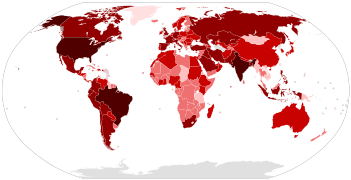
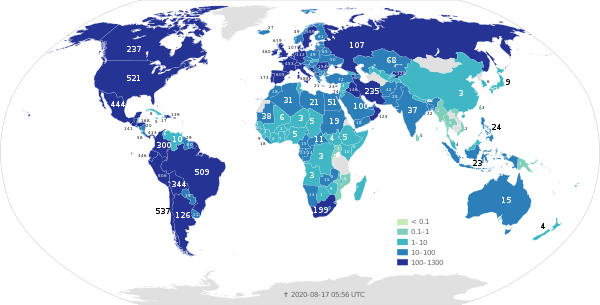
.jpg)
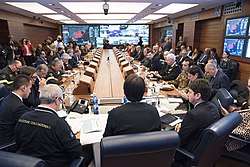
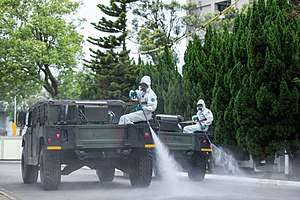

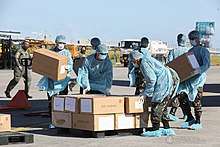

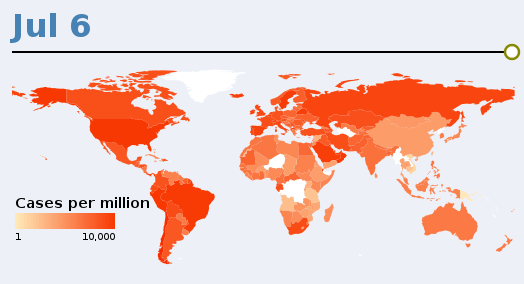


.jpg)